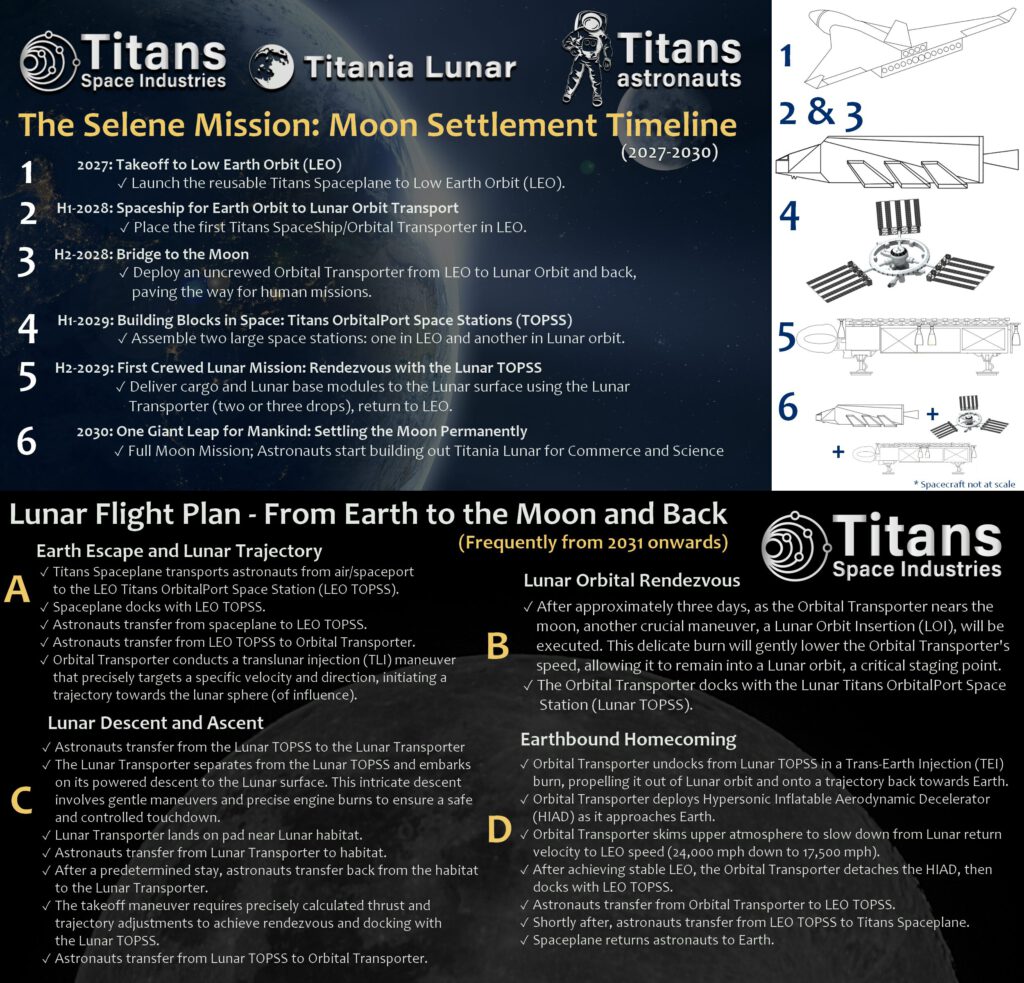Titans Space | Top 100 Frequently Asked Questions
Even though Titans Space operates in stealth mode (for the foreseeable future), given the size and scope of the announced projects, the Titans Space founding team deemed it prudent to answer the most frequently asked questions.
About Titans Space
About Space Tourism
About Titans Spaceplanes
About Ultra-Fast Earth P2P Travel
About Titans Engines Systems
About Lunar Missions
Titans Space FAQ
About Titans Space and their Business Model
This website concerns projects developed by Titans Spaceplanes & Space Technologies TSST and Titans Space Industries TSI (jointly referred to as Titans Space).

Even though both companies operate (for the foreseeable future) in stealth mode, given the size and scope of the announced projects, the Titans Space founding team deemed it prudent to answer the most frequently asked questions.
The main stars of our most immediate project, Titans Spaceplanes, were first envisioned for the large space tourism and orbital infrastructure projects that Titans Space Industries (TSI) is currently preparing, including its own commercial Space Station.
These projects require long-term routine operations comparable to commercial airline/ airfreight operations.
TSI was founded by a group of 15 partners with a combined 450 years of experience, representing investor interests in TSI.
The Titans founding team includes a PE fund manager who raised more than $6 billion in capital, a Hall-of-Fame NBA basketball legend, a next-gen telecom pioneer, a billion-dollar business strategist, a former Head of Business Development at Apple, a former KPMG New York Managing Director who advised on 100+ transactions, a multi-billion dollar project operations expert, the former CFO of a Formula One racing team and public listed companies.
Our Founding CEO, Neal S. Lachman, is a serial entrepreneur with 35 years of investment, business, space, technology, and telecom experience. He has been a space entrepreneur ever since 1994/1995 when he and two of his brothers applied and received three international digital satellite broadcast licenses. In 1992, he picked up the phone and started communicating with companies like PanAmSat. Neal and his brothers later founded Lachman Brothers Digital Communications and started working on pioneering Satellite Broadband. (Read what Google's AI, Bard, says about InternetHypergate, the pioneering satellite broadband company they launched in 1998.)
The Titans founding team has worked together for more than a combined 200 years on other projects. In 2020, the team halted all other projects to mainly focus on TSI’s space and directly related projects due to their time- and capital-intense nature.
TSI finalized its feasibility study and preliminary design review for its spaceplanes project in February 2023. The Critical Design Review was completed in July 2023 upon which the project entered the final analysis and design phase.
During the company's spaceplanes research, which lasted more than fifteen months, the team realized that TSI could dominate the space travel, space tourism, and space launch industries once the spaceplanes would be up and running.
Based on the staggering conclusions, the team decided to spin off the spaceplanes project into a separate company: Titans Spaceplanes & Space Technologies or TSST.
The Titans Space team has officially introduced their plans to the government in January 2024 and is currently preparing for the development of the spaceplanes and spacecraft in new factories in the USA.
This website (titansspace.com) concerns a mix of TSST and TSI projects.
The Titans Space projects are led by a team of aerospace and rocketry experts under the leadership of Founding CEO, Neal S. Lachman, and 40-year-veteran Franklin Ratliff, Founding CTO.
Read more about the Titans founding team on the Titans Universe website.
All companies and projects under the Titans Universe banner, including Titans Space Industries and Titans Spaceplanes & Space Technologies, are governed by the Titans Universe supervisory board.
As an extra precaution, the company's founders have agreed to form a separate Board of Integrity, Transparency, and Ethics (BITE), consisting of five individuals with an impeccable business track record.
The five members of the BITE have unlimited access to the company's records and financial dealings.
Read more about Titans BITE here.
Yes, our founding team is a true family where the majority of the 15 initial founders have worked together in one way or form on projects for at least 15 years, and some even since 1998/1999 when they founded InternetHyperGate, a pioneering satellite broadband company (which they are re-launching in 2025 as TitansN).
The founding team was brought together over the last 24 years by our Founding CEO, Neal S. Lachman, an outspoken serial entrepreneur who financed the first multi-hundred megabits per second satellite broadband pilot (in 1998) and pioneered Fiber to the Home.
Neal has been a space entrepreneur ever since 1994/1995 when he and two of his brothers applied for and received three international digital satellite broadcast licenses. In 1992, he picked up the phone and started communicating with companies like PanAmSat. (Read what Google's AI, Bard, says about InternetHypergate, the pioneering satellite broadband company they launched in 1998.)
Ever since, Neal has studied space-related developments and businesses, including rocketry and spaceplanes projects.
Neal's main fascination is with building a large mining colony on the Moon, starting from 2028; all current Titans Space projects are meant to help achieve this goal.
Most space companies go bankrupt or fail because of the lack of business acumen of their founders. The Titans founders are business experts who know how to run large businesses and projects.
The team has access to a global network of aerospace and rocketry experts and has the support of several consulting and advisory firms to assist in the many Titans projects.
Read more about the Titans founding team here.
There are two companies involved with our Space projects.
1: Titans Space Industries (TSI), which has a 15-person founding team that represents investor interests and has non-executive, supervisory roles.
2: Titans Spaceplanes & Space Technologies, a spin-off company from TSI. Twelve of TSI's founding partners went on to found TSST and have been joined by a number of aerospace, engineering, and rocketry experts.
Both companies, jointly referred to as Titans Space, are represented by Neal S. Lachman (CEO), Franklin Ratliff (CTO), and Farooq Malik, MBA (CFO).
The team has access to a global network of aerospace and rocketry experts and has the support of several consulting and advisory firms to assist in their many projects.
Read more about the Titans founding team here.
This website concerns projects developed by Titans Spaceplanes & Space Technologies and Titans Space Industries.
Both companies are operating in stealth mode but given the size and scope of the announced projects. the founders deemed it prudent to answer the most frequently asked questions.
Our future core business: Lunar Mining.
However, industrial-level mining on the Moon is, despite our huge upcoming efforts, some 10-15 years away.
All our projects are meant to support our ultimate objective to build and operate a large Lunar mining colony and to mine the Moon. This relates to building our proprietary infrastructure (ranging from spaceplanes that take off from a runway on Earth to spacecraft, to a lunar colony), as well as generating revenue (thanks to that infrastructure).
Titans Spaceplanes & Space Technologies (TSST) is focused on two segments:
1. Manufacturing spaceplanes, Space stations, and spacecraft for Titans Space Industries
2. Own and operate the commercial space launch business, once the Titans Spaceplanes become operational
This means that the remaining projects, including Space tourism, spaceplane/spacecraft operations (including leasing/operations/missions), on-orbit servicing (e.g. on-orbit assembly of spacecraft and on-orbit refueling), and lunar commerce, will be the responsibility of Titans Space Industries (TSI).
TSI is partly funded by Titans Astronauts, a group of ultra-high-net-worth individuals who pay the company $25-35 million for a lifetime space travel membership, and as such, the company is currently primarily focusing on the Space tourism aspect.
TSI is also responsible for all operational aspects of TSST, including business development, sales and marketing, and strategy.
Our immediate core business: Space Tourism
Titans Space's immediate focus with its revolutionary Spaceplanes is to make affordable Space tourism possible on a large scale, with prices for Sub-Orbital Zero-G flights starting at just $25,000, and Orbital Cruises starting at $200,000.
For more information about Titans Space Tourism, please click here, or to read our answers to FAQs pertaining to our Space Tourism offers, please click here.
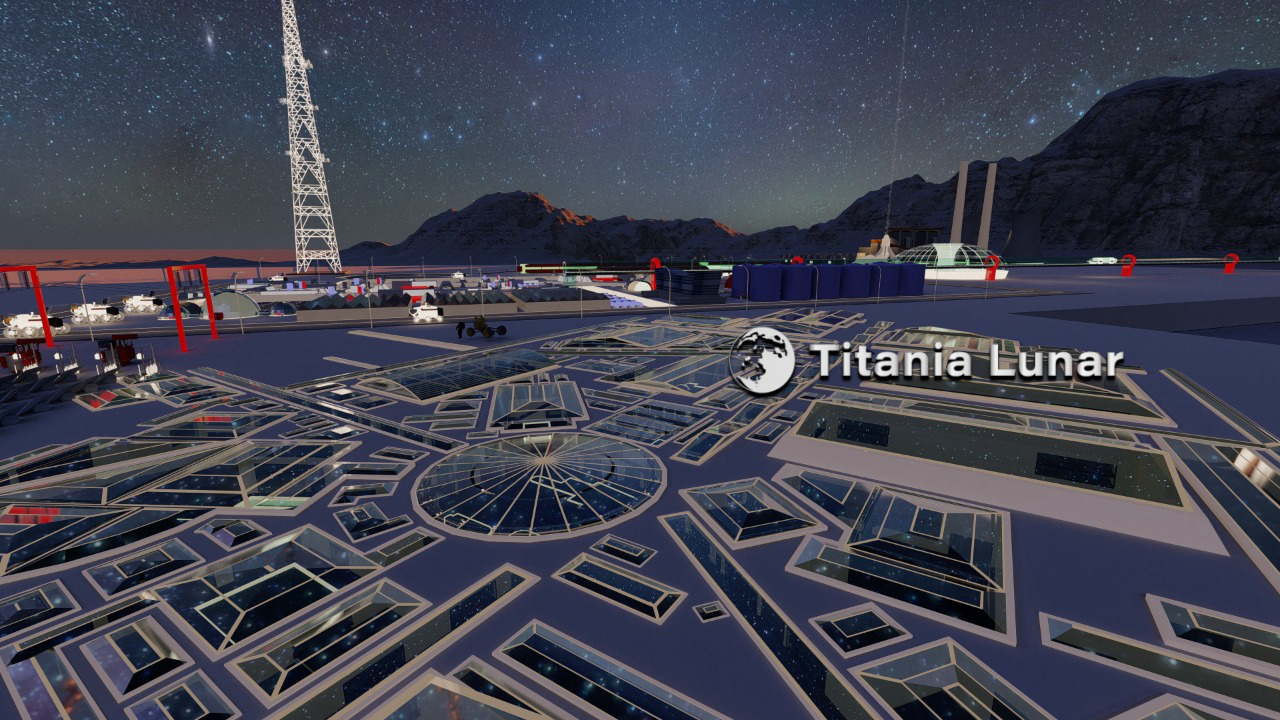
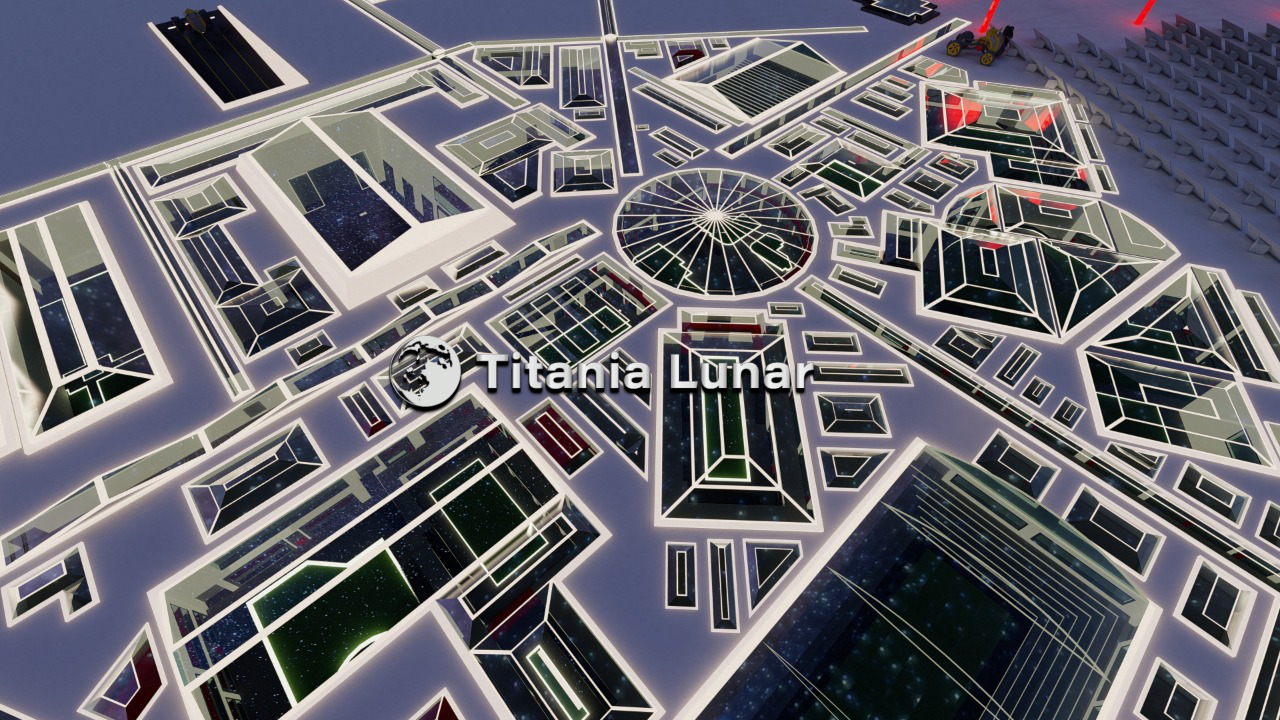
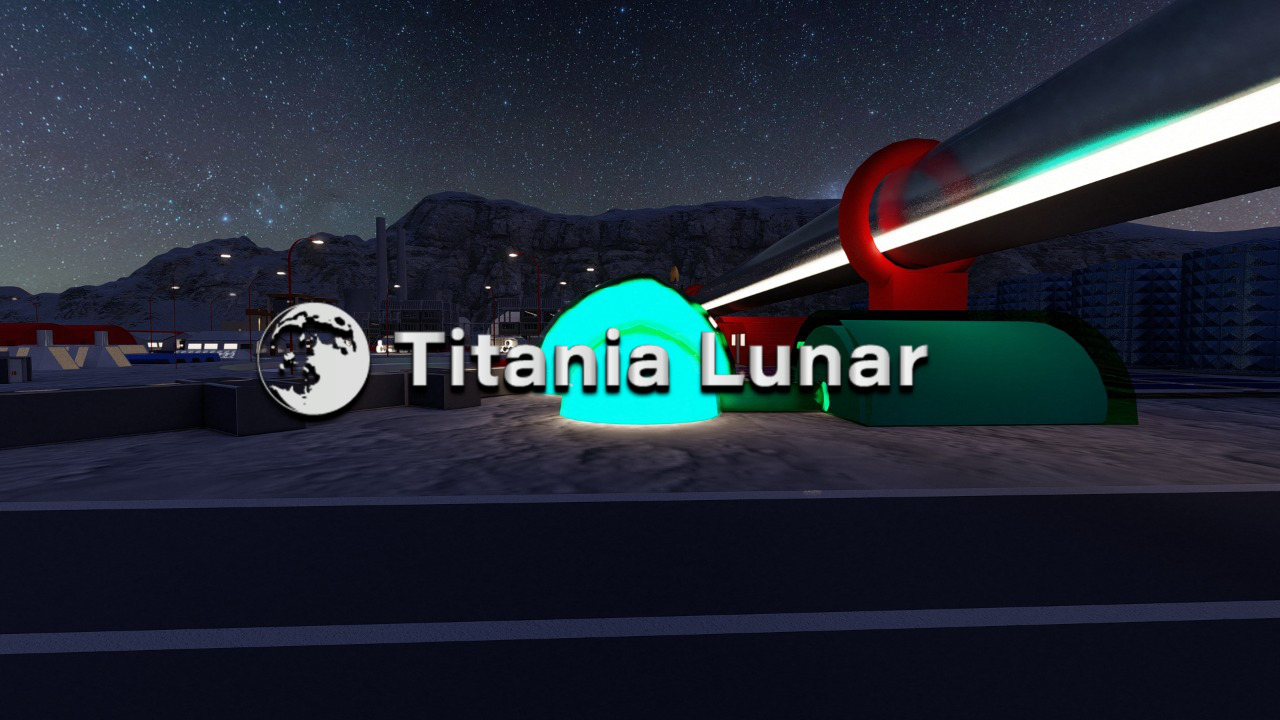
The short answer is: because we have a significantly easier way to travel to the Moon, and because we can deliver virtually unlimited cargo to the Moon from Earth and Low-Earth Orbit - something no other company can accomplish.
Titans Space Industries (TSI) was founded with lunar mining and industrialization of the Moon as the company's main objective.
The long answer:
Currently, all Space travel and space launch missions are severely restricted because there is only one way to go to space (and to the Moon and further): Rockets.
Most Space projects depend on government grants and/or contracts while TSI is fully independent and gets its revenues from multiple sources.
This is where the Titans end-to-end Space transportation systems (consisting of reusable spaceplanes, spaceships, space stations, and lunar transporters) bring about a revolutionary paradigm shift.
The Titania Lunar Colony will start small and in a very basic configuration, but it will continue to expand.
The main differences between our lunar colony and other Moon base plans are rooted in the fact that we own our own end-to-end (Earth surface to Lunar surface and vice versa) Space transportation infrastructure.
We will build modules for the lunar colony on Earth, then transport them from Earth to LEO with a Titans Spaceplane, and then launch them to Lunar orbit or transfer them to a Titans SpaceShip that will transport the modules to the Lunar Titans OrbitalPort Space Station (Lunar TOPSS). The Lunar Transporter will deliver the modules to the Lunar surface.
Fun fact: our lunar colony will have its own mass driver that will launch cargo to Earth (once we get nuclear power up and running).
Read more about the Titans Lunar Orbital Hotel here.
Read more about the Titania Lunar Colony here.
TSI is partly funded by Titans Astronauts, a group of ultra-high-net-worth individuals who pay the company $25-35 million for a lifetime space travel membership, and as such, the company is currently primarily focusing on the Space tourism aspect.
Titans Astronauts also represent the largest ownership block, while the founding partners (minus Founding CEO, Neal S. Lachman), represent the second largest ownership block in terms of representing investor interests.
(Fun fact about our Titans Astronauts target market: did you know there are 25,500 centi-millionaires and almost 400,000 UHNWIs in the world?)
Our anchor customers are called Titans Astronauts, a group of ultra-high-net-worth individuals who pay the company $25-35 million for a lifetime space travel membership, and as such, the company is currently primarily focusing on the Space tourism aspect.
Titans Astronauts also represent the largest ownership block, while the founding partners (minus Founding CEO, Neal S. Lachman), represent the second largest ownership block in terms of representing investor interests.
(Fun fact about our Titans Astronauts target market: did you know there are 25,500 centi-millionaires and almost 400,000 UHNWIs in the world?)
We are currently negotiating strategic developments and partnerships with Space agencies, governments, and the military. These developments are part of our stealth operations, and due to their confidential nature, we will not disclose further information.
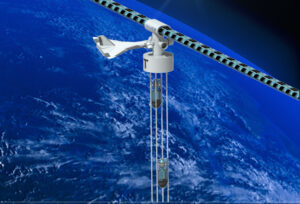
The majority of TSI/Titans Space Industry's founding team believes that orbital rings and space elevators should be part of our future Space development program.
However, after much consideration, those projects have been put on hold for the foreseeable future in order to focus on the projects listed on the TSI website.
The Titans Spaceplane is a kind of airplane with a propulsion system and heat shielding that allows it to operate in the vacuum of space and to reenter Earth's atmosphere.
The Titans Spaceplane is the first spaceplane to take off from a runway like an airplane.
Besides being used for safe, frequent, and efficient Space transport (flights/travel and launches), Titans Spaceplanes allow for solutions that are (and may always be) impossible with vertically launched rocket vehicles.

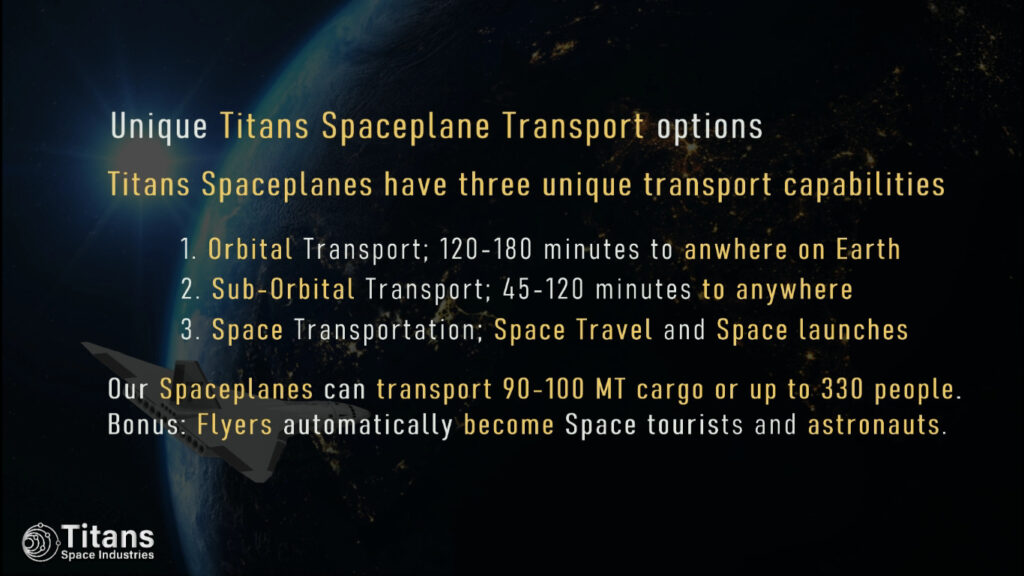
Orbital Transport
✓ Orbital Trajectory: Ascend to orbit followed by 1.5 or two orbits until the vehicle is within range of the destination airfield
✓ Pin-Point Exact Delivery: Titans spaceplanes can deliver anywhere, from rural areas to deserts, or to a ship or submarine at sea.
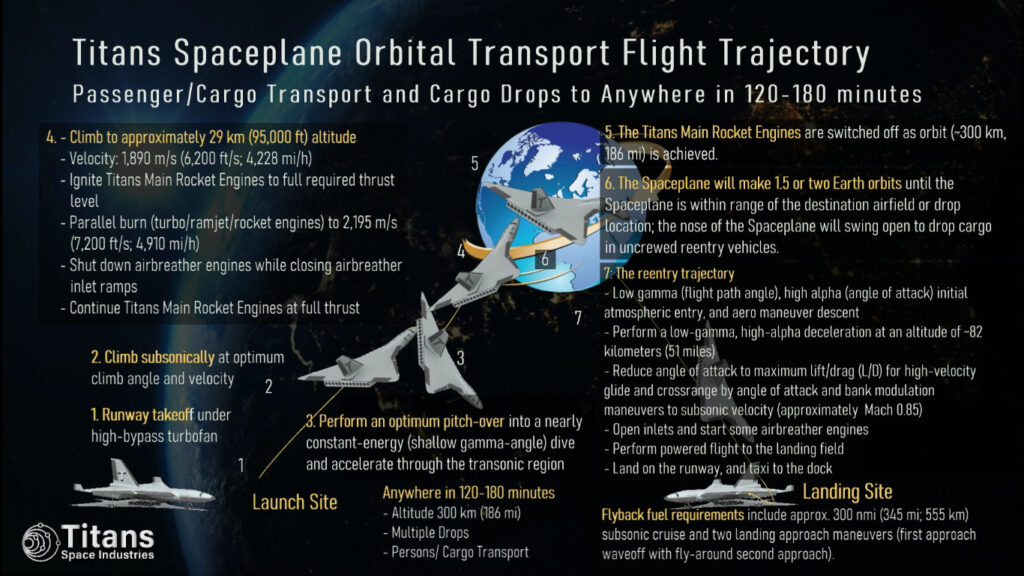
✓ Titans Spaceplanes can transport cargo and passengers directly to and from any large airport in the world
✓ Flight duration: 120-180 minutes to any drop location - (view orbital flight trajectory)
✓ Delivery to remote outposts
✓ No forward bases required (for military cargo drops)
The Titans spaceplanes can stay in orbit and deploy uncrewed reentry capsules, making precision landings under parafoil. Utilizing low-cost, single-use reentry capsules expands the Titans spaceplane's cargo delivery and disaster relief capabilities to missions where a suitable airfield is not available, such as in remote or rural areas.
For more information, please visit the Orbital Transport section.
Sub-Orbital Transport
Transport personnel and cargo anywhere in less than 90 Minutes - faster than hypersonic transport.
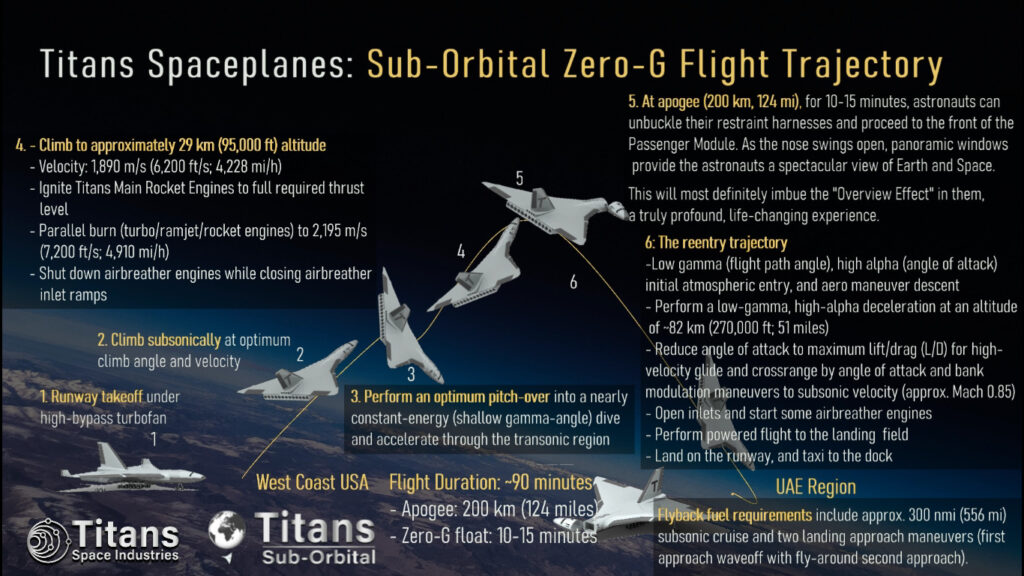
✓ Sub-Orbital Trajectory (arc)
✓ Flight time: 90-120 minutes to any location
✓ Ascend through a suborbital ballistic arc where the vehicle flies outside the atmosphere but stays below orbital velocity
Different from orbital flights, when utilizing a ballistic arc trajectory, Titans vehicles do not achieve orbital velocity. Instead, the vehicle climbs out of the atmosphere at speeds below orbital velocity.
The vehicle will ascend to approximately 200 kilometers (apogee), and continue its descent to the destination airport or spaceport.
For more information, please visit the Sub-Orbital Transport section
Ultra-Fast Travel
Travel Anywhere in 90-120 Minutes. Beyond Concorde; Capable of Space Transport.
Titans Spaceplane flyers will travel in luxurious style and have their individual Spacepods inside the cabin.
Most destinations are estimated to be reached within 90 minutes, from take-off to landing.
Rocket lift-off requires passengers to remain in a reclined position, strapped into their seats; Titans passengers will experience airplane-like comfort and ease.
✓ Sub-Orbital Trajectory (arc)
✓ Flight time: 90-120 minutes to any location - Faster than Hypersonic Travel
✓ Ascent through a suborbital ballistic arc where the vehicle flies outside the atmosphere but stays below orbital velocity
✓ Land at any large airport: The vehicle can land at any contracted airport.
The rocket engines are switched off as our desired altitude (200 kilometers) is achieved. At that moment, for 10-15 minutes, the astronauts can unbuckle their restraint harnesses and proceed to the front of the Passenger Module.
The windows and viewing cupola provide the flyers with a spectacular view of Earth and Space. After approximately 10-15 minutes in space at zero-g, the astronauts return to their seats and buckle in for reentry and landing. The vehicle will ascend to approximately 200 kilometers (apogee), and continue its descent to the destination airport or spaceport.
The ultra-fast travel experience is identical to the Sub-Orbital Zero-G flight experience.
For more information, please visit the Ultra-Fast Travel section.
Other unique Applications
A dream come true for military and government agencies
Titans Space is investigating the potential for a spaceplane to change orbital inclination while already in orbit by diving into the upper atmosphere, banking to change direction, then reboosting itself back into orbit in a new inclination. This could, for example, allow during the same flight deployment of satellites to different orbital inclinations.
Titans Spaceplanes will also have the capability of rapid response deployment of assets to orbit. For example, with short notice, a Titans Spaceplane can carry a surveillance asset into orbit in its cargo bay, deploy the asset over the target area, then recover the asset and return it to the landing site.
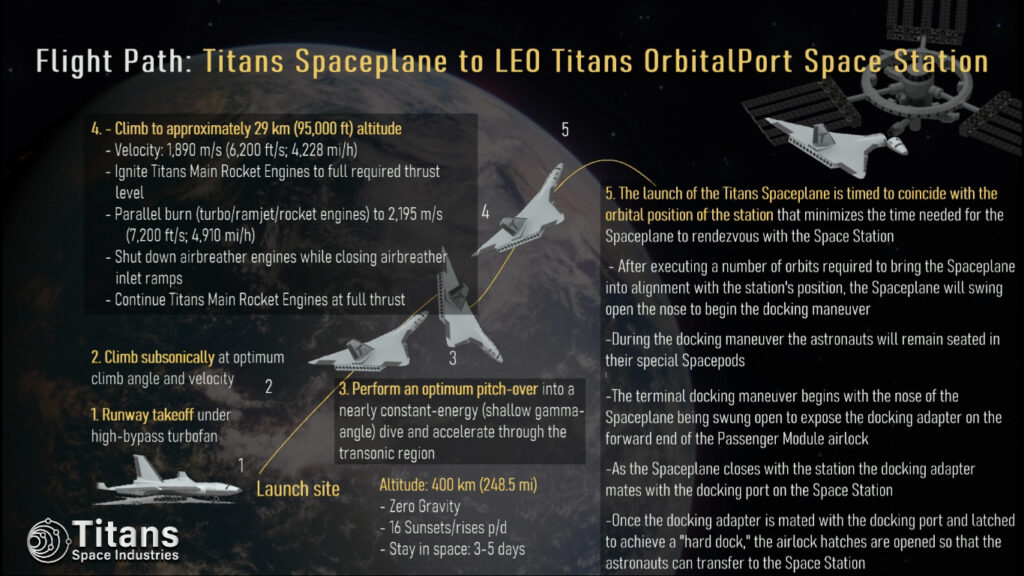
No, we do not sell anything that we build and/or develop.
We will lease Titans Spaceplanes to certain third parties, but that side of our business is confidential.
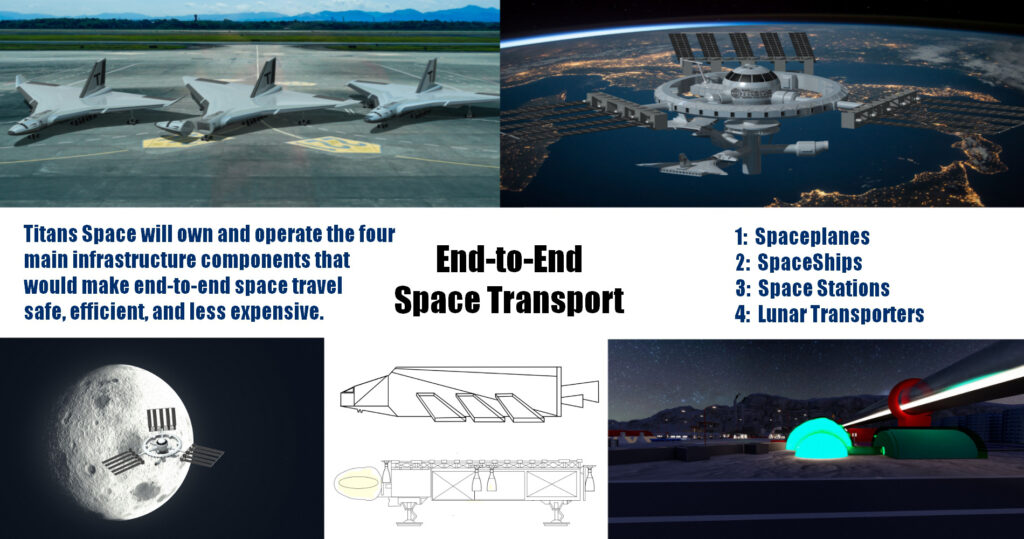
The short answer: We will own and operate an end-to-end Space transportation infrastructure that we operate completely independently.
Furthermore, our primary customer base consists of Titans Astronauts, which allows us to invest in several capital-intensive projects simultaneously.
And last, but not least: Because of its financial independence, Titans Space doesn't require government (agency) grants/contracts/funding, which are inherently lengthy and cumbersome processes.
The long answer:
Currently, all space travel and space launch missions are severely restricted because there is only one way to go to space (and to the Moon and further): Rockets.
This is where the Titans Space transportation systems (consisting of reusable spaceplanes, spaceships, Space stations, and lunar transporters) bring about a revolutionary paradigm shift.
The main differences between our Space projects and others are rooted in the fact that we own and operate our proprietary end-to-end (Earth surface to Lunar surface and vice versa) space transportation infrastructure.
For example: we will build modules for the lunar colony on Earth, then transport them from Earth to LEO with our own spaceplanes and then launch them to Lunar orbit, or transfer them to Titans SpaceShips that will transport the modules to the Lunar Titans OrbitalPort Space Station (Lunar TOPSS). The Lunar Transporter will deliver the modules to the Lunar surface.
Learn more about the Titans Lunar Orbital Hotel here.
Learn more about the Titania Lunar Colony here.
We also compete in terms of scale and price of our Space Tourism offers.
Titans Space's immediate focus with its revolutionary Spaceplanes is to make affordable Space tourism possible on a large scale, with prices for Sub-Orbital Zero-G flights starting at just $25,000, and Orbital Cruises starting at $200,000.
For more information about Titans Space Tourism, please click here, or to read our answers to FAQs pertaining to our Space Tourism offers, please click here.
The short answer:
Titans Space is the only company in the world that will own and operate the four main infrastructure components that can make end-to-end space travel safe, efficient, and less costly.
In the near future, you will arrive at a particular Titans spaceport, and a few days later you will step on the lunar surface to spend a few days at the Titania Lunar Resort.
The long answer:
Currently, all space travel and space launch missions are severely restricted because there is only one way to get off planet Earth (and go to the Moon and further): Rockets.
This is where the Titans Space transportation infrastructure brings about a revolutionary paradigm shift.
The four main Titans Space infrastructure components are:
1: Spaceplanes
2: Spaceships
3: Space Stations
4: Lunar transporters
The main differences between our space projects and others is rooted in the fact that we own and operate our proprietary end-to-end (Earth surface to Lunar surface and vice versa) space transportation infrastructure.
For example, something that's presently beyond imagination for most people: visiting the Moon.
In the near future, you will be able to get on a Titans Spaceplane, then transfer in Low-Earth Orbit to a Titans SpaceShip that will transport you to the Lunar Titans OrbitalPort Space Station in about three days, and the Titans Lunar Yacht Transporter will deliver you to the Titania Lunar Resort.
Read more about the Titans Space Transportation infrastructure here.
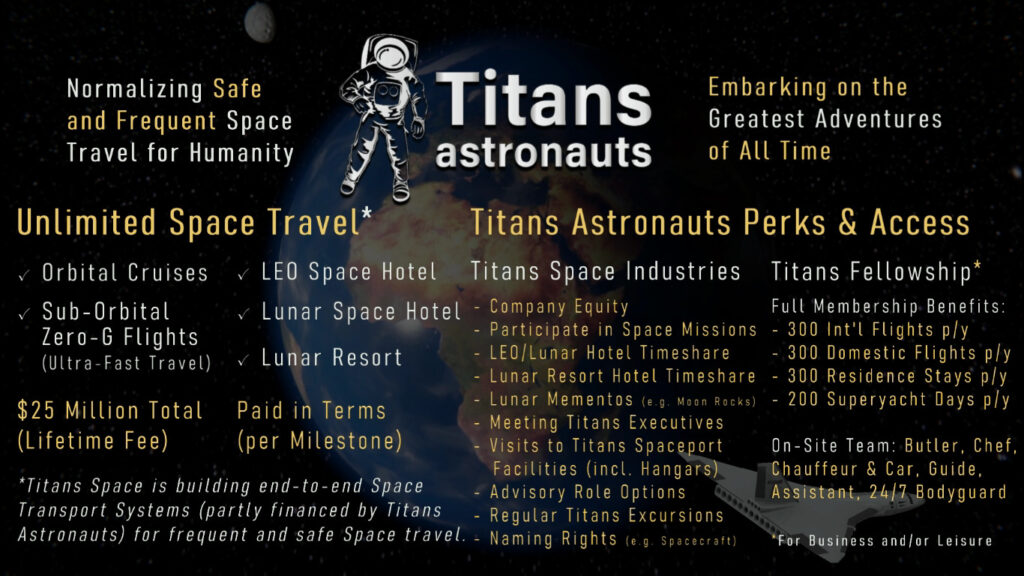
Titans Space is partly funded by Titans Astronauts, a group of ultra-high-net-worth individuals who pay the company $25-35 million for a lifetime (practically unlimited) Space travel membership.
Their unique role at Titans Space makes Titans Astronauts the greatest adventures of all time. They are the first true colonizers of Space.
(Fun fact about our Titans Astronauts target market: did you know there are 25,500 centi-millionaires and almost 400,000 UHNWIs in the world?)
Besides unlimited access to Space, Titans Astronauts are also afforded a two-year exclusive access window to practically all Titans missions and projects such as the LEO Space Hotel, Lunar Orbital Hotel, and the Titania Lunar Resort. The two-year exclusivity kicks in at the operational start of a particular project.
Titans Astronauts also represent the largest ownership block, while the founding partners (minus Founding CEO, Neal Lachman), represent the second largest ownership block in terms of representing investor interests.
More information about Titans Astronauts is available in the Titans Astronauts FAQ section, below or for more information:
While Titans Astronauts have a lifetime space travel membership that gives them unlimited (fair use) access to practically all Titans missions and projects, Guest Astronauts are customers who partake in individual, separate programs, for example as flyers on the Orbital Cruise.
Also, while Titans Astronauts have a two-year exclusive access window to certain projects, like the LEO Space Hotel, Lunar Orbital Hotel, and the Lunar Resort, Guest Astronauts are next in line to get an opportunity for these unique destinations.
(Fun fact about our Guest Astronauts target market: did you know there are 25,500 centi-millionaires and almost 400,000 UHNWIs in the world?)
More information about Guest Astronauts is available in the Astronauts FAQ section, below.
We believe in ethical business practices. We are aware that all life, human or other animals, is precious and unique.
Titans Space will adhere to the Ten Principles of the UN Global Compact.
To illustrate an explicit example of our business ethics:
Zero-gravity research is limited and very expensive. With the Titans Spaceplanes and spacecraft, we can orbit and thus allow research at zero-g for 10-15 minutes, a few hours, or even days on end.
We will select certain non-profit medical research institutes to conduct their research on our spaceplanes, fully sponsored by Titans Space, Titans Astronauts, and certain other sponsors.
We'd love to see medicine development where we have played a little role. Maybe you'll be using some medicines in the future that were researched on one of our spacecraft!
This is just one of the immediate ways Titans will be contributing to a better world.
Furthermore, all companies and projects under the Titans Universe banner, including Titans Space Industries and Titans Spaceplanes & Space Technologies, are governed by the Titans Universe supervisory board.
As an extra precaution, Titans Universe's founders have agreed to form a separate Board of Integrity, Transparency, and Ethics (BITE), consisting of five individuals with an impeccable business track record.
The five members of the BITE have unlimited access to the company's records and financial dealings.
Read more about Titans BITE here.
Yes, we recently started hiring.
We have opportunities for all kinds of specialisms, ranging from former astronauts to aerospace specialists (e.g. aerodynamics, CFD, rocketry), to industrial designers.
Please use the contact form on the Titans Universe website to get in touch.
We are currently considering establishing a special advisory board for former astronauts and Space agency officials.
We will offer advisory board members most of the perks that Titans Astronauts are afforded, including multiple flights to Space.
Please get in touch with us to discuss opportunities.
Read more about the Titans founding team here.
Yes, peruse our website to find a specific area of expertise or interest.
We have opportunities for all kinds of small businesses and entrepreneurs, ranging from former astronauts to aerospace specialists (e.g. aerodynamics, CFD, rocketry), to industrial designers.
As long as you're willing to sign a mutual NDA, we will investigate mutual opportunities.
Please use the contact form on the Titans Universe website to get in touch.
Please, peruse our websites (titansspace.com and titansu.com) to find specific areas of your expertise or interest.
We have opportunities for all kinds of businesses, ranging from former astronauts to aerospace specialist firms (e.g. aerodynamics, CFD, rocketry), to industrial design.
As long as you're willing to sign a mutual NDA, we will investigate mutual opportunities.
Please use the contact form on the Titans Universe website to get in touch.
While we operate in stealth and rarely give interviews or presentations, we would love to help educators get their students interested in space.
In the very near future, we will select educators for a Guest Astronauts experience, fully sponsored by Titans Space, Titans Astronauts, and certain other sponsors.
Reach out to us, and who knows, maybe the CEO and/or CTO can give a tailor-made presentation to your class and answer all relevant questions.
Affordable Space Tourism
Titans Space's immediate focus with its revolutionary Spaceplanes is to make affordable Space tourism possible on a large scale, with prices for Sub-Orbital Zero-G flights starting at just $25,000, and Orbital Cruises starting at $200,000.
For more information about Titans Space Tourism, please click here, or to read our answers to FAQs pertaining to our Space Tourism offers, please click here.
Our long-term objective
TSI, with support from the Titans Space Society and Titans Astronauts, paves the way for millions of people to become space tourists, and maybe even visit the Titania Lunar Colony.
The Titans Space Society is a closed fellowship that is reserved for Titans Astronauts, a group of wealthy well-wishers of humanity who are essential to the realization of Titans Space projects, including spaceplanes, spaceships, Space stations, and a large Lunar colony.
For the time being, Titans Space missions and/or projects are only accessible to Titans Astronauts and Guest Astronauts.
We will work with Titans Astronauts and sponsors to provide select individuals access to certain Titans Space missions and/or projects.
Follow us on social media to keep up to date, or use the contact for to get in touch.
FAQs for Titans Astronauts, Guest Astronauts, and Launching Astronauts

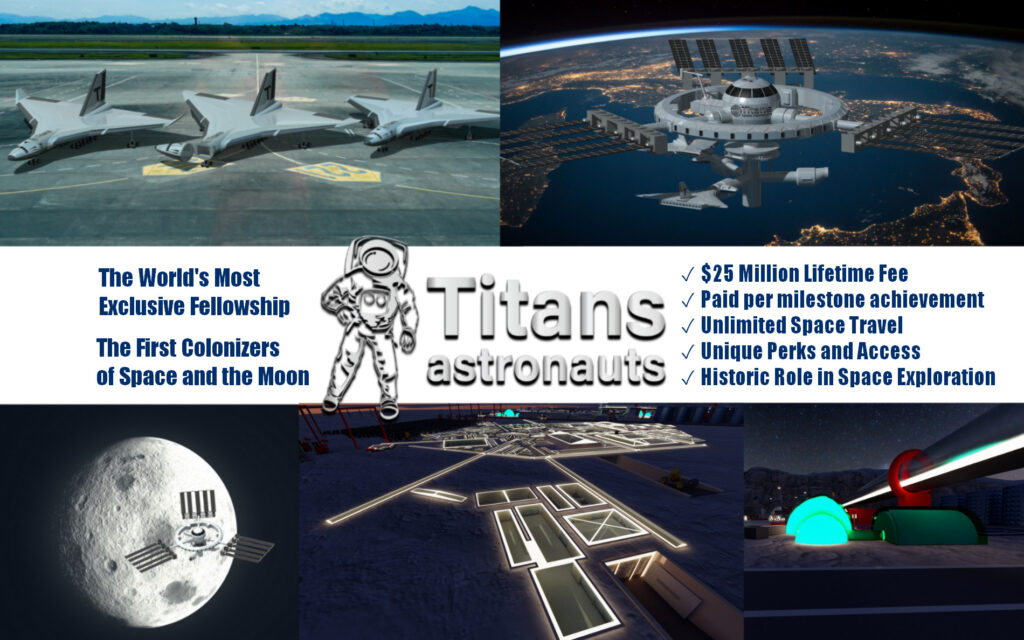
Titans Space is are partly funded by Titans Astronauts, a group of ultra-high-net-worth individuals who pay the company $25-35 million for a lifetime Space travel membership.
While Titans Astronauts have a lifetime membership that gives them unlimited (fair use) access to practically all Titans missions and projects, Guest Astronauts are VIP customers who partake in individual, separate programs, for example as flyers on the Orbital Cruise.
Also, while Titans Astronauts have a two-year exclusive access window to certain projects, like the LEO Space Hotel, Lunar Orbital Hotel, and the Lunar Resort, Guest Astronauts are next in line to get an opportunity for these unique destinations.
Titans Astronauts also represent the largest ownership block, while the founding partners (with the exception of Founding CEO, Neal Lachman), represent the second largest ownership block in terms of representing investor interests.
Watch the full Titans Astronauts video here.
(Fun fact: did you know there are 25,500 centi-millionaires and almost 400,000 UHNWIs in the world? They are part of our primary target market.)
The first 500 individuals booking a Sub-Orbital Zero-G Flights or Orbital Cruise will become Launching Astronauts, affording them special perks.
(Fun fact: did you know there are 25,500 centi-millionaires and almost 400,000 UHNWIs in the world? They are part of our primary target market.)
Learn more about the Launching Astronauts here.
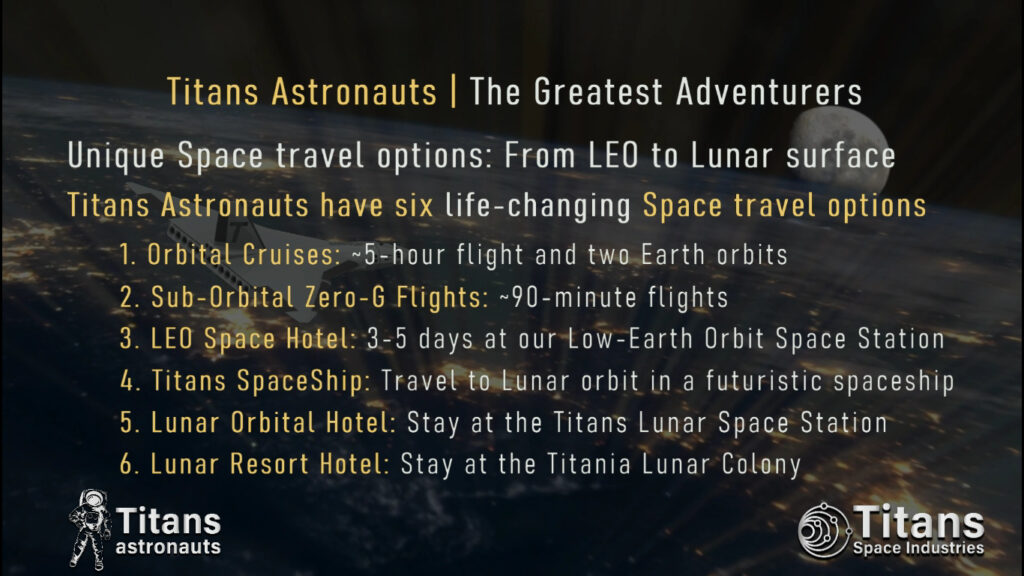
Titans Astronauts are co-owners of our companies as well as our anchor customers, and as such they are of incredible importance to us.
The benefit of operating our own reusable spaceplanes, spacecraft, Space stations, and Lunar colony means that we can provide the most unique experiences practically as often as a Titans Astronaut desires.
As long as it's on a fair-use basis, we will accommodate Titans Astronauts' Space travel demands, including, but not limited to:
- Sub-Orbital Zero-G Flights
- Ultra-Fast Travel
- Orbital Cruises
- LEO Space Hotel
- Titans SpaceShips
- Lunar Orbital Hotel
- Lunar Resort
Most Titans projects are developed with the ultimate benefit and comfort of Titans Astronauts in mind. Present and future projects and developments will be coordinated with Titans Astronauts- this includes the Titans Astronauts Training Resort as well as the Titans Facilities at our spaceport locations.
For more information:
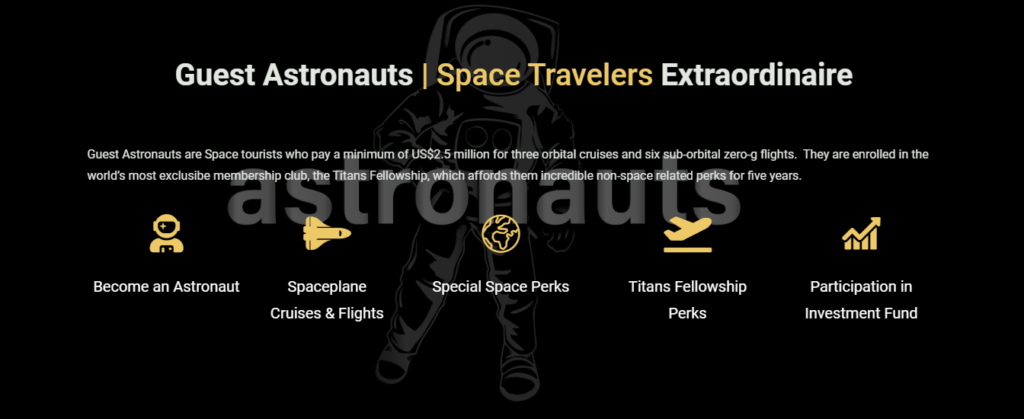
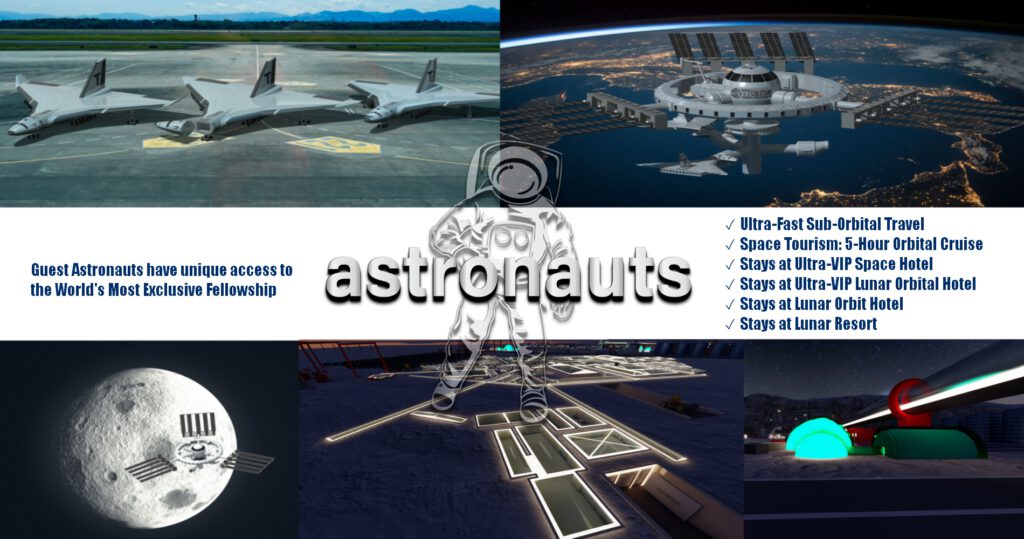
Guest Astronauts can enjoy almost all benefits and privileges afforded to Titans Astronauts, with the exception of exclusive access, certain perks, and the fact that Guest Astronauts pay on a per-project/per-mission basis, or as Titans Fellows. Titans Astronauts have practically unlimited access to all Titans missions and projects for life.
The benefit of operating our own reusable spaceplanes, spacecraft, space stations, and a Lunar colony means that we can provide the most unique experiences on a (near) daily basis.
Guest Astronauts have immediate access to Sub-Orbital Zero-G Flights and Orbital Cruises once the missions launch, and they are second in line (prior to the rest of the public) to visit the LEO Space Hotel, the Lunar Orbital Hotel, and the Titania Lunar Resort.
Most Titans projects are developed with the ultimate benefit and comfort of Titans Astronauts in mind. Present and future projects and developments will be coordinated with Titans Astronauts - this includes the Titans Astronauts Training Resort as well as the Titans Facilities at our spaceport locations.

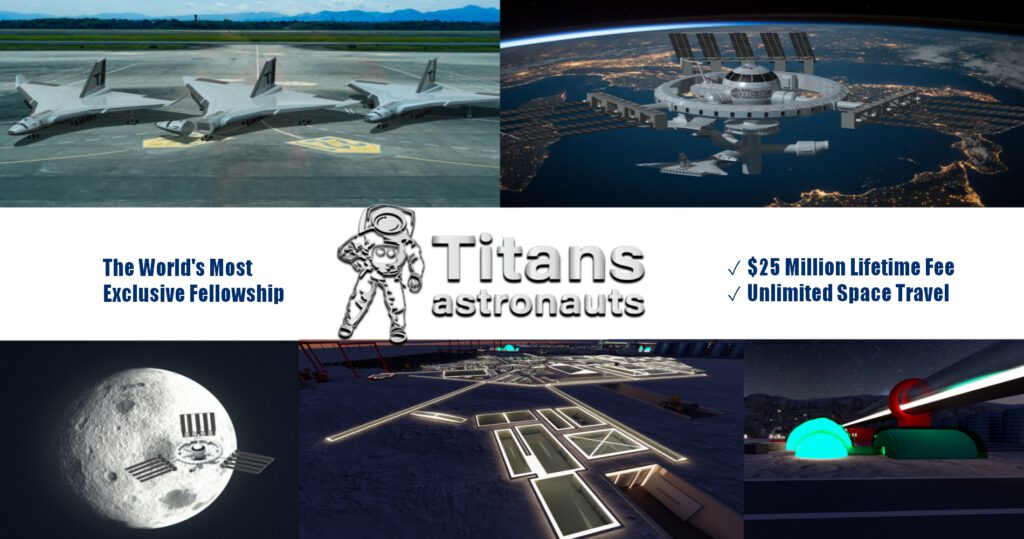
As explained in the "About Titans Space" section, our ultimate core business is to establish a Lunar mining colony to industrialize and mine the Moon within the next 10-15 years.
As founding citizens of Titania Lunar, Titans Astronauts will be recognized as the first true colonizers of space.
Titans Astronauts are our anchor customers and treated as co-owners of our companies, and as such, they are basically part of all our developments.
Titans Astronauts have a non-binding advisory role, and they can be involved with our projects and missions if they wish so.
Titans Astronauts are afforded many unique perks, including but not limited to:
- Timeshare ownership of an apartment at the upcoming Titans Training Resort
- Unlimited Ultra-Fast Travel for the Titans + 1 (on a fair use basis)
- Unlimited Orbital Cruises (once per year with 1 guest)
- Timeshare ownership of a Titans Suite on the LEO Space Hotel (biennial with one guest)
- Timeshare ownership of a Titans Suite on the Lunar Orbital Hotel (quinquennial with one guest)
- Timeshare ownership of a Titans Suite on the Lunar Resort
- Naming rights of structures, buildings, streets, etc. on Titans properties (on Earth, in space, and on the Moon)
- Much more... Contact us through the Titans Astronauts Contact Form if you are interested (we will provide confidential information upon qualification).
Titans Astronauts are of incredible importance to us.
The benefit of operating our own reusable spaceplanes, spacecraft, Space stations, and a Lunar colony means that we can provide the most unique experiences practically as often as a Titans Astronaut desires.
Most Titans projects are developed with the ultimate benefit and comfort of Titans Astronauts in mind. Present and future projects and developments will be coordinated with Titans Astronauts, including the Titans Astronauts Training Resort as well as the Titans Facilities at our spaceport locations.
But we also have incredible non-space-related perks for Titans Astronauts!
- Titans Astronauts automatically become Titans Astronauts Fellows, gaining access to the Royal Rhodium membership tier, providing instant access to the world's most exclusive membership club with incredible perks.
For more information:
- Visit the Titans Astronauts page
- Visit the Titans Astronauts Fellowship intro page
- Visit the Titans Astronauts Fellowship perks overview page
- Watch the full Titans Astronauts video here.


Yes, we have incredible perks for Guest Astronauts!
- Guest Astronauts who book Space tourism trips with a value of $2.5 million or more with us receive a Titans Fellowship membership (Presidential - Platinum), providing instant access to the world's most exclusive membership club with incredible perks.
For more information:
- Visit the Guest Astronauts page
- Visit the Guest Astronaut Fellowship intro page
- Visit the Guest Astronauts Fellowship perks overview page
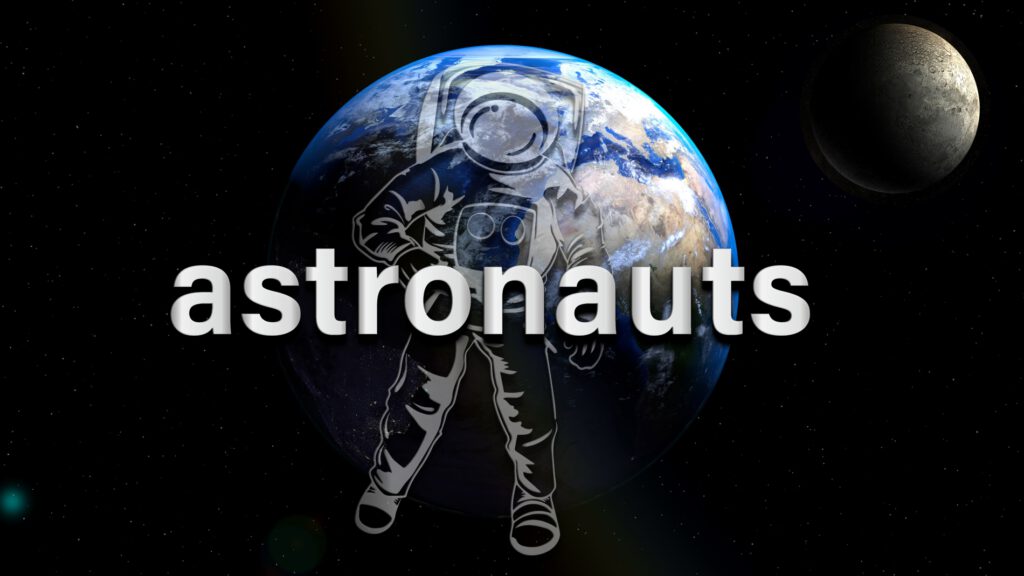
Titans Astronauts have no need to upgrade since there is no higher level of fellow memberships available.
Because of the high "sunk cost" per Titans Astronaut, we do not allow downgrades.
Guest Astronauts pay on a per-mission/per-project basis. They can upgrade to a full Titans Astronauts Fellow membership.
Because of the high "sunk cost" per Titans Astronaut, we will only consider upgrades under the condition of an additional initiation payment of $2.5-$5 million, which will be determined on a per-person basis.
TSI, with support from the Titans Space Society and Titans Astronauts, paves the way for millions of people to become Space tourists and maybe even visit our Titania Lunar colony.
The Titans Space Society is a closed fellowship that is reserved for Titans Astronauts, a group of wealthy well-wishers of humanity who are essential to the realization of Titans Space Industries projects, including spaceplanes, spaceships, Space stations, and a large lunar colony.
For the time being, Titans Space missions and/or projects are only accessible to Titans Astronauts, Guest Astronauts, and Titans Fellows.
We will work with Titans Astronauts and sponsors to provide select individuals access to certain Titans Space missions and/or projects.
Affordable Space Tourism
Titans Space's immediate focus with its revolutionary Spaceplanes is to make affordable Space tourism possible on a large scale, with prices for Sub-Orbital Zero-G flights starting at just $25,000, and Orbital Cruises starting at $200,000.
For more information about Titans Space Tourism, please click here, or to read our answers to FAQs pertaining to our Space Tourism offers, please click here.
Follow us on social media to keep up to date.
About Titans Rocket Engines
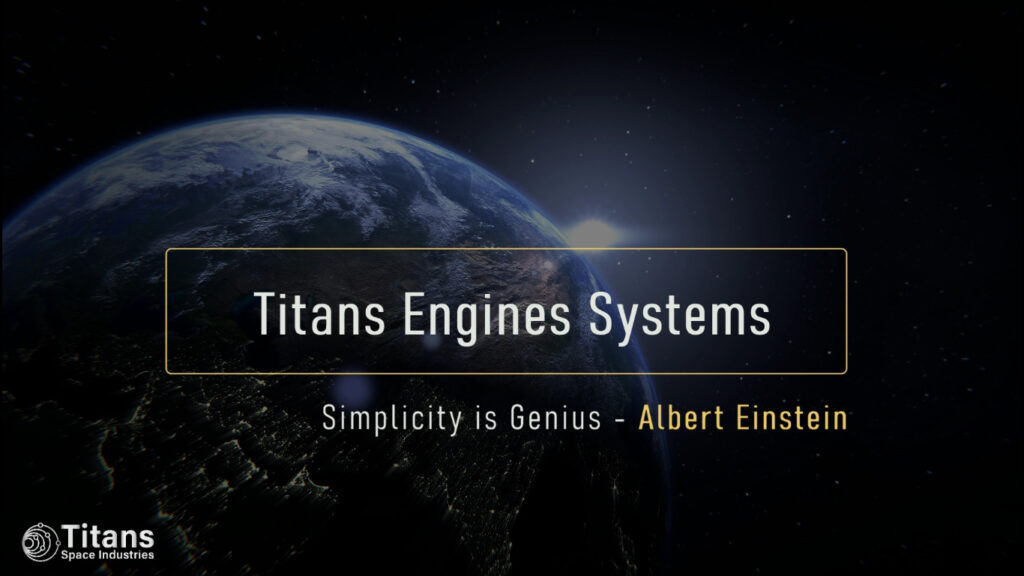
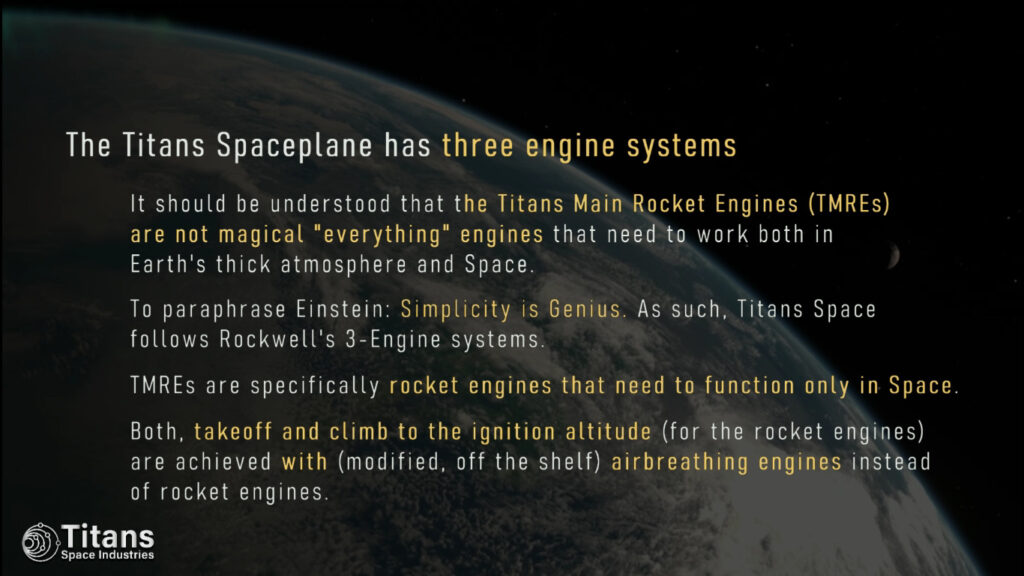
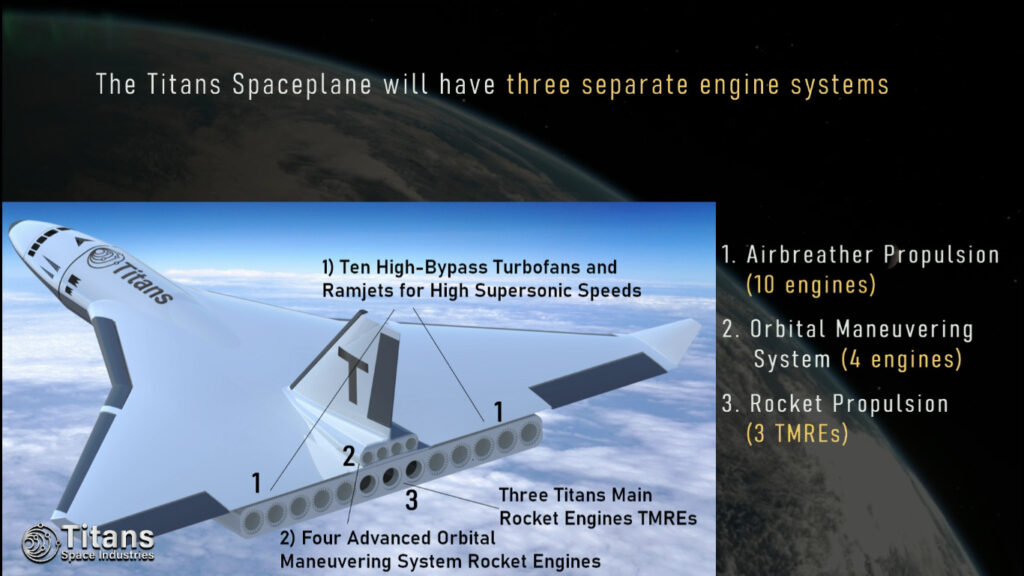
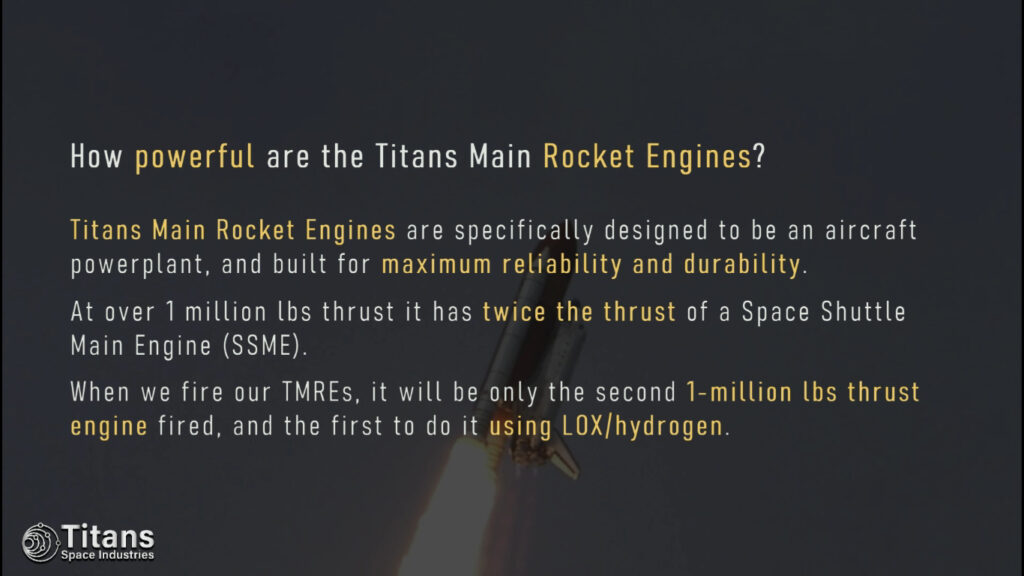
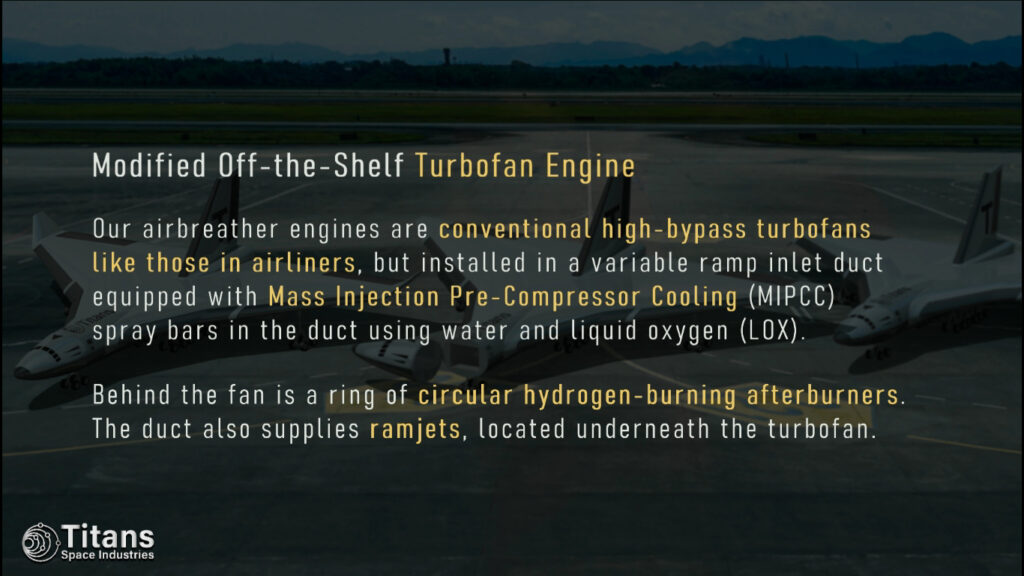
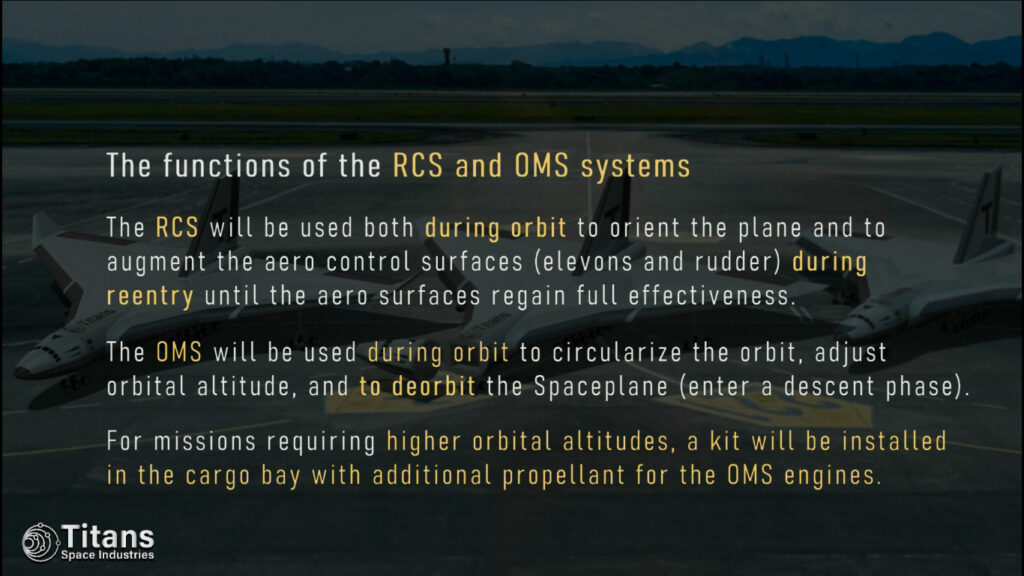
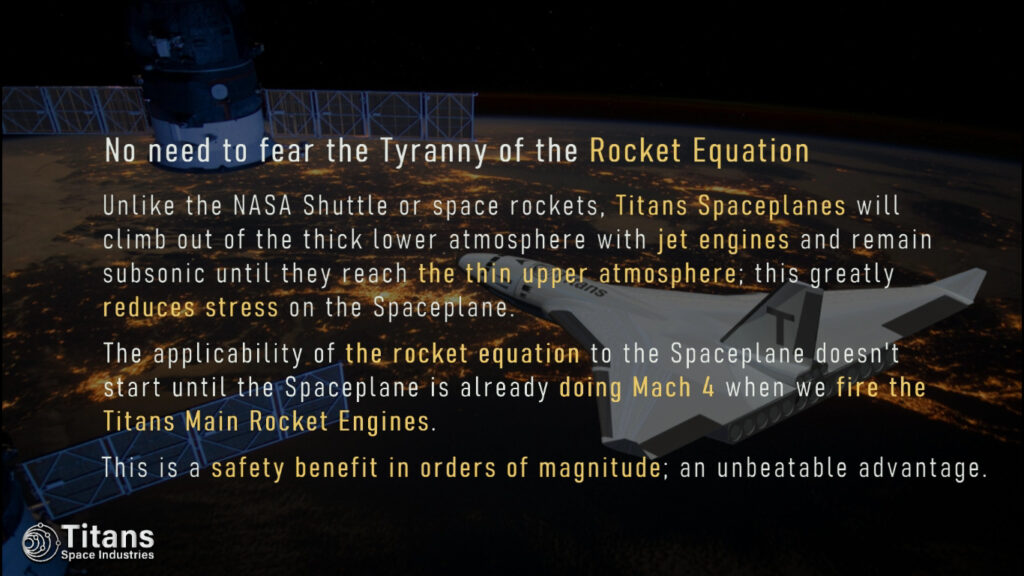
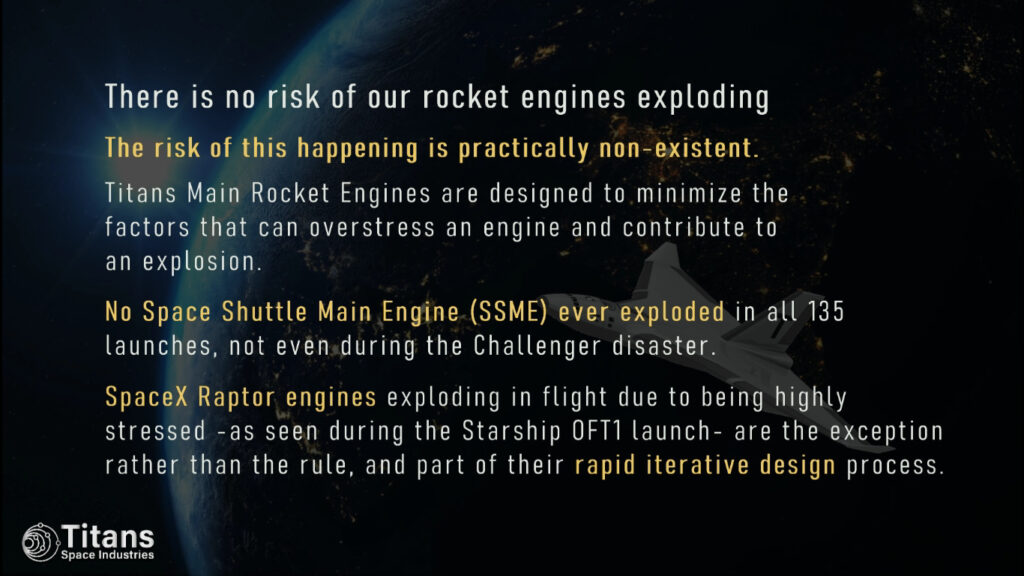
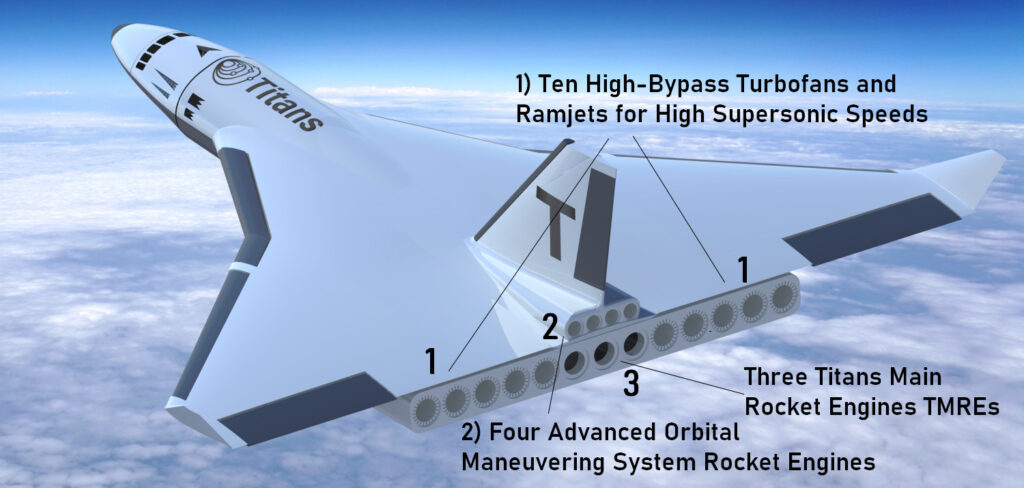
It should be understood that the Titans Main Rocket Engines (TMREs) are not magical "everything" engines.
Other spaceplane engine concepts like SABRE and Radian are developing magical engines that are required to work in Earth's atmosphere, all the way from ground/sea level into space.
TMREs are specifically rocket engines that need to function only in space.
Both, takeoff and climb to the ignition altitude for the rocket engines is done with (off-the-shelf, modified) airbreathing engines instead of rockets.
Titans Spaceplanes have three separate engine systems:
- Airbreather Propulsion (10 engines)
- Rocket Propulsion (3 Titans Main Rocket Engines)
- Orbital Maneuvering System (4 engines)
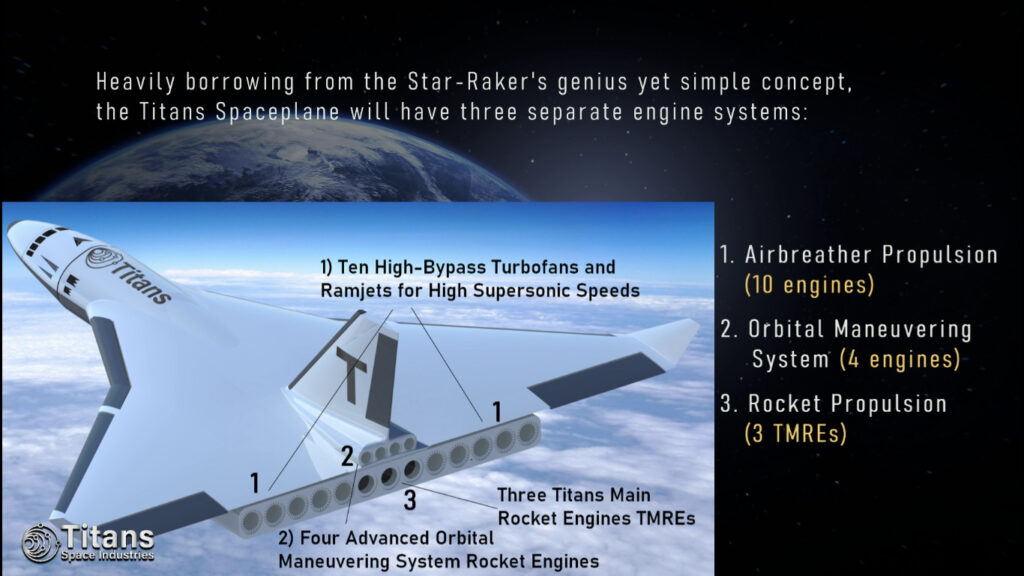
Our CTO, Franklin Ratliff, and his team are responsible for the design and development of the Titans engine systems.
Our airbreather engine is a combined cycle system (fanjet/ramjet) designed to get the spaceplane from takeoff to approximately Mach 4 at approximately 60,000 feet, where the spaceplane will ignite the main rocket engines and commence the dive maneuver.
Our spaceplane rocket engines are specifically designed to be an aircraft powerplant, and built for maximum reliability and durability.
At over 1 million lbs thrust it has twice the thrust of a space shuttle main engine (SSME).
When we fire the engines, it will be only the second 1-million lbs thrust engine fired, and the first to do it using LOX/hydrogen.
Please visit the Titans Engines Systems section of our website for further information.
Other spaceplane engine concepts like SABRE and Radian are developing "magical" engines magical engines that are required to work in Earth's atmosphere, all the way from ground/sea level into space.
Titans Main Rocket Engines (TMREs) are specifically rocket engines that need to function only in space.
Both, takeoff and climb to the ignition altitude for the rocket engines are done with (off-the-shelf, modified) airbreathing engines instead of rockets.
Like their big brother, Titans Space Shuttles have three separate engine systems, but with fewer engines.
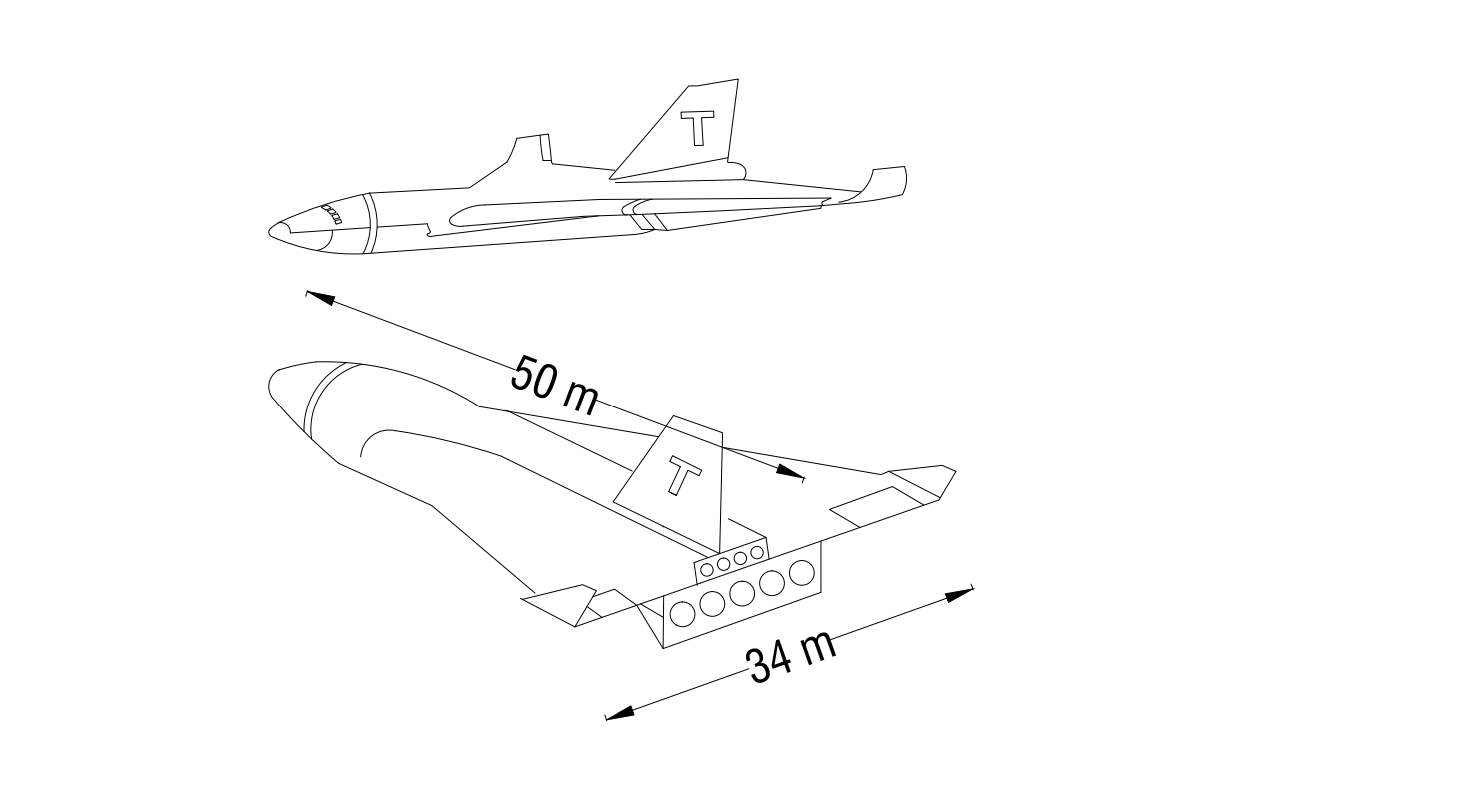
- Airbreather Propulsion (4 engines)
- Rocket Propulsion (1 Titans Main Rocket Engine)
- Orbital Maneuvering System (4 engines)
Our CTO, Franklin Ratliff, and his team are responsible for the design and development of the Titans engine systems.
Our airbreather engine is a combined cycle system (fanjet/ramjet) designed to get the spaceplane from takeoff to approximately Mach 4 at approximately 60,000 feet, where the spaceplane will ignite the main rocket engines and commence the dive maneuver.
Our spaceplane rocket engines are specifically designed to be an aircraft powerplant, and built for maximum reliability and durability.
At over 1 million lbs thrust it has twice the thrust of a space shuttle main engine (SSME).
When we fire the engines, it will be only the second 1-million lbs thrust engine fired, and the first to do it using LOX/hydrogen.
Please visit the Titans Engines Systems section of our website for further information.
At the top of the first phase climb, the spaceplane will perform a zoom climb in which the main rocket engines are fired as the spaceplane commences a dive.
A zoom climb is a climb where the rate of climb is greater than the maximum climb rate using only the thrust of the aircraft's engines
Astronauts will momentarily experience zero-g as the dive maneuver to build speed begins. At the bottom of the dive, astronauts are pressed into their seats as the plane is pulled out of the dive for the climb to orbit.
X-15 climbs were like our zoom climb maneuver, but with the speed coming from the B-52 carrier aircraft, not from a dive.
Read more about the flight experience here.
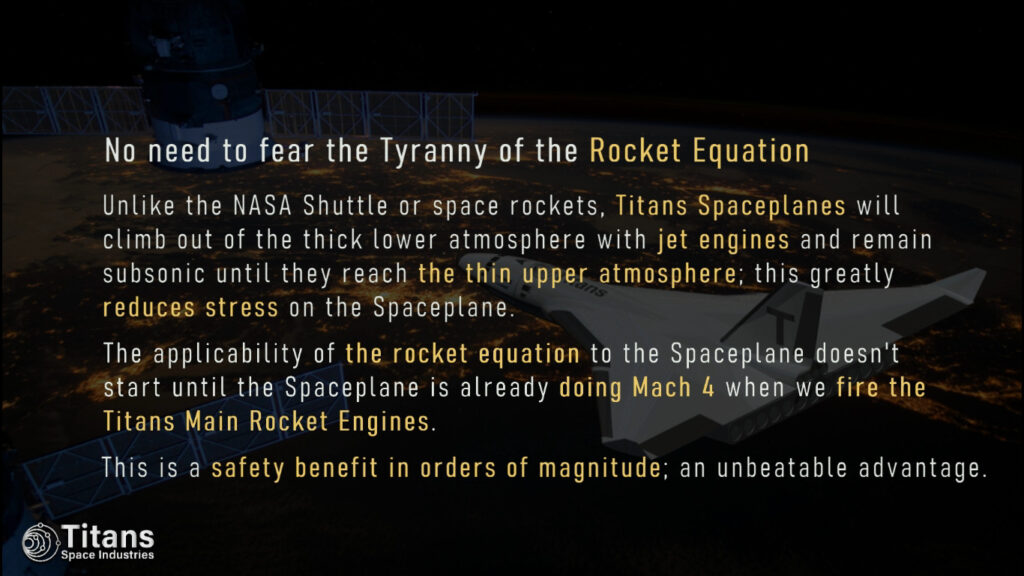
The applicability of the rocket equation to the spaceplane doesn't start until the plane is already doing Mach 4 when we fire the Titans Main Rocket Engines. Furthermore, instead of a gravity loss during the dive, gravity is actually working for us, not against us.
The rocket equation is Delta V (change in velocity) equals specific impulse x gravity x the natural log of the mass ratio.
The mass ratio in rockets is wet weight versus dry weight. Wet weight is the weight of the fuel and oxidizer plus the dry weight of the rocket. Since the oxidizer of a jet engine is the atmosphere, it can never run out of oxidizer, only fuel, so the mass ratio with airbreathing engines is essentially infinite. The oxidizer volume is not limited by the size of the vehicle.
The rocket equation doesn't become applicable to the Titans Spaceplane until the airbreathing engines are shut down.

Since the thrusters have to be in places where they have leverage, we will place them in similar locations to the NASA shuttle, which includes the nose.
We are developing the RCS/OMS systems in-house.
The OMS, consisting of four engines, can be found under the tail fin.


We are developing the RCS/OMS systems in-house.
No, we will not sell our rocket engines to third parties, and we do not intend to share specifics of our rocket engines with the public.
About Titans Spaceplanes and the experience

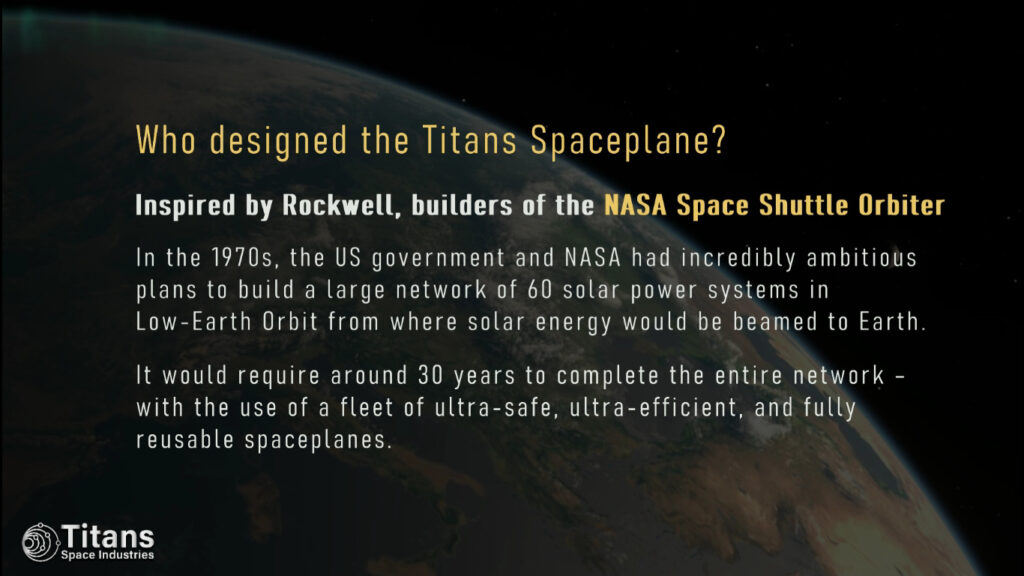
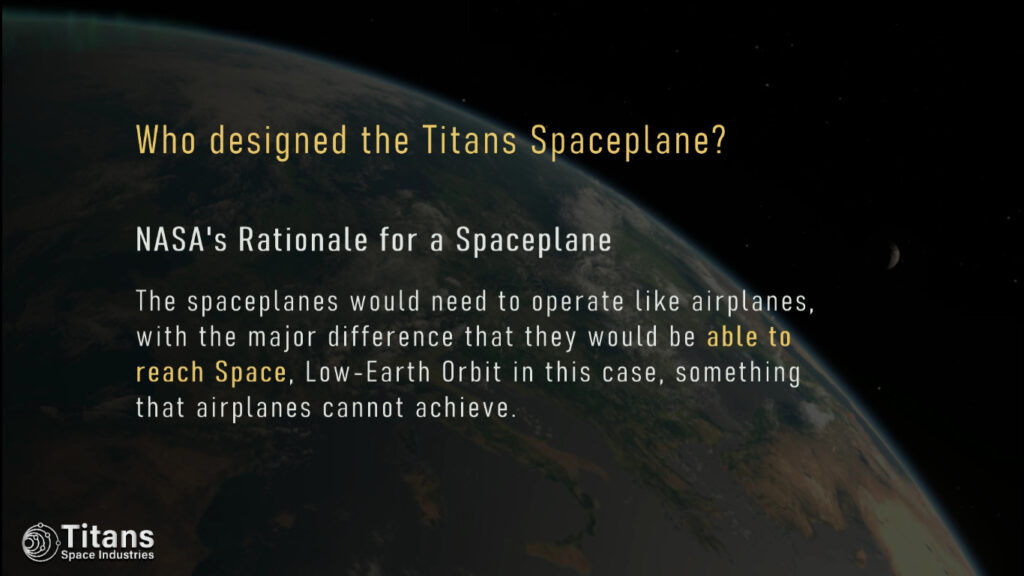
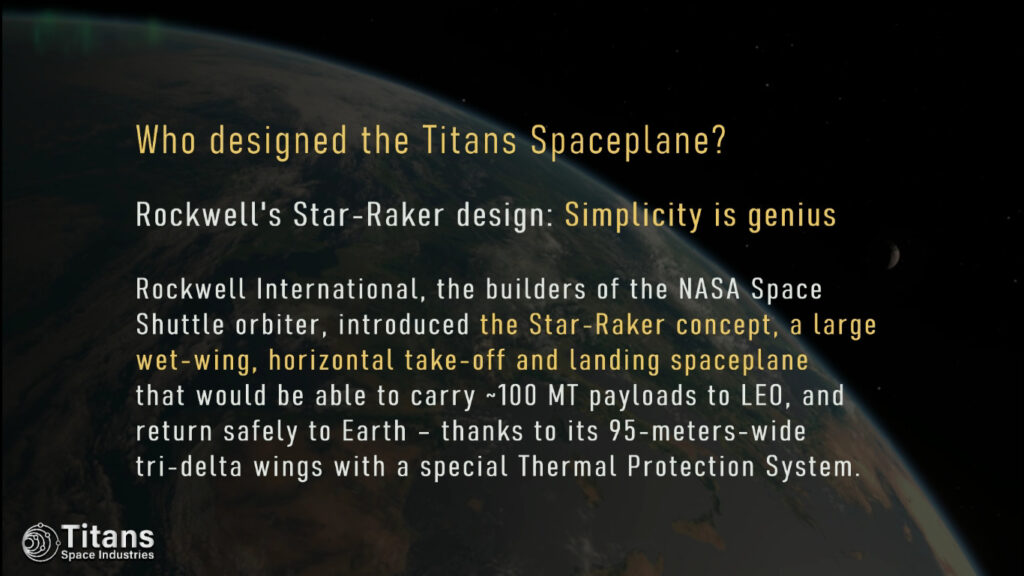
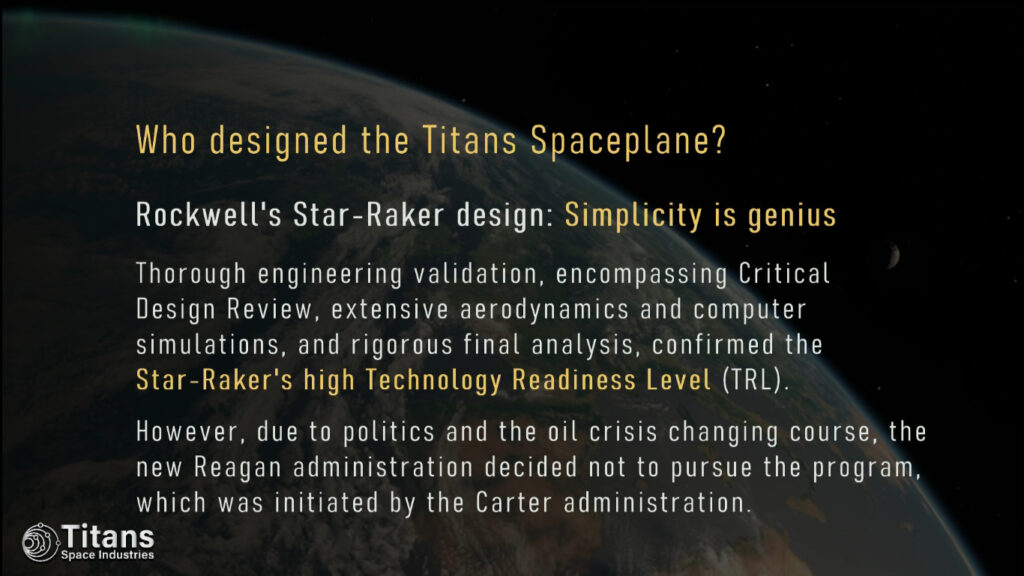
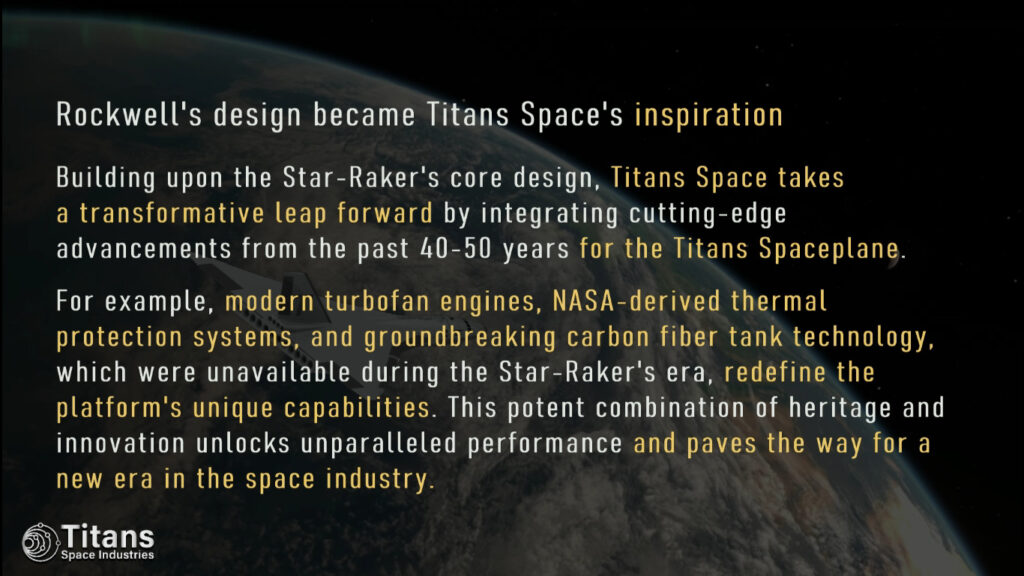
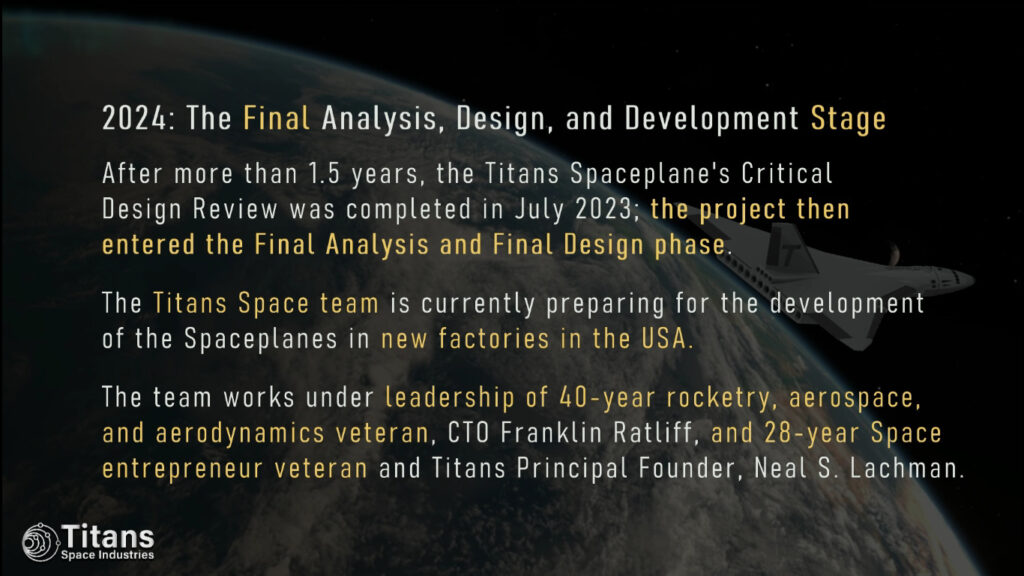
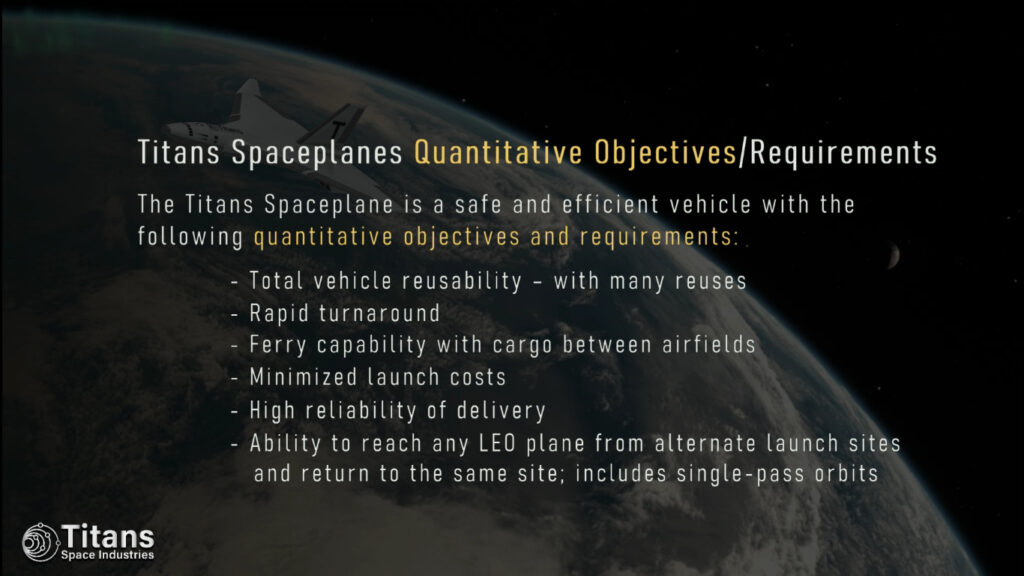
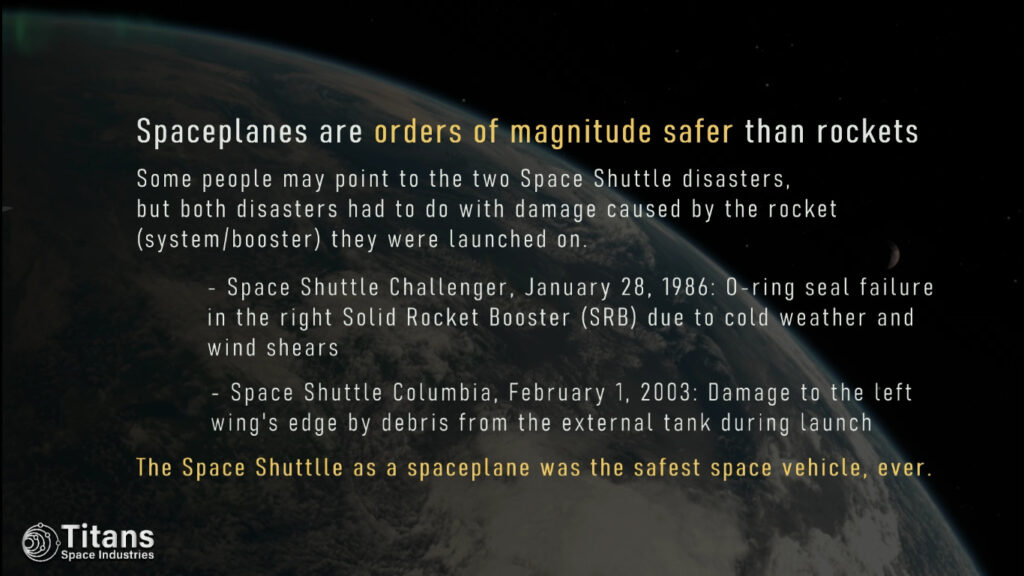
A spaceplane is a kind of airplane with a propulsion system and heat shielding that allows it to operate in the vacuum of space and to reenter Earth's atmosphere.
The Titans Spaceplane is an airplane-like vehicle that goes "beyond the Concorde and is capable of Space transport".
The Titans Spaceplane is the first spaceplane to take off from a runway.
All past and present spaceplanes (were) launch(ed) on top of a rocket (like the NASA Space Shuttle), or from underneath the wing of a mothership aircraft (like Virgin Galactic's SpaceShipTwo). Sierra Nevada's upcoming Dream Chaser spaceplane will also launch on top of a rocket.
Learn more about the Titans Spaceplanes here.
The Titans Space Shuttle is a kind of airplane with a propulsion system and heat shielding that allows it to operate in the vacuum of space and to reenter Earth's atmosphere.
The Titans Space Shuttle is an airplane-like vehicle that goes beyond the Concorde and is capable of space transport.
The Titans Space Shuttle Orbiter is a spaceplane and, simply put, a powerful but half-sized version of the Titans Spaceplane.
R&D of the Titans Space Shuttle is underway, and production of the first Spaceplanes starts in late 2024/early 2025. Flights (tests, followed by operations) will start from 2027 onward.
Read more about the Titans Space Shuttle here.
The Titans Spaceplane is a kind of airplane with a propulsion system and heat shielding that allows it to operate in the vacuum of space and to reenter Earth's atmosphere.
The Titans Spaceplane is the first spaceplane to take off from a runway like an airplane.
Besides being used for safe, frequent, and efficient Space transport (flights/travel and launches), Titans Spaceplanes allow for solutions that are (and may always be) impossible with vertically launched rocket vehicles.


Orbital Transport
✓ Orbital Trajectory: Ascend to orbit followed by 1.5 or two orbits until the vehicle is within range of the destination airfield
✓ Pin-Point Exact Delivery: Titans spaceplanes can deliver anywhere, from rural areas to deserts, or to a ship or submarine at sea.

✓ Titans Spaceplanes can transport cargo and passengers directly to and from any large airport in the world
✓ Flight duration: 120-180 minutes to any drop location - (view orbital flight trajectory)
✓ Delivery to remote outposts
✓ No forward bases required (for military cargo drops)
The Titans spaceplanes can stay in orbit and deploy uncrewed reentry capsules, making precision landings under parafoil. Utilizing low-cost, single-use reentry capsules expands the Titans spaceplane's cargo delivery and disaster relief capabilities to missions where a suitable airfield is not available, such as in remote or rural areas.
For more information, please visit the Orbital Transport section.
Sub-Orbital Transport
Transport personnel and cargo anywhere in less than 90 Minutes - faster than hypersonic transport.

✓ Sub-Orbital Trajectory (arc)
✓ Flight time: 90-120 minutes to any location
✓ Ascend through a suborbital ballistic arc where the vehicle flies outside the atmosphere but stays below orbital velocity
Different from orbital flights, when utilizing a ballistic arc trajectory, Titans vehicles do not achieve orbital velocity. Instead, the vehicle climbs out of the atmosphere at speeds below orbital velocity.
The vehicle will ascend to approximately 200 kilometers (apogee), and continue its descent to the destination airport or spaceport.
For more information, please visit the Sub-Orbital Transport section
Ultra-Fast Travel
Travel Anywhere in 90-120 Minutes. Beyond Concorde; Capable of Space Transport.
Titans Spaceplane flyers will travel in luxurious style and have their individual Spacepods inside the cabin.
Most destinations are estimated to be reached within 90 minutes, from take-off to landing.
Rocket lift-off requires passengers to remain in a reclined position, strapped into their seats; Titans passengers will experience airplane-like comfort and ease.
✓ Sub-Orbital Trajectory (arc)
✓ Flight time: 90-120 minutes to any location - Faster than Hypersonic Travel
✓ Ascent through a suborbital ballistic arc where the vehicle flies outside the atmosphere but stays below orbital velocity
✓ Land at any large airport: The vehicle can land at any contracted airport.
The rocket engines are switched off as our desired altitude (200 kilometers) is achieved. At that moment, for 10-15 minutes, the astronauts can unbuckle their restraint harnesses and proceed to the front of the Passenger Module.
The windows and viewing cupola provide the flyers with a spectacular view of Earth and Space. After approximately 10-15 minutes in space at zero-g, the astronauts return to their seats and buckle in for reentry and landing. The vehicle will ascend to approximately 200 kilometers (apogee), and continue its descent to the destination airport or spaceport.
The ultra-fast travel experience is identical to the Sub-Orbital Zero-G flight experience.
For more information, please visit the Ultra-Fast Travel section.
Other unique Applications
A dream come true for military and government agencies
Titans Space is investigating the potential for a spaceplane to change orbital inclination while already in orbit by diving into the upper atmosphere, banking to change direction, then reboosting itself back into orbit in a new inclination. This could, for example, allow during the same flight deployment of satellites to different orbital inclinations.
Titans Spaceplanes will also have the capability of rapid response deployment of assets to orbit. For example, with short notice, a Titans Spaceplane can carry a surveillance asset into orbit in its cargo bay, deploy the asset over the target area, then recover the asset and return it to the landing site.

The Titans spaceplanes and space shuttles are radically different from the old NASA Space Shuttle system.
The Titans Spaceplanes have no external tank or solid rocket boosters, so there are none of the threats that resulted from the NASA Shuttle being mounted to the side of a rocket.
Takeoff with our vehicles is from a runway, just like a conventional airliner.
Both takeoff and climb to the ignition altitude for the rocket engines are done with airbreathing engines instead of rockets.
1. Orbital Cruise - Flight Trajectory
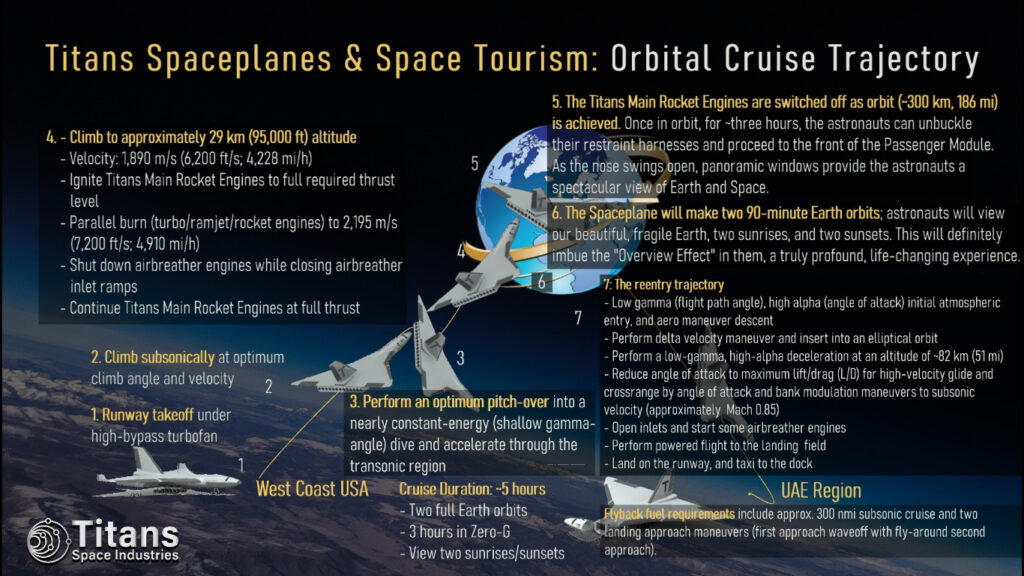
2. Sub-Orbital Zero-G Flight Trajectory

3. Space Station - Transport Trajectory

Read more about the Titans Spaceplanes here.

Read our analysis where we discuss the inspiration from the Star-Raker spaceplane, or view the information images below (taken from the Titans Spaceplanes section).










The Titans vehicles take off from a runway with the same jet engines used in a conventional airliner. The pilots can abort the flight at any time and return to the runway.
Read this article for some background on the dangers of rockets.
Read more about the Titans spaceplanes here. or view the information images below.
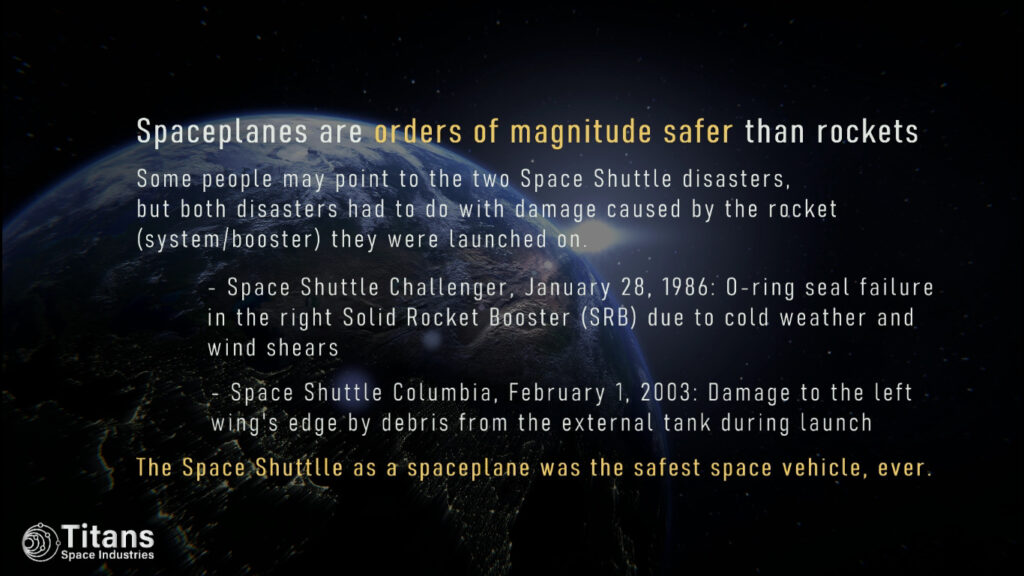


The Titans Spaceplanes will be put through a rigorous flight test program (similar to a conventional airliner) to verify their flying characteristics and define their operating envelope.

The Titans Spaceplanes are not booster rockets; this eliminates the hazards of the space rockets people are familiar with.
The wings of the Titans Spaceplane also serve as an abort system that allows the Spaceplane to glide to a safe landing.
But there are also a number of unique safety features for the Titans Spaceplanes
Passenger Module (Passenger Cabin)
The Passenger Module is a separate module which mounts to the floor of the cargo bay. This modular
approach provides complete isolation of the passengers from smoke and fire in a crash landing as well as allowing the exterior of the Passenger Module to be covered by fireproof ceramic blankets similar to those used on the outside of the space shuttle.
The Passenger Module is divided into two decks with
each deck having its own tunnel connecting it to the Crew Module in the nose. Inside the Passenger Module a spiral staircase connects the upper and lower decks.
Emergency Egress
Normal ingress/egress as well as egress for evacuation is provided by two doors in the nose. The
two viewing cupolas in the roof double as a hatch for emergency egress.
Upholstery and Carpeting
The interior design of the Passenger Module minimizes the chances of fire or toxic smoke through using naturally fire resistant wool carpeting and seat upholstery instead of flammable synthetic fibers.
"Spacepod" Encapsulated Seats
The biggest safety innovation of the Titans Spaceplane is the Spacepod Encapsulated Seats for the
Passenger Module. These Spacepod seats use individual clamshell enclosures which are normally open
during the flight but in the event of depressurization or other emergency slide down and enclose the seat,
maintaining the passenger in a breathable atmosphere with their own ECLSS system without the discomfort and claustrophobia of an IVA suit. The passenger can also use the clamshell enclosure during the flight for privacy. Instead of overhead bins, each passenger uses a fireproof compartment on the Spacepod to store their carry-on luggage, if any.
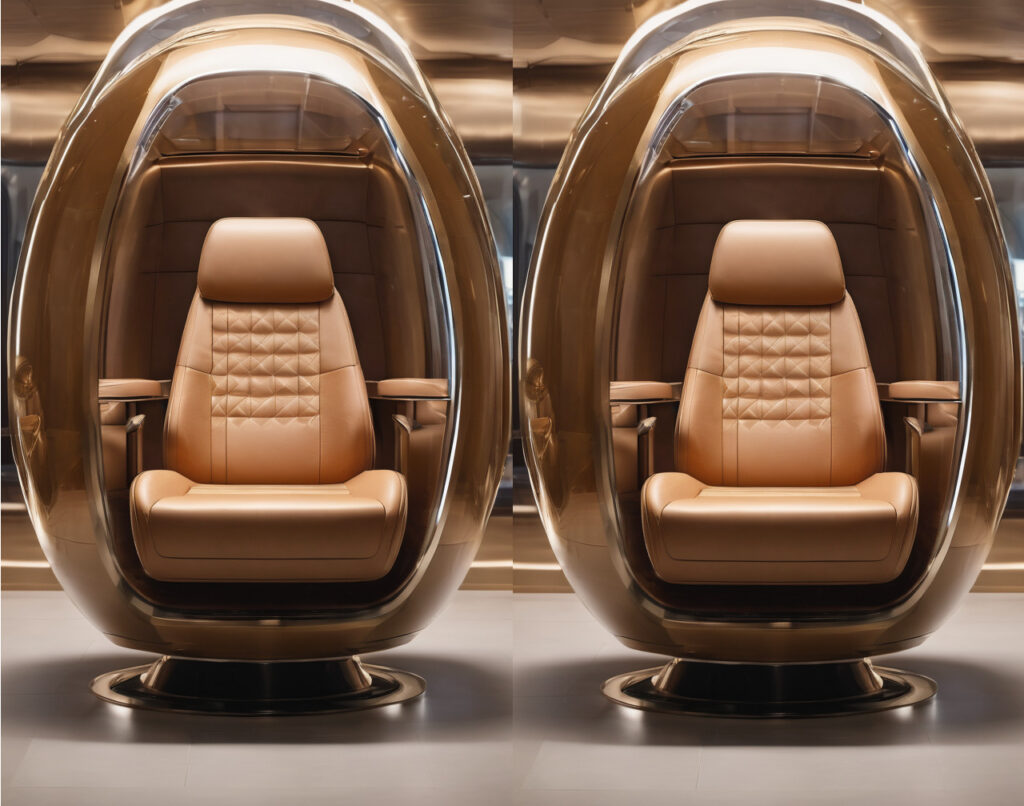
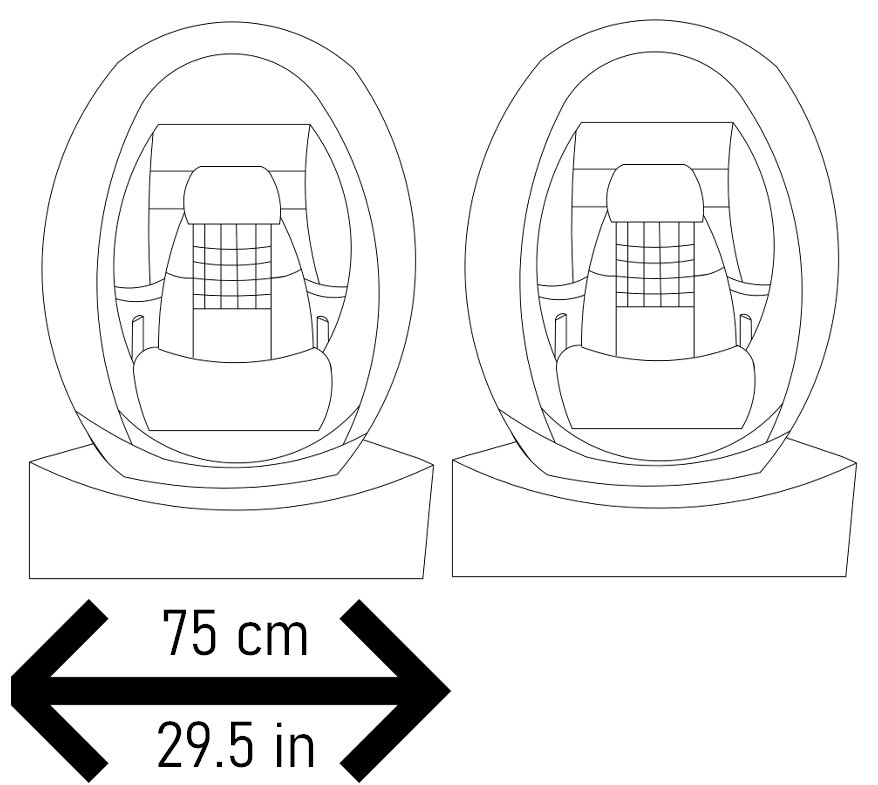
IVA Suits for Pilots and Crew
The pilots, stewards, and other flight crew wear IVA suits for the duration of the flight. This allows the pilots to operate the Spaceplane normally while giving stewards the mobility needed for attending to passengers, including verifying that the Spacepod clamshells are properly sealed if needed.
Read more about the Titans Spaceplanes here.
The applicability of the rocket equation to the spaceplane doesn't start until the plane is already doing Mach 4 when we fire the main rocket engines. Furthermore, instead of a gravity loss during the dive, gravity is actually working for us, not against us.
The rocket equation is Delta V (change in velocity) equals specific impulse x gravity x the natural log of the mass ratio. The mass ratio is wet weight divided by dry weight.
Unlike a rocket, the mass ratio of an airbreathing vehicle is essentially infinite because it's pulling the oxidizer from the atmosphere instead of storing it onboard. The rocket equation doesn't become applicable to the spaceplane until the airbreathing engines are shut down.

The Titans Spaceplanes will use a metallic system incorporating titanium and superalloys for the wing uppersides, and NASA-developed TUFROC for the wing leading edges and undersides.
The wings hold the fuel for the rocket and jet engines.
Pressure in the wing tanks will be used to stiffen the wings, allowing a much lighter structure than conventional wing construction.

For Space flights (e.g. Orbital Cruises), Titans Spaceplanes will fly at orbital velocity (17,500 mph) at an altitude of ~300 km (186 miles).
Flight Trajectory

2. Sub-Orbital Zero-G Flight Trajectory

3. Space Station - Transport Trajectory

Read more about the Titans Spaceplanes here.
At the top of the first phase climb, the spaceplane will perform a zoom climb in which the main rocket engines are fired as the spaceplane commences a dive.
A zoom climb is a climb where the rate of climb is greater than the maximum climb rate using only the thrust of the aircraft's engines
Astronauts will momentarily experience zero-g as the dive maneuver to build speed begins. At the bottom of the dive, astronauts are pressed into their seats as the plane is pulled out of the dive for the climb to orbit.
X-15 climbs were like our zoom climb maneuver, but with the speed coming from the B-52 carrier aircraft, not a dive.
Read more about the Orbital Cruise experience here.
View the different flight trajectories here, or view the information images below.
1. Orbital Flight Trajectory
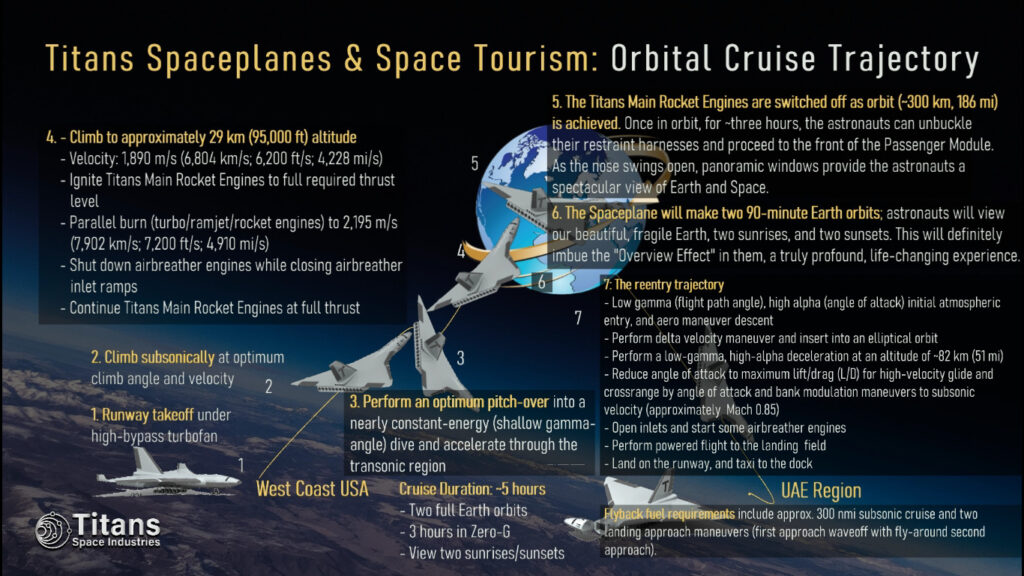
2. Sub-Orbital Flight Trajectory
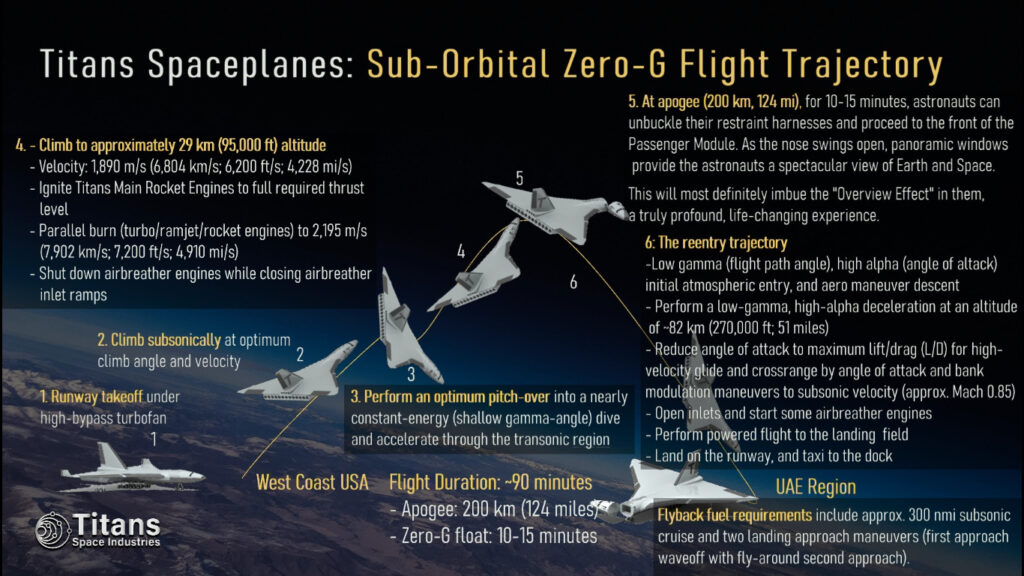
3. Space Transport Trajectory
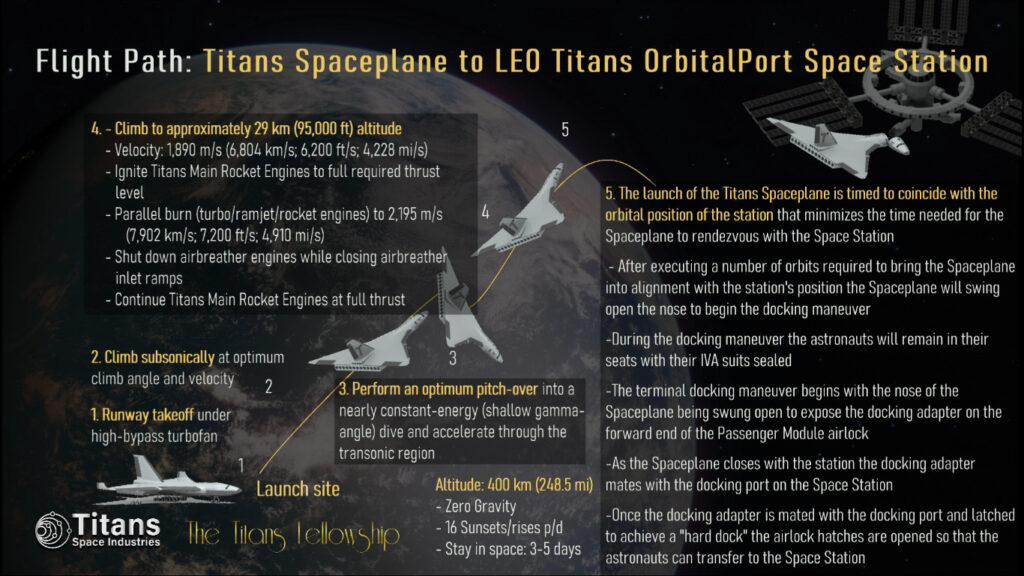
Titans Spaceplanes use the same Environmental Control and Life Support System (ECLSS) technology found in other crewed spacecraft.
The biggest safety innovation of the Titans Spaceplane is the Spacepod Encapsulated Seats for the
Passenger Module. These Spacepod seats use individual clamshell enclosures that are normally open
during the flight but in the event of depressurization or other emergency, slide down and enclose the seat,
maintaining the passenger in a breathable atmosphere with their own ECLSS system without the
discomfort and claustrophobia of an IVA suit. The passenger can also use the clamshell enclosure during the flight for privacy. Instead of overhead bins, each passenger uses a fireproof compartment on the
Spacepod to store their carry-on luggage, if any.
Read more about the Titans Spaceplanes here.
Our Astronauts remain inside the spaceplane, so there is no need for a spacesuit.
The biggest safety innovation of the Titans Spaceplane is the Spacepod Encapsulated Seats for the
Passenger Module. These Spacepod seats use individual clamshell enclosures that are normally open
during the flight but in the event of depressurization or other emergency, slide down and enclose the seat,
maintaining the passenger in a breathable atmosphere with their own ECLSS system without the
discomfort and claustrophobia of an IVA suit. The passenger can also use the clamshell enclosure during the flight for privacy. Instead of overhead bins, each passenger uses a fireproof compartment on the
Spacepod to store their carry-on luggage, if any.


Learn more about the Orbital Cruise experience here, and the Sub-Orbital Zero-G Flight experience here.
Learn more about the Titans Spaceplanes here.
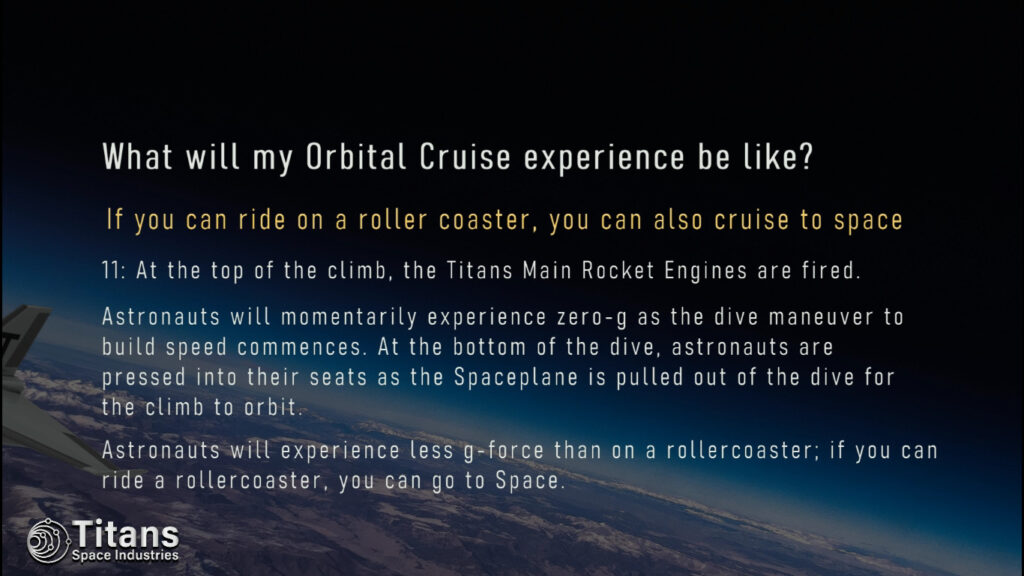
There is no need for an extensive training program to go to space with Titans Space.
Even seniors have gone to space.
William Shatner (90 years old): In October 2021, Captain Kirk himself, William Shatner, blasted off on Blue Origin's New Shepard rocket, becoming the oldest person to reach space. At 90 years and 177 days old, he broke the record previously held by Wally Funk (82) who flew on the same spacecraft just months earlier.
Wally Funk (82 years old): In July 2021, aviation pioneer Wally Funk finally fulfilled her lifelong dream of reaching space at the age of 82. Selected for NASA's astronaut training program in the 1960s but ultimately grounded due to her gender, Funk joined Jeff Bezos and three others on Blue Origin's historic first crewed flight.
Visit the Sub-Orbital Zero-G flights or the Orbital Cruises sections to learn more about the experience.
The Titans Spaceplanes are not booster rockets; this eliminates the hazards of the space rockets people are familiar with.
The wings of the Titans Spaceplane also serve as an abort system that allows the Spaceplane to glide to a safe landing.
But there are also a number of unique safety features for the Titans Spaceplanes
Passenger Module (Passenger Cabin)
The Passenger Module is a separate module which mounts to the floor of the cargo bay. This modular
approach provides complete isolation of the passengers from smoke and fire in a crash landing as well as allowing the exterior of the Passenger Module to be covered by fireproof ceramic blankets similar to those used on the outside of the space shuttle. The Passenger Module is divided into two decks with
each deck having its own tunnel connecting it to the Crew Module in the nose. Inside the Passenger Module a spiral staircase connects the upper and lower decks.
Emergency Egress
Normal ingress/egress as well as egress for evacuation is provided by two doors in the nose. The
two viewing cupolas in the roof double as a hatch for emergency egress.
Upholstery and Carpeting
The interior design of the Passenger Module minimizes the chances of fire or toxic smoke through using naturally fire resistant wool carpeting and seat upholstery instead of flammable synthetic fibers.
"Spacepod" Encapsulated Seats
The biggest safety innovation of the Titans Spaceplane is the Spacepod Encapsulated Seats for the
Passenger Module. These Spacepod seats use individual clamshell enclosures which are normally open
during the flight but in the event of depressurization or other emergency slide down and enclose the seat,
maintaining the passenger in a breathable atmosphere with their own ECLSS system without the discomfort and claustrophobia of an IVA suit. The passenger can also use the clamshell enclosure during the flight for privacy. Instead of overhead bins, each passenger uses a fireproof compartment on the Spacepod to store their carry-on luggage, if any.


IVA Suits for Pilots and Crew
The pilots, stewards, and other flight crew wear IVA suits for the duration of the flight. This allows the pilots to operate the Spaceplane normally while giving stewards the mobility needed for attending to passengers, including verifying that the Spacepod clamshells are properly sealed if needed.
The passenger module of the large Titans Spaceplane can accommodate 15-330 Astronauts, depending on the configuration (space tourism, commercial, military, government/heads of state, etc.).
Learn more about the Orbital Cruise experience here, and the Sub-Orbital Zero-G Flight experience here.
Learn more about the unique Titans Spaceplanes safety characteristics here.
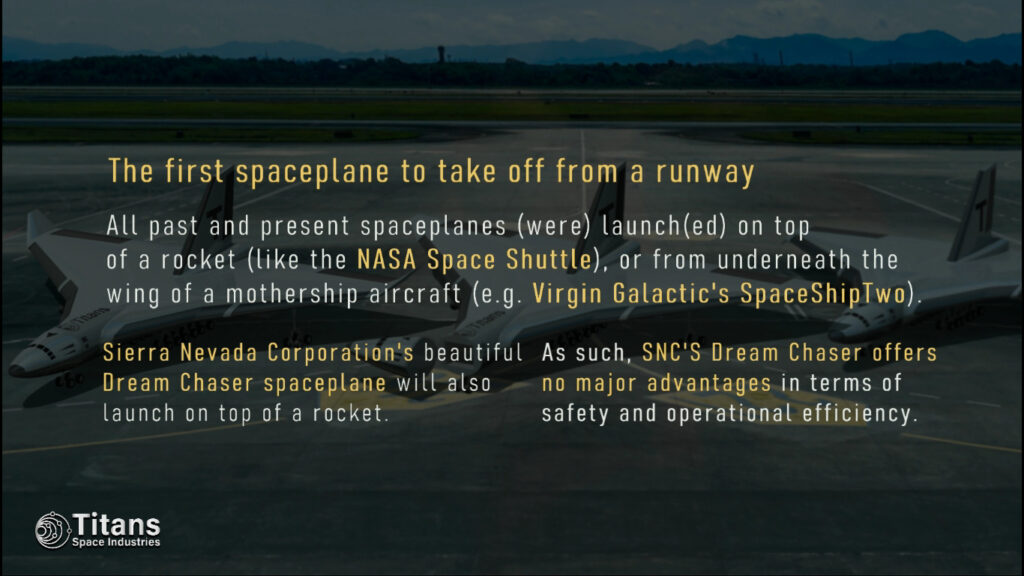
Please click on the image below for a comparison matrix:
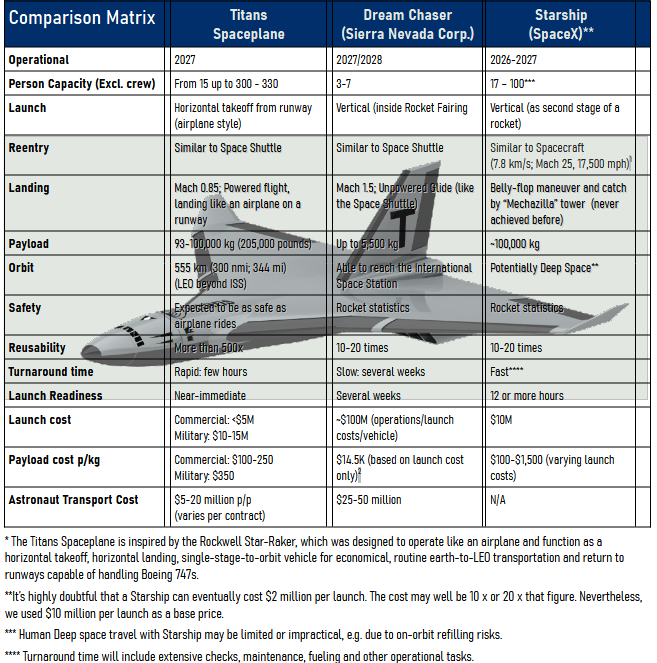
1. Orbital Cruise - Flight Trajectory

2. Sub-Orbital Zero-G Flight Trajectory

3. Space Station - Transport Trajectory
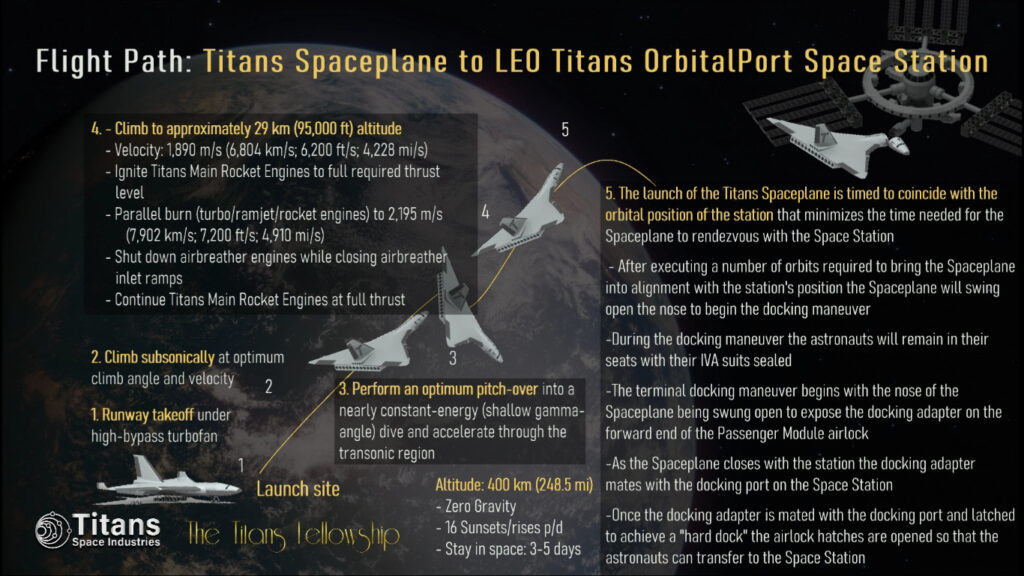
About Titans Spacecraft
The short answer
Titans Space is the only company in the world that will own and operate the four main infrastructure components that would make end-to-end Space travel safe, efficient, and less costly.
In the near future, you will arrive at a particular Titans spaceport facility, and a few days later you will step on the lunar surface to spend a few days at the Titania Lunar Resort.
The long answer
Currently, all space travel and space launch missions are severely restricted because there is only one way to get off planet Earth (and go to the Moon and further): Rockets.
This is where the Titans Space transportation infrastructure brings about a revolutionary paradigm shift.
The four main Titans Space infrastructure components are:
1: Spaceplanes
2: Spaceships
3: Space Stations
4: Lunar Yacht Transporters
The main differences between our Space projects and others are rooted in the fact that we own and operate our proprietary end-to-end (Earth surface to Lunar surface and vice versa) space transportation infrastructure.
For example, something that's presently beyond imagination for most people: visiting the Moon.
In the near future, you will be able to get on a Titans Spaceplanes, then transfer in Low-Earth Orbit to a Titans SpaceShip that will transport you to the Lunar Titans OrbitalPort Space Station in about three days, and the Titans Lunar Yacht Transporter will deliver you to the Titania Lunar Resort.
Read more about the Titans Space Transportation infrastructure here.
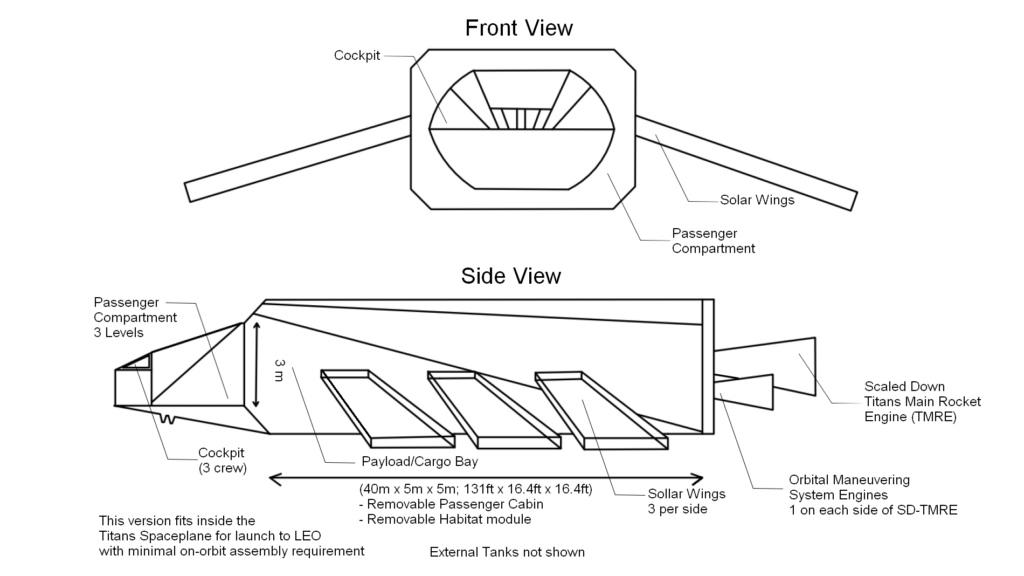
Titans SpaceShips (aka Orbital Transporters) are our vehicles for space transportation of persons and cargo - taking off from LEO to Lunar orbit, and vice versa. They can also function as Space stations (besides -or until replaced by- the LEO or Lunar Titans OrbitalPort Space Stations).
✓ Titans SpaceShips are Orbital Transporters that are built on Earth in modular parts.
✓ As they fit perfectly in the Titans Spaceplanes they can either be transported to Low-Earth Orbit in one piece or assembled on-orbit, similar to how the International Space Station was assembled in space.
✓ The Orbital Transporters take off to the Titans space station in the Moon's orbit with up to 24 astronauts and ~80-100 metric ton of cargo.
Operations-wise, the Orbital Transporters are refilled on-orbit (in Space or at our Space Base) by way of multiple removable 45-ton External Tanks that attach to the vehicle. The propellant will be enough for a return trip.
The Orbital Transporters takes off to the Titans OrbitalPort Space Station in the Moon's orbit (or beyond) with up to 24 astronauts and ~80-100 metric tons of cargo.
Delivery of modules by spaceplanes and spaceships also allows/enables assembly of the Titans OrbitalPort Space Stations (TOPPS; LEO and Lunar).
Titans Spaceplanes are used for Space transport and launches from Earth to LEO; Titans Spaceships/Orbital Transporters aren't intended to operate from Earth. Once put in Space, the Orbital Transporters will remain on-orbit and travel between LEO and Lunar orbit on a frequent basis.
Maintenance, repair, and servicing of the spaceships happen on-orbit and at the LEO and Lunar TOPSS.
Read more about the first planned 12-crew mission made possible by the Orbital Transporters here.
Titans Lunar Yacht Transporters are our landing/ascend vehicles for the Moon.
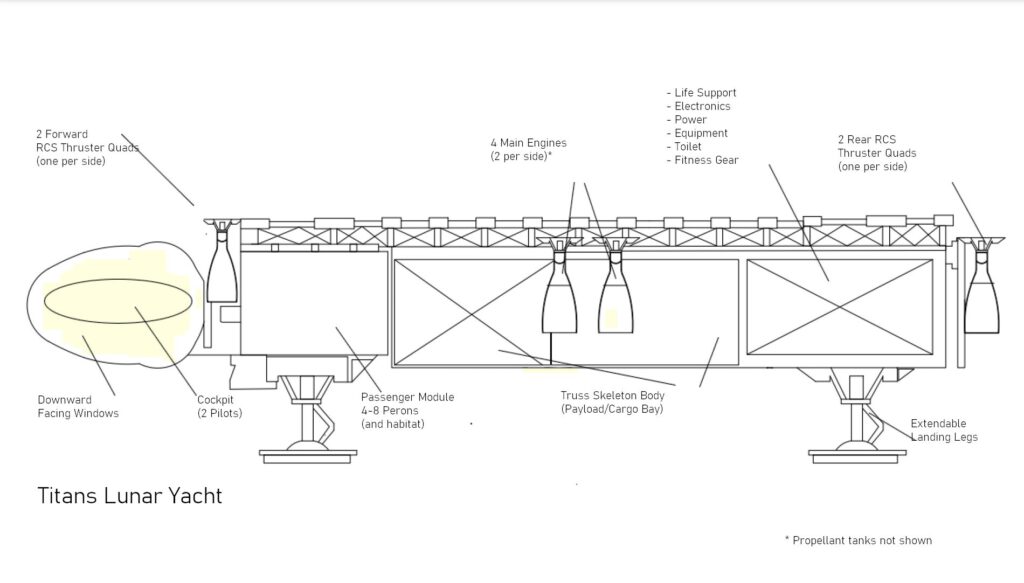
The Titans Lunar design is inspired by the Eagle Transporter from Space: 1999.
After studying lunar landers from the Space Race era as well as modern versions proposed by others (from iSpace to SpaceX to Dynatics to Blue Origin), we decided that a three-legged (horizontal) belly-landing vehicle is the most reliable design.
The Titans Lunar Yacht Transporter can also double as a rocket-powered/flying point-to-point vehicle for Lunar surface transportation; it has a habitat module with complete life support and operational systems.
The Lunar Yacht Transporter will dock at/launch from the Lunar Titans OrbitalPort Space Station, or one of the Titans SpaceShips.
Read more about the Titans Lunar Yacht Transporter here.
Lunar industrialization, which includes mining and a large lunar resort, is at the core of our company objectives. As such, the travel experience to the Moon (and back) should be safe, efficient, and comfortable. You can view the LEO Space travel trajectories below (images).
The entire Titans end-to-end human Space travel infrastructure is centered around these three core principles. It's as simple as that.
Our vehicles are designed with the latest technologies to ensure that the dangers of Space travel are minimized and in some cases completely removed.
Before we put people on our vehicles, they will be put through rigorous testing procedures. All vehicles will have to perform perfectly before we start operations.
- Learn more about Titans Spaceplanes here.
- Learn more about Orbital Cruises here.
- Learn more about Sub-Orbital Zero-G Flights here.
- Learn more about LEO Space Hotel here.
- Learn more about Titans SpaceShips here.
- Learn more about Lunar Orbital Hotel here.
- Learn more about Titania Lunar Resort here.
- Learn more about the Titans Lunar Yachts here
1. Orbital Cruise - Flight Trajectory

2. Sub-Orbital Zero-G Flight Trajectory

3. Space Station - Transport Trajectory

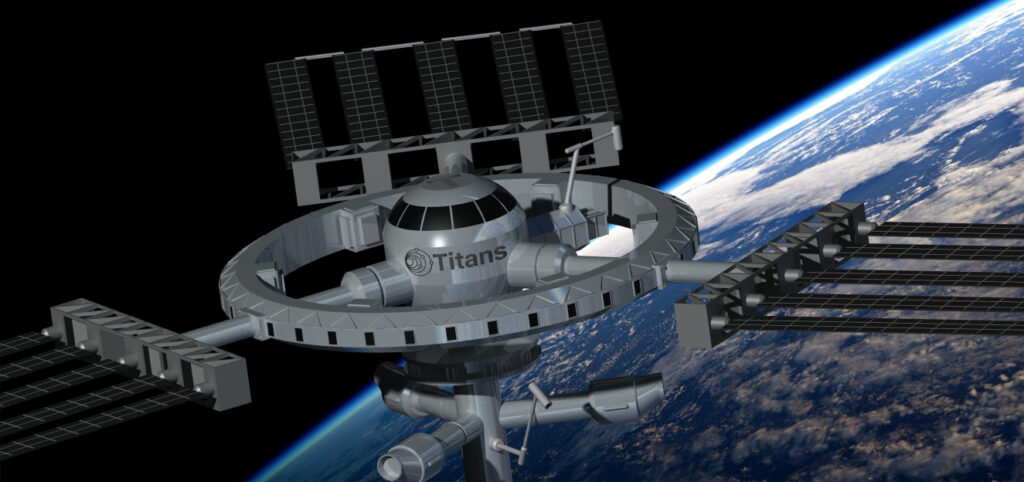
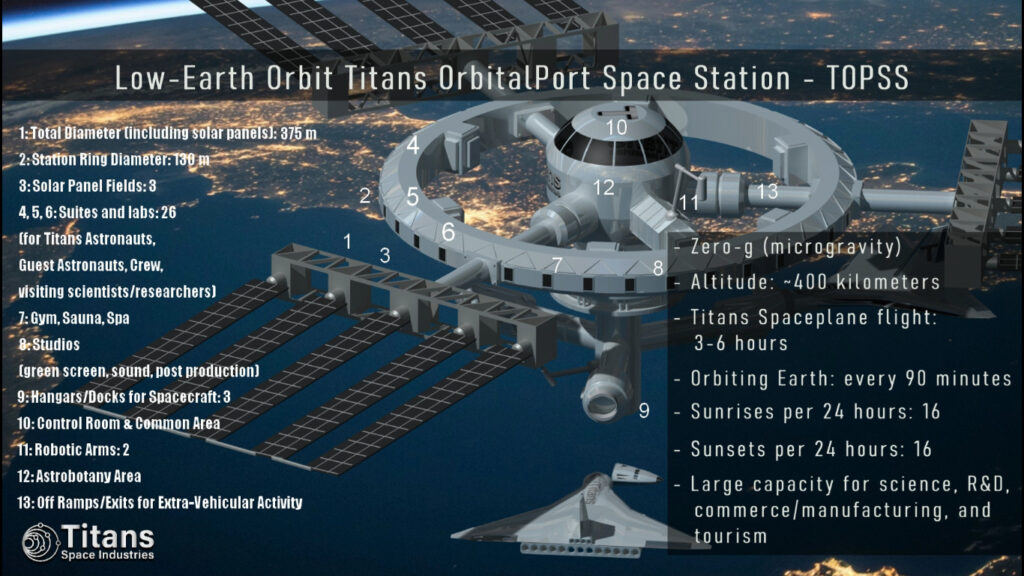
As you can see in the above rendering, the Titans LEO Space Hotel (as part of the LEO Titans OrbitalPort Space Station), is nothing like any Space station you know.
Our Space station is a large structure and will continue to be extended with (attached/semi-attached) modules. And... we will also build one for Lunar orbit.
The main differences between our Space stations and others are the structural size, the amenities, and the frequency they can be visited.
We will build the Space station modules on Earth and then deliver them to space with our own spaceplanes in order to assemble them on-orbit.
This is also the reason why all other proposed space stations look somewhat similar: cylindrical modules that are attached to each other. This design concept is decades old, and due to the need to launch them on rockets, they are severely limited in size and mass. The more weight, the more expensive it would be to assemble the space station on-orbit.
With our own spaceplanes, we don't have those kind of limiting factors. As such, we can build and extend our Space stations as we please.
The Lunar Space Station will be assembled in Lunar Orbit where modules are first transported from Earth to LEO with spaceplanes, then transferred to Titans SpaceShips that will transport the modules to Lunar Orbit.
Learn more about the Titans LEO Space Hotel here.
Learn more about the Titans Lunar Orbital Hotel here.
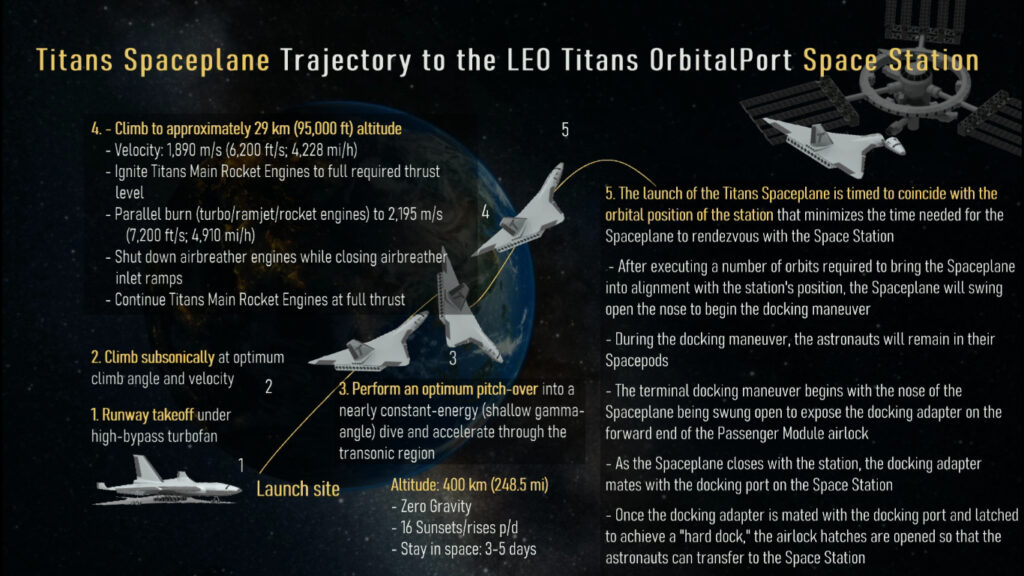

The short answer: We will own and operate an end-to-end Space transportation infrastructure that we operate completely independently.
Furthermore, our primary customer base consists of Titans Astronauts, which allows us to invest in several capital-intensive projects simultaneously.
And last, but not least: Because of its financial independence, Titans Space doesn't require government (agency) grants/contracts/funding, which are inherently lengthy and cumbersome processes.
The long answer:
Currently, all space travel and space launch missions are severely restricted because there is only one way to go to space (and to the Moon and further): Rockets.
This is where the Titans Space transportation systems (consisting of reusable spaceplanes, spaceships, Space stations, and lunar transporters) bring about a revolutionary paradigm shift.
The main differences between our Space projects and others are rooted in the fact that we own and operate our proprietary end-to-end (Earth surface to Lunar surface and vice versa) space transportation infrastructure.
For example: we will build modules for the lunar colony on Earth, then transport them from Earth to LEO with our own spaceplanes, and then transfer them to Titans SpaceShips that will transport the modules to the Lunar Titans OrbitalPort Space Station (Lunar TOPSS). The Lunar Transporter will deliver the modules to the Lunar surface.
Learn more about the Titans Lunar Orbital Hotel here.
Learn more about the Titania Lunar Colony here.
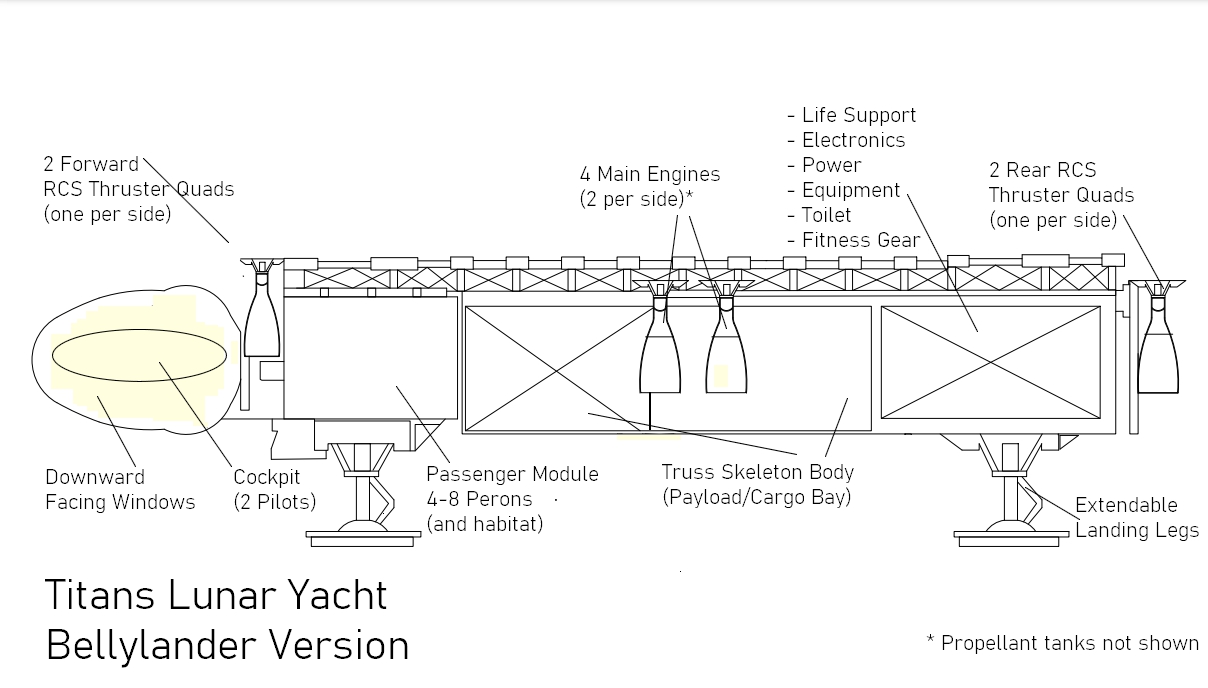
Every landing attempt by Apollo astronauts was successful: 7 out of 7.
Our Lunar Yacht Transporters will follow the Apollo philosophy of having an autonomous system that human pilots monitor and can override if they see a problem developing, such as where the vehicle is landing.
Furthermore, one critical design feature will be the addition of downward-facing windows, which will allow the crew to view the surface under the yacht.
It is important to note that, unlike the Apollo astronauts, Lunar Yacht Transporter pilots will be trained in simulators that do not require flying an actual vehicle.

Yes, Lunar Yacht Transporters will be able to take off, fly, and land at multiple locations - as much as the fuel load allows.
All Titans spacecraft flights will be carefully planned.
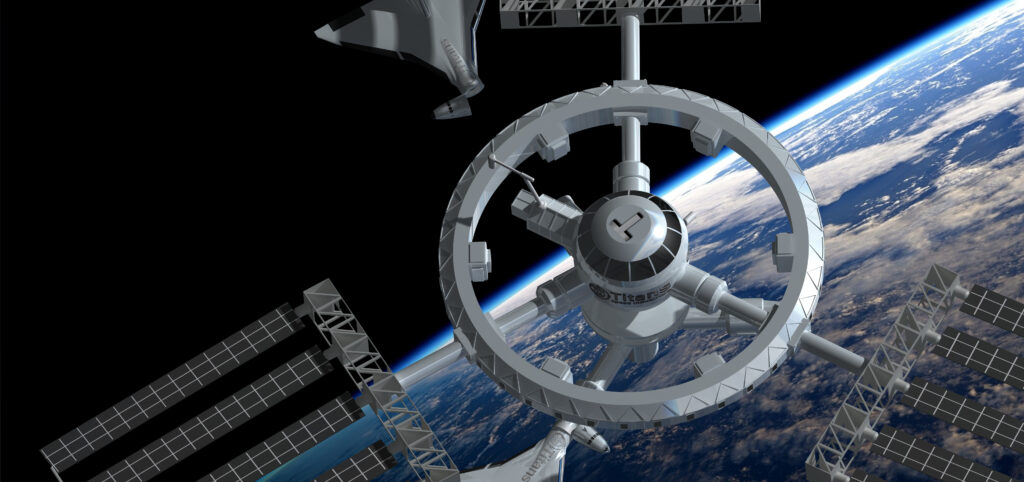
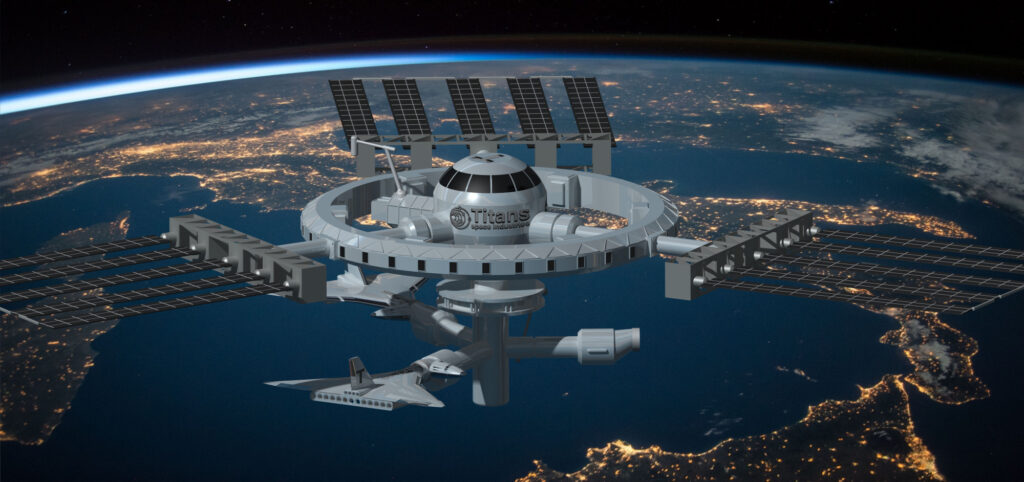

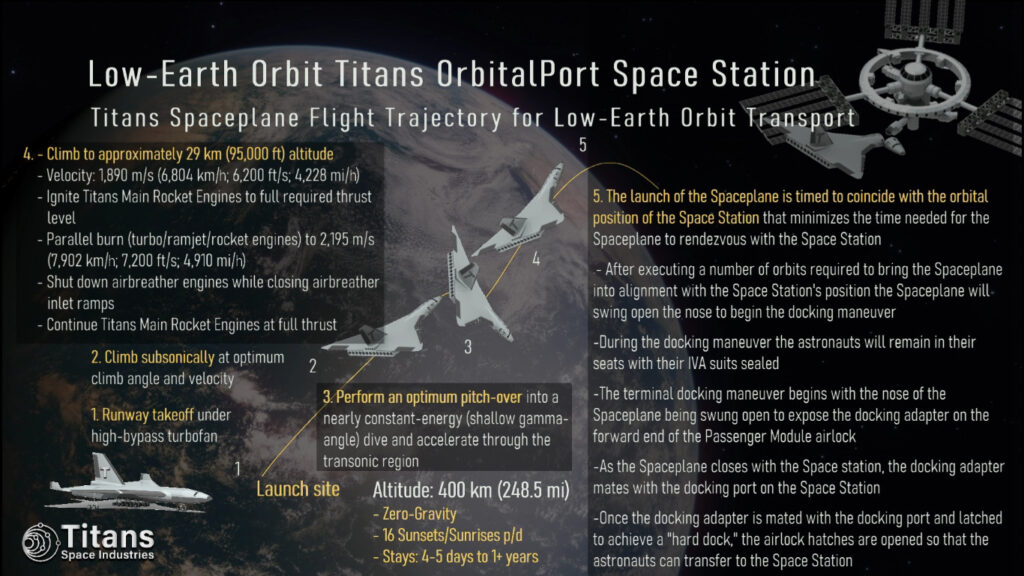
As you can see in the renderings, the Titans OrbitalPort Space Station is nothing like any Space station design you know.
Our Space station is a large structure and will always continue to be extended with (attached/semi-attached) modules. And... we will also build one in Lunar orbit.
The main differences between our Space stations and others are the structural size and the frequency they can be visited.
We will build the modules on Earth and then deliver them to Space with our own spaceplanes in order to assemble them on-orbit.
This is also the reason why all other proposed space stations look somewhat similar: cylindrical modules that are attached to each other. This design is decades old, and due to the need to launch them on rockets, they are severely limited in size and mass. The more weight, the more expensive it would be to assemble the space station on-orbit.
With our own spaceplanes. we don't have those kinds of limiting factors. As such, we can build and extend our space stations as we please.
The Titans Lunar Space Station will be assembled in lunar orbit where modules are first transported from Earth to LEO with spaceplanes, then transferred to Titans SpaceShips that will transport the modules to Lunar orbit.
Read more about the Titans LEO Space Hotel here.
Read more about the Titans Lunar Orbital Hotel here.
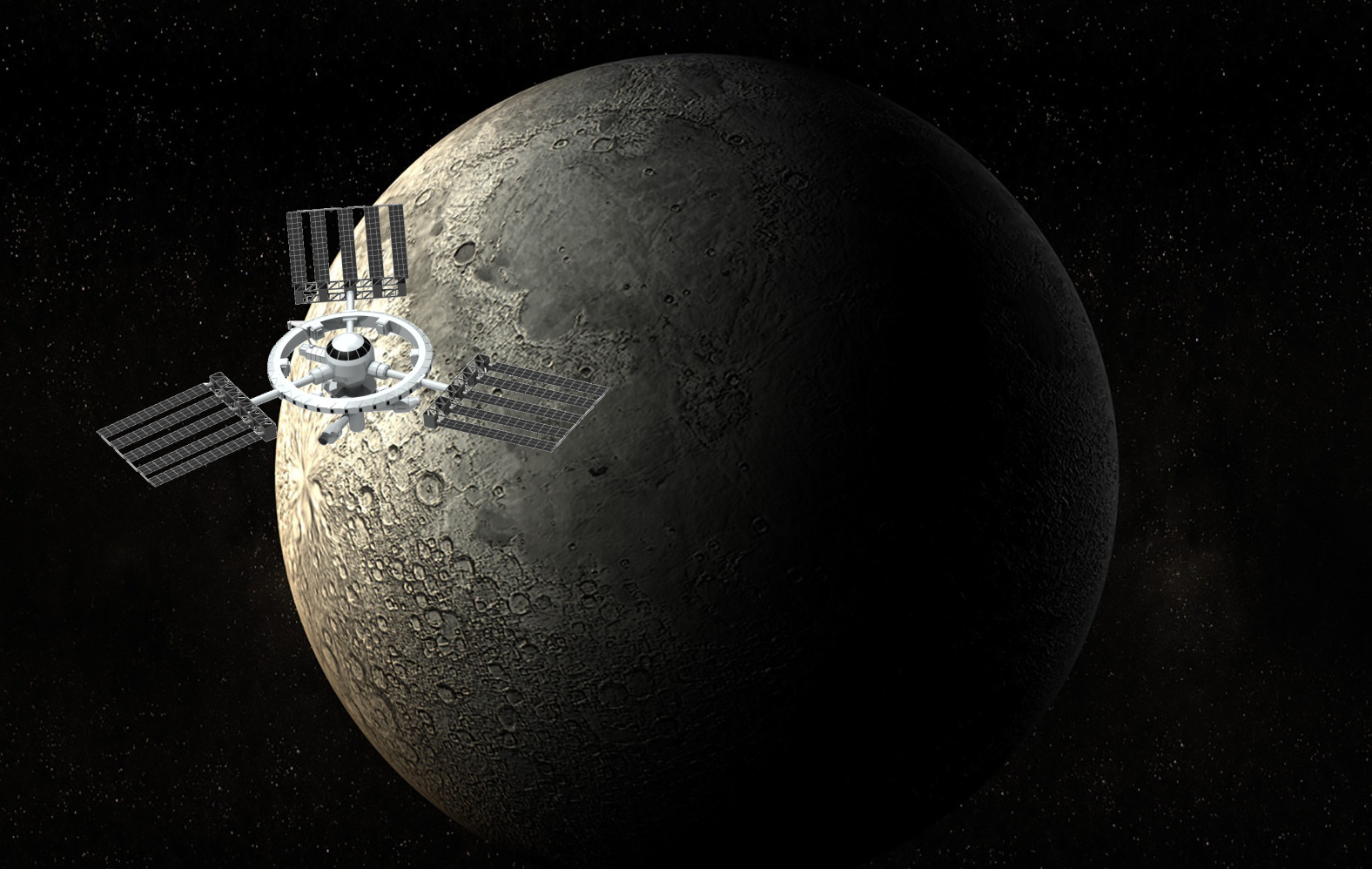
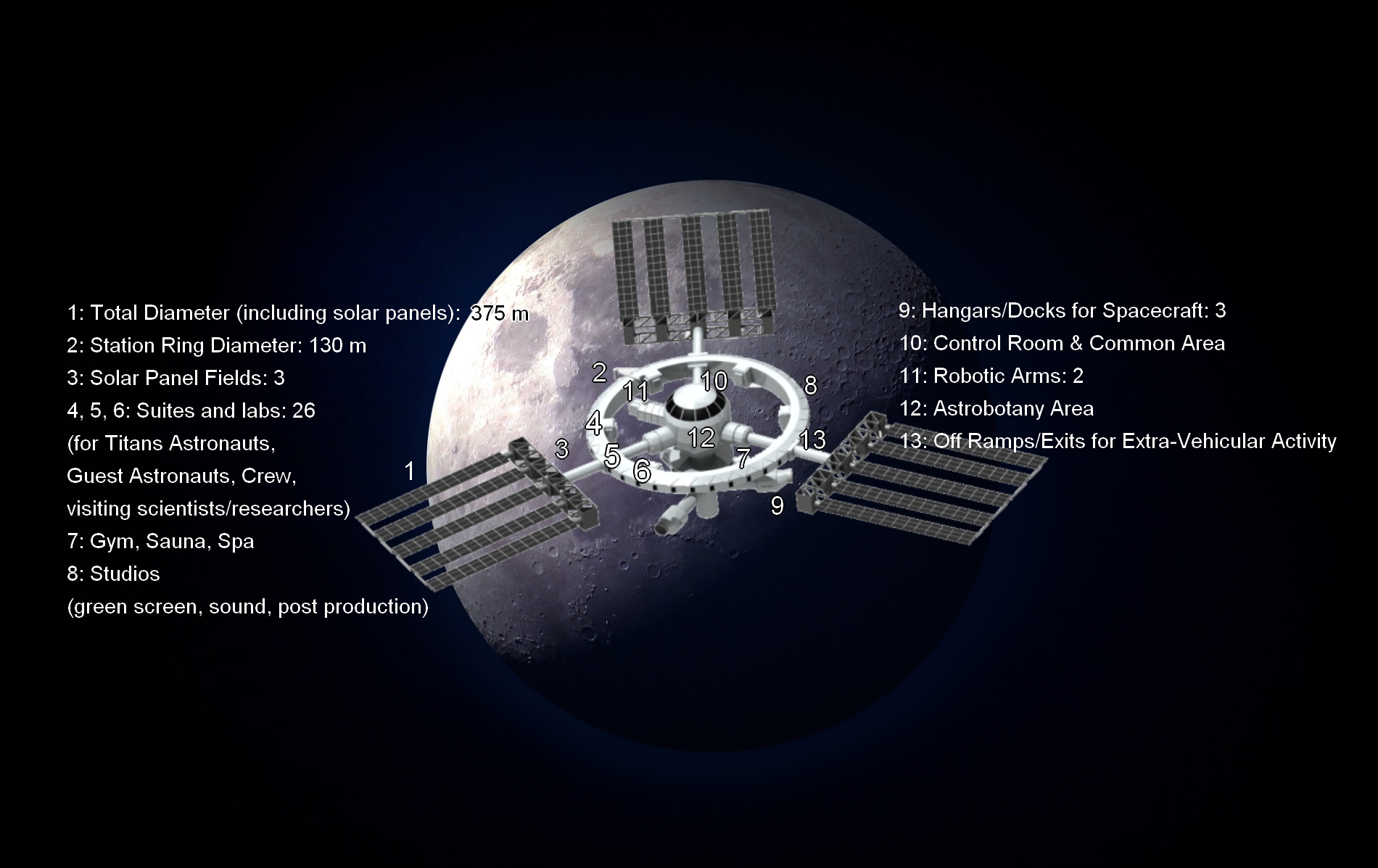
As you can see in the above rendering, the Lunar Titans OrbitalPort Space Station) is nothing like any space station you know.
Our Space station is a huge structure and will always continue to be extended with (attached/semi-attached) modules.
The main differences between our Space stations and others are the structural size, the amenities, and the frequency they can be visited.
We will build the Lunar Space Station modules on Earth and then deliver them to space with our own spaceplanes in order to assemble them in Lunar orbit.
This is also the reason why all other proposed space stations look somewhat similar: cylindrical modules that are attached to each other. This design is decades old, and due to the need to launch them on rockets, they are severely limited in size and mass. The more weight, the more expensive it would be to assemble the space station on-orbit.
With our own space transportation infrastructure we don't have those kinds of limiting factors. As such, we can build and extend our space stations as we please.
The Titans lunar space station will be assembled in lunar orbit where modules are first transported from Earth to LEO with spaceplanes, then transferred to Titans SpaceShips that will transport the modules to Lunar orbit.
Read more about the Titans LEO Space Hotel here.
Read more about the Titans Lunar Orbital Hotel here.

There is no need for an extensive training program to go to space with Titans Space.
Even seniors have gone to space.
William Shatner (90 years old): In October 2021, Captain Kirk himself, William Shatner, blasted off on Blue Origin's New Shepard rocket, becoming the oldest person to reach space. At 90 years and 177 days old, he broke the record previously held by Wally Funk (82) who flew on the same spacecraft just months earlier.
Wally Funk (82 years old): In July 2021, aviation pioneer Wally Funk finally fulfilled her lifelong dream of reaching space at the age of 82. Selected for NASA's astronaut training program in the 1960s but ultimately grounded due to her gender, Funk joined Jeff Bezos and three others on Blue Origin's historic first crewed flight.
Visit the Sub-Orbital Zero-G flights or the Orbital Cruises sections to learn more about the experience.
Yes, the Titans Spaceplanes are built for ultra-efficient operations, which include quick turnarounds and frequent flights.
Our spacecraft are designed with robust durable systems that require the minimum in maintenance and launch preparation.

Every landing attempt by Apollo astronauts was successful: 7 out of 7.
Our Lunar Yacht Transporters will follow the Apollo philosophy of having an autonomous system which human pilots monitor and can override if they see a problem developing, such as where the vehicle is landing.
Furthermore, one critical design feature will be the addition of downward-facing windows, which will allow the crew to view the surface under the yacht.
Also, unlike the Apollo astronauts, yacht pilots will be trained in simulators that don't require flying an actual vehicle.
We'll start with several spaceplanes, (for our own use and to lease to military and government clients), two Space stations (LEO and Lunar), two spaceships, and two Lunar transporters. We will replace and add spacecraft as we deem necessary.
Titans Point-to-Point Ultra-Fast Travel
The vehicles will pass through the supersonic and hypersonic regimes during ascent to space (and reentry).
As to the speed, there are a lot of variables, but we assume (for now) at least 3,000 mph (Mach 3.6), maybe closer to 5,000 mph (Mach 6.5), going by the X-15 space flights and the Shephard and Grissom suborbital flights in Mercury.
In fact, the ultra-fast travel experience is identical to the Sub-Orbital Zero-G flight experience.
For Space flights (e.g. Orbital Cruises), Titans Spaceplanes will fly at orbital velocity (17,500 mph) at an altitude of ~300 km (186 miles).
1. Orbital Cruise - Flight Trajectory

2. Sub-Orbital Zero-G Flight Trajectory

3. Space Station - Transport Trajectory

Different from orbital flights, when utilizing a ballistic arc trajectory, the Titans Spaceplane will not achieve orbital velocity. Instead, the vehicle climbs out of the atmosphere at speeds below orbital velocity. This is the Sub-Orbital transport trajectory.
The Titans Spaceplane will ascend to approximately 200 kilometers (apogee, 124 miles), and continue its descent to the destination airport or spaceport.
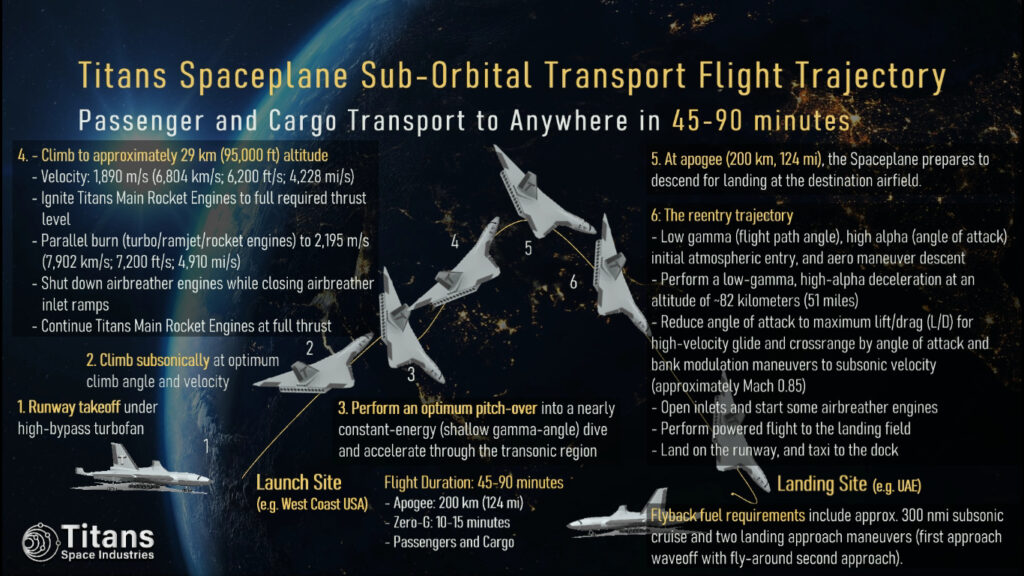
Indeed.
Titans Spaceplanes are primarily designed for Low-Earth Orbit purposes, not for sustained supersonic or hypersonic flight. The vehicles will pass through the supersonic and hypersonic regimes during ascent to space and reentry.
The Titans Spaceplane will ascend to approximately 200 kilometers (apogee, 124 miles), and continue its descent to the destination airport or spaceport.

That is correct.
The International Astronautics Federation accepts 100 km (the Karman Line) as the border where you'll be officially in space, and as such, become an Astronaut.
NASA keeps 80 kilometers as the border between Earth and Space.
The Titans Spaceplanes are not booster rockets; this eliminates the hazards of the space rockets people are familiar with.
The wings of the Titans Spaceplane also serve as an abort system that allows the Spaceplane to glide to a safe landing.
But there are also a number of unique safety features for the Titans Spaceplanes
Passenger Module (Passenger Cabin)
The Passenger Module is a separate module which mounts to the floor of the cargo bay. This modular
approach provides complete isolation of the passengers from smoke and fire in a crash landing as well as allowing the exterior of the Passenger Module to be covered by fireproof ceramic blankets similar to those used on the outside of the space shuttle. The Passenger Module is divided into two decks with
each deck having its own tunnel connecting it to the Crew Module in the nose. Inside the Passenger Module a spiral staircase connects the upper and lower decks.
Emergency Egress
Normal ingress/egress as well as egress for evacuation is provided by two doors in the nose. The
two viewing cupolas in the roof double as a hatch for emergency egress.
Upholstery and Carpeting
The interior design of the Passenger Module minimizes the chances of fire or toxic smoke through using naturally fire resistant wool carpeting and seat upholstery instead of flammable synthetic fibers.
"Spacepod" Encapsulated Seats
The biggest safety innovation of the Titans Spaceplane is the Spacepod Encapsulated Seats for the
Passenger Module. These Spacepod seats use individual clamshell enclosures which are normally open
during the flight but in the event of depressurization or other emergency slide down and enclose the seat,
maintaining the passenger in a breathable atmosphere with their own ECLSS system without the discomfort and claustrophobia of an IVA suit. The passenger can also use the clamshell enclosure during the flight for privacy. Instead of overhead bins, each passenger uses a fireproof compartment on the Spacepod to store their carry-on luggage, if any.


IVA Suits for Pilots and Crew
The pilots, stewards, and other flight crew wear IVA suits for the duration of the flight. This allows the pilots to operate the Spaceplane normally while giving stewards the mobility needed for attending to passengers, including verifying that the Spacepod clamshells are properly sealed if needed.
Rocket lift-off requires passengers to remain in reclined position, strapped into their seats; Titans passengers will experience airplane-like comfort and ease.
To avoid supersonic flight (and its resulting sonic boom during descent) over populated areas, the vehicles reenter over the ocean, then cruise at subsonic speed to the destination airfield.
In fact, the ultra-fast travel experience is identical to the Sub-Orbital Zero-G flight experience.
The Titans Spaceplane will ascend to approximately 200 kilometers (apogee, 124 miles), and continue its descent to the destination airport or spaceport.


There is no need for an extensive training program to go to space with Titans Space.
Even seniors have gone to space.
William Shatner (90 years old): In October 2021, Captain Kirk himself, William Shatner, blasted off on Blue Origin's New Shepard rocket, becoming the oldest person to reach space. At 90 years and 177 days old, he broke the record previously held by Wally Funk (82) who flew on the same spacecraft just months earlier.
Wally Funk (82 years old): In July 2021, aviation pioneer Wally Funk finally fulfilled her lifelong dream of reaching space at the age of 82. Selected for NASA's astronaut training program in the 1960s but ultimately grounded due to her gender, Funk joined Jeff Bezos and three others on Blue Origin's historic first crewed flight.
Visit the Sub-Orbital Zero-G flights or the Orbital Cruises sections to learn more about the experience.
Yes, our flyers will experience zero-g at the top of the arc for ten to fifteen minutes, double what Virgin Galactic and Blue Origin offer, and you will see more of Earth during the 90-minute experience.
In fact, the ultra-fast travel experience is identical to the Sub-Orbital Zero-G flight experience.
The Titans Spaceplane will ascend to approximately 200 kilometers (apogee, 124 miles), and continue its descent to the destination airport or spaceport.

Yes, the Titans Spaceplanes are built for ultra-efficient operations, which include quick turnarounds and frequent flights.
Our spacecraft are designed with robust durable systems that require the minimum in maintenance and launch preparation.
About the Titans Space Tourism offers
Space Tourism will become mainstream from 2027 onward - as soon as the Titans Spaceplanes become operational.
Titans Space's immediate focus with its revolutionary Spaceplanes is to make affordable Space tourism possible on a large scale, with prices for Sub-Orbital Zero-G flights starting at just $25,000, and Orbital Cruises starting at $200,000.
We have two short-duration space flights:
1. Orbital Cruises (~5 hours)
2. Sub-Orbital Zero-G Flights (~90 minutes)
The Sub-Orbital Zero-G flights are somewhat similar to the Blue Origin and Virgin Galactic experiences, but the flight will last for 90 minutes. The zero-g duration is almost double (10-15 minutes), and you'll get to see more of Earth!
You'll take off from one of our spaceport facilities (e.g. in the USA), and you will end up at another partner spaceport, which may be halfway across the world.
Orbital cruises are a more extensive and thrilling experience than with Blue Origin and Virgin Galactic.
An Orbital Cruise will last around five hours, taking you around the world twice (i.e. two 90-minute orbits), and you can float (in zero-gravity) for approximately three hours.
You will see two sunrises and two sunsets.
Furthermore, the trip is safe and comfortable, because you take off just like on an airplane.
The Titans Spaceplane that takes you to space is the first spaceplane to take off from a runway.
- Learn more about the Orbital Cruises here.
- Learn more about Sub-Orbital Zero-G Flights here.
- Learn more about Ultra-Fast Travel here.
- Learn more about the Titans Spaceplanes here.


The Sub-Orbital Zero-G flights are somewhat similar to the Blue Origin and Virgin Galactic experiences, but the flight will last for 90 minutes. The zero-g duration with us is at least twice longer (10-15 minutes) - you'll get to see more of Earth!
You'll take off from our spaceport facilities (e.g. in the USA), and you will end up at another partner spaceport, which may be halfway across the world.
The Titans Spaceplane that takes you to space is the first spaceplane to take off from a runway.

Orbital Cruises are a more extensive and thrilling experience than with Blue Origin and Virgin Galactic.
An Orbital Cruise will last around five hours, taking you around the world twice (i.e. two 90-minute orbits), and you can float (in zero-gravity) for approximately three hours.
You will see two sunrises and two sunsets.
Furthermore, the trip is safe and comfortable, because you take off just like on an airplane.
The Titans Spaceplane that takes you to space is the first spaceplane to take off from a runway.

Lunar industrialization, which includes mining and a large lunar resort, is at the core of our company objectives. As such, the travel experience to the Moon (and back) should be safe, efficient, and comfortable. You can view the LEO Space travel trajectory below (images).
The entire Titans end-to-end human Space travel infrastructure is centered around these three core principles. It's as simple as that.
Our vehicles are designed with the latest technologies to ensure that the dangers of Space travel are minimized and in some cases completely removed.
Before we put people on our vehicles, they will be put through rigorous testing procedures. All vehicles will have to perform perfectly before we start operations.
- Learn more about Titans Spaceplanes here.
- Learn more about Orbital Cruises here.
- Learn more about Sub-Orbital Zero-G Flights here.
- Learn more about LEO Space Hotel here.
- Learn more about Titans SpaceShips here.
- Learn more about Lunar Orbital Hotel here.
- Learn more about Titania Lunar Resort here.
- Learn more about the Titans Lunar Yachts here
1. Orbital Cruise - Flight Trajectory

2. Sub-Orbital Zero-G Flight Trajectory

3. Space Station - Trajectory




The short answer
We have a significantly easier way to travel to the Moon, and because we can deliver virtually unlimited cargo to the Moon from Earth and Low-Earth Orbit - something no other company can accomplish.
Titans Space Industries (TSI) was founded with lunar mining and industrialization of the Moon as the company's main objective.
The long answer:
Currently, all Space travel and space launch missions are severely restricted because there is only one way to go to space (and to the Moon and further): Rockets.
Most Space projects depend on government grants and/or contracts while TSI is fully independent and gets its revenues from multiple sources.
This is where the Titans end-to-end Space transportation systems (consisting of reusable spaceplanes, spaceships, Space stations, and lunar transporters) bring about a revolutionary paradigm shift.
The Titania Lunar Colony will start small and in a very basic configuration, but it will always be extended.
The main differences between our lunar colony and other Moon base plans are rooted in the fact that we own our own end-to-end (Earth surface to Lunar surface and vice versa) Space transportation infrastructure.
We will build modules for the lunar colony on Earth, then transport them from Earth to LEO with a Titans Spaceplane and launch them to Lunar orbit, or transfer them to a Titans SpaceShip that will transport the modules to the Lunar Titans OrbitalPort Space Station (Lunar TOPSS). The Lunar Transporter will deliver the modules to the Lunar surface.
Fun fact: our lunar colony will have its own mass driver that will launch cargo to Earth (once we get nuclear power up and running).
Read more about the Titans Lunar Orbital Hotel here.
Read more about the Titania Lunar Colony here.
TSI, with support from the Titans Space Society and Titans Astronauts, paves the way for millions of people to travel to space and visit our Titania Lunar colony.
The Titans Space Society is a closed fellowship that is reserved for Titans Astronauts, a group of wealthy well-wishers of humanity who are essential to the realization of Titans Space Industries projects, including spaceplanes, spaceships, space stations, and a large lunar colony.
For the time being, Titans Space missions and/or projects are only accessible to Titans Astronauts and Guest Astronauts.
We will work with Titans Astronauts and sponsors to provide select individuals access to certain Titans Space missions and/or projects.
Follow us on social media to keep up to date.
Read more about the Selene Mission here. or read our CEO's Lunar tourism explainer on Linkedin.
The Titans Spaceplanes are not booster rockets; this eliminates the hazards of the space rockets people are familiar with.
The wings of the Titans Spaceplane also serve as an abort system that allows the Spaceplane to glide to a safe landing.
But there are also a number of unique safety features for the Titans Spaceplanes
Passenger Module (Passenger Cabin)
The Passenger Module is a separate module which mounts to the floor of the cargo bay. This modular
approach provides complete isolation of the passengers from smoke and fire in a crash landing as well as allowing the exterior of the Passenger Module to be covered by fireproof ceramic blankets similar to those used on the outside of the space shuttle. The Passenger Module is divided into two decks with
each deck having its own tunnel connecting it to the Crew Module in the nose. Inside the Passenger Module a spiral staircase connects the upper and lower decks.
Emergency Egress
Normal ingress/egress as well as egress for evacuation is provided by two doors in the nose. The
two viewing cupolas in the roof double as a hatch for emergency egress.
Upholstery and Carpeting
The interior design of the Passenger Module minimizes the chances of fire or toxic smoke through using naturally fire resistant wool carpeting and seat upholstery instead of flammable synthetic fibers.
"Spacepod" Encapsulated Seats
The biggest safety innovation of the Titans Spaceplane is the Spacepod Encapsulated Seats for the
Passenger Module. These Spacepod seats use individual clamshell enclosures which are normally open
during the flight but in the event of depressurization or other emergency slide down and enclose the seat,
maintaining the passenger in a breathable atmosphere with their own ECLSS system without the discomfort and claustrophobia of an IVA suit. The passenger can also use the clamshell enclosure during the flight for privacy. Instead of overhead bins, each passenger uses a fireproof compartment on the Spacepod to store their carry-on luggage, if any.


IVA Suits for Pilots and Crew
The pilots, stewards, and other flight crew wear IVA suits for the duration of the flight. This allows the pilots to operate the Spaceplane normally while giving stewards the mobility needed for attending to passengers, including verifying that the Spacepod clamshells are properly sealed if needed.
Our Astronauts remain inside the spaceplane, so there is no need for a spacesuit.
The biggest safety innovation of the Titans Spaceplane is the Spacepod Encapsulated Seats for the Passenger Module. These Spacepod seats use individual clamshell enclosures that are normally open during the flight but in the event of depressurization or other emergency, slide down and enclose the seat, maintaining the passenger in a breathable atmosphere with their own ECLSS system without the discomfort and claustrophobia of an IVA suit. The passenger can also use the clamshell enclosure during the flight for privacy. Instead of overhead bins, each passenger uses a fireproof compartment on the Spacepod to store their carry-on luggage, if any.

Learn more about the Orbital Cruise experience here, and the Sub-Orbital Zero-G Flight experience here.
Learn more about the Titans Spaceplanes here.
For Space flights (e.g. Orbital Cruises), Titans Spaceplanes will fly at orbital velocity (17,500 mph) at an altitude of ~300 km (186 miles).
1. Orbital Cruise - Flight Trajectory

2. Sub-Orbital Zero-G Flight Trajectory

3. Space Station - Transport Trajectory


There is no need for an extensive training program to go to space with Titans Space.
Even seniors have gone to space.
William Shatner (90 years old): In October 2021, Captain Kirk himself, William Shatner, blasted off on Blue Origin's New Shepard rocket, becoming the oldest person to reach space. At 90 years and 177 days old, he broke the record previously held by Wally Funk (82) who flew on the same spacecraft just months earlier.
Wally Funk (82 years old): In July 2021, aviation pioneer Wally Funk finally fulfilled her lifelong dream of reaching space at the age of 82. Selected for NASA's astronaut training program in the 1960s but ultimately grounded due to her gender, Funk joined Jeff Bezos and three others on Blue Origin's historic first crewed flight.
Visit the Sub-Orbital Zero-G flights or the Orbital Cruises sections to learn more about the experience.
Most definitely. No other Space tourism/transport vehicle is safer than the Titans Spaceplanes.
The Titans Spaceplanes are not booster rockets; this eliminates the hazards of the space rockets people are familiar with.
The wings of the Titans Spaceplane also serve as an abort system that allows the Spaceplane to glide to a safe landing.
But there are also a number of unique safety features for the Titans Spaceplanes
Passenger Module (Passenger Cabin)
The Passenger Module is a separate module which mounts to the floor of the cargo bay. This modular
approach provides complete isolation of the passengers from smoke and fire in a crash landing as well as allowing the exterior of the Passenger Module to be covered by fireproof ceramic blankets similar to those used on the outside of the space shuttle. The Passenger Module is divided into two decks with
each deck having its own tunnel connecting it to the Crew Module in the nose. Inside the Passenger Module a spiral staircase connects the upper and lower decks.
Emergency Egress
Normal ingress/egress as well as egress for evacuation is provided by two doors in the nose. The
two viewing cupolas in the roof double as a hatch for emergency egress.
Upholstery and Carpeting
The interior design of the Passenger Module minimizes the chances of fire or toxic smoke through using naturally fire resistant wool carpeting and seat upholstery instead of flammable synthetic fibers.
"Spacepod" Encapsulated Seats
The biggest safety innovation of the Titans Spaceplane is the Spacepod Encapsulated Seats for the
Passenger Module. These Spacepod seats use individual clamshell enclosures which are normally open
during the flight but in the event of depressurization or other emergency slide down and enclose the seat,
maintaining the passenger in a breathable atmosphere with their own ECLSS system without the discomfort and claustrophobia of an IVA suit. The passenger can also use the clamshell enclosure during the flight for privacy. Instead of overhead bins, each passenger uses a fireproof compartment on the Spacepod to store their carry-on luggage, if any.


IVA Suits for Pilots and Crew
The pilots, stewards, and other flight crew wear IVA suits for the duration of the flight. This allows the pilots to operate the Spaceplane normally while giving stewards the mobility needed for attending to passengers, including verifying that the Spacepod clamshells are properly sealed if needed.
Yes, you are free to do anything you like. We'll also provide in-flight Wi-Fi so that you can post selfies, videos, and status updates.
For safety reasons, recordings of our facilities and hangars will not be allowed.
Yes, Titans Spaceplanes are built for ultra-efficient operations, which include quick turnarounds and frequent flights.
Titans Spaceplanes are designed with robust durable systems that require the minimum in maintenance and launch preparation.
The rocket engines are specifically developed for the spaceplane, and built to be workhorses designed for aircraft operation instead of the highly stressed engines used in the space rockets people know about.
Learn more about the Titans Spaceplanes here.
About The Selene Mission
Both NASA and Titans Space draw inspiration from Greek mythology for their lunar missions.
While NASA channels the Moon's brilliance with "Artemis," Titans Space embraces the Moon's essence, aptly naming its Moon mission after the Titan goddess Selene.
Recognizing the tremendous work of NASA's Artemis mission, Titans Space introduces a leaner, more budget-conscious solution, aiming to achieve large-scale permanent settlement of the Moon earlier and at a significantly lower cost - mostly funded by Titans Astronauts.
While NASA and others see settlement of the Moon as a stepping stone for other missions, such as Mars exporation, large-scale settlement is not their priority.
For Titans Space, however, large-scale settlement and industrialization of the Moon and building out Titania Lunar is the end goal. We are not particularly interested in missions beyond the Moon.
Read more about the Selene Mission here. or read our CEO's Selene Mission and Lunar colony explainer on Linkedin.
Read more about Titania Lunar Colony here.
Read more about Titania Lunar Resort here.
Read more about the Titans Lunar Orbital Hotel here.
Read more about Titania Lunar Industries here.
The short answer is: No.
The long answer:
The incredible Artemis missions are an ambitious undertaking spearheaded by NASA,
aiming to re-establish human presence on the Moon and pave the way for further exploration
of deep space. NASA's and its partners' focus is mainly on science.
While NASA and others see settlement of the Moon as a stepping stone for other missions,
such as Mars exporation, large-scale settlement is not their priority.
For Titans Space, however, large-scale settlment of the Moon and building out Titania Lunar is the end goal. We are not focusing on missions beyond the Moon.
The Selene Mission consists of several parts, and all crew members will undergo an intensive 24-month training.
Crew announcements will follow shortly, but we can already state that one of them is an Architecture technologist and
Launching Astronauts who got upgraded to also participate in the Seline Mission.Titans Space's CEO, Neal Lachman, who is responsible for the spacecraft designs and engineering together with CTO Franklin Ratliff,
will also be part of the crew on all Selene missions as a specialist.
Leveraging innovative funding models, Titans Space's Selene mission demonstrates a path towards lunar exploration at a significantly lower cost compared to traditional space programs, such as NASA's Artemis mission.
While a portion of the funding originates from the Titans Astronaut program, additional undisclosed stakeholders with vested interests in permanent lunar settlements contribute to the mission's viability. These strategic partnerships remain confidential until Titans Space's official public launch or until the respective partners choose to make an announcement.
Read more about the Titans Astronauts here.
We expect to have the initial parts of the Lunar Space Station in Lunar orbit by 2028. The developments in Lunar orbit and on the Lunar surface will follow shortly after.
Learn more about the Titans Lunar Orbital Hotel here.
Read more about the Selene Mission here.
Read more about Titania Lunar Colony here.
Read more about Titania Lunar Resort here.
Read more about Titania Lunar Industries here.



The short answer
We have a significantly easier way to travel to the Moon, and because we can deliver virtually unlimited cargo to the Moon from Earth and Low-Earth Orbit - something no other company can accomplish.
Titans Space Industries (TSI) was founded with lunar mining and industrialization of the Moon as the company's main objective.
The long answer:
Currently, all Space travel and space launch missions are severely restricted because there is only one way to go to space (and to the Moon and further): Rockets.
Most Space projects depend on government grants and/or contracts while TSI is fully independent and gets its revenues from multiple sources.
This is where the Titans end-to-end Space transportation systems (consisting of reusable spaceplanes, spaceships, Space stations, and lunar transporters) bring about a revolutionary paradigm shift.
The Titania Lunar Colony will start small and in a very basic configuration, but it will always be extended.
The main differences between our lunar colony and other Moon base plans are rooted in the fact that we own our own end-to-end (Earth surface to Lunar surface and vice versa) Space transportation infrastructure.
We will build modules for the lunar colony on Earth, then transport them from Earth to LEO with a Titans Spaceplane, and then transfer them to a Titans SpaceShip that will transport the modules to the Lunar Titans OrbitalPort Space Station (Lunar TOPSS). The Lunar Transporter will deliver the modules to the Lunar surface.
Fun fact: our lunar colony will have its own mass driver that will launch cargo to Earth (once we get nuclear power up and running).
Learn more about the Titans Lunar Orbital Hotel here.
Read more about the Selene Mission here.
Read more about Titania Lunar Colony here.
Read more about Titania Lunar Resort here.
Read more about Titania Lunar Industries here.
About Titania Lunar Resort
Yes, as stated in the Core Business part of the "About Titans Space" section of this FAQ, our primary objective is to build a large lunar colony.
Titania Lunar Resort is part of the lunar colony development.
All projects you read about on our websites are meant to support our ultimate objective to build and operate a large colony and to mine the Moon. This relates to building our proprietary infrastructure (ranging from spaceplanes that take off from a runway on Earth, to spacecraft, to a lunar colony), as well as generating revenue (thanks to that infrastructure).
A large colony on the Moon with permanent human presence also means there has to be recreational opportunities.
The Titania Lunar Resort serves as a recreational facility for workers as well as a tourist destination.
Read more about the Selene Mission here. or read our CEO's Lunar tourism explainer on Linkedin.
Titans Space's objective is to enable large-scale lunar tourism and industry.
NASA and other space agencies have a more science-focused approach, for which the Lunar South Pole is an exciting location.
Furthermore, the Titans Space ttransport infrastructure allows for large quantities of supplies (water, food, consumables, energy, etc.) to be brought from Earth to Titania Lunar at the near-Equator site and then transported to other locations, including the South Pole. As such, we can supply and even conduct rescue missions to the South Pole.
Some of the specific benefits of our first permanent colony at ta near-equatorial site.
Sunlight and Power Generation
More consistent access to sunlight: The lunar equator experiences nearly two weeks of continuous sunlight followed by two weeks of darkness, unlike the south pole which has long periods of darkness. This longer duration of sunlight makes it easier to generate solar power for the base, reducing reliance on other sources and lowering operational costs.
Reduced need for complex lighting systems: With more abundant sunlight, the need for extensive artificial lighting infrastructure and associated energy consumption becomes less critical.
Temperature and Stability
Moderately cooler temperatures: While both sides of the Moon experience extreme temperature swings, the equator generally tends to be slightly cooler than the poles during lunar day. This could make it more comfortable for astronauts and easier to manage thermal control systems.
More stable regolith: The regolith (lunar soil) in the equatorial regions is thought to be less prone to freezing and thawing cycles compared to the south pole. This could make it more stable for construction and potentially easier to develop infrastructure.
Resource Access and Exploration
Greater access to water ice: Recent discoveries suggest the presence of water ice in permanently shadowed craters closer to the poles. While not directly on the equator, a base there could benefit from easier access to these potential resources for future scientific study or utilization.
Diverse geological features: The lunar equator offers a wider variety of geological features compared to the south pole, which mainly consists of flat plains and craters. This diversity could create more attractive landscapes for tourists and provide opportunities for diverse exploration activities.
Logistical Advantages
Easier launch and landing trajectories: Launching and landing spacecraft on the lunar equator requires less complex orbital maneuvers compared to the south pole, lowering mission costs and risks.
Improved communication with Earth: The lunar equator offers a more direct line-of-sight communication path with Earth, enabling faster and more reliable communication for the base.
A large colony on the Moon with permanent human presence also means there has to be recreational opportunities.
The Titania Lunar Resort serves as a recreational facility for workers as well as a tourist destination.
- Learn more about the Titans Spaceships here.
- Learn more about the Lunar Transporter here.
- Learn more about the Titans Lunar Orbital Space Hotel here.
- Learn more about Titania Lunar Resort here.
It starts with your flight to the LEO Space Station. Learn more about that experience here, and view the flight trajectory below.

Not really. We plan to build Titania Lunar Colony (and as such, Titania Lunar Resort, which is part of it) fast and on a large scale.
Our colony will be a huge development, and it will always continue to be extended.
The main differences between our Lunar colony and others are the size of the development, the amenities, and the frequency we can visit (and transport valuable cargo back and forth).
NASA and others are severely restricted in their ambitions and plans because they have only one way to reach the Moon: rockets.
Because we have our end-to-end space transportation infrastructure, we can be do and achieve much more, much better, and much faster. Where a rocket launch to lunar orbit costs anywhere between $200 million and $2 billion, we can do that for a fraction of that cost. And while rockets are limited in their launch cadence, our Spaceplanes and spaceships can take off on a daily basis.
We will build modules for the lunar colony on Earth, then transport them from Earth to LEO with Spaceplanes and then transfer them to Titans SpaceShips that will transport the modules to the Titans Lunar OrbitalPort Space Station. The Lunar Transporter will deliver the modules to the lunar surface.



The short answer
We have a significantly easier way to travel to the Moon, and because we can deliver virtually unlimited cargo to the Moon from Earth and Low-Earth Orbit - something no other company can accomplish.
Titans Space Industries (TSI) was founded with lunar mining and industrialization of the Moon as the company's main objective.
The long answer:
Currently, all Space travel and space launch missions are severely restricted because there is only one way to go to space (and to the Moon and further): Rockets.
Most Space projects depend on government grants and/or contracts while TSI is fully independent and gets its revenues from multiple sources.
This is where the Titans end-to-end Space transportation systems (consisting of reusable spaceplanes, spaceships, Space stations, and lunar transporters) bring about a revolutionary paradigm shift.
The Titania Lunar Colony will start small and in a very basic configuration, but it will always be extended.
The main differences between our lunar colony and other Moon base plans are rooted in the fact that we own our own end-to-end (Earth surface to Lunar surface and vice versa) Space transportation infrastructure.
We will build modules for the lunar colony on Earth, then transport them from Earth to LEO with a Titans Spaceplane, and then transfer them to a Titans SpaceShip that will transport the modules to the Lunar Titans OrbitalPort Space Station (Lunar TOPSS). The Lunar Transporter will deliver the modules to the Lunar surface.
Fun fact: our lunar colony will have its own mass driver that will launch cargo to Earth (once we get nuclear power up and running).
Learn more about the Titans Lunar Orbital Hotel here.
Learn more about the Titania Lunar Colony here.
Our business model doesn't revolve around Space agencies.
In fact, for our Lunar projects, we are focusing on private Space tourism first and foremost, especially Titans Astronauts. This will allow us to continuously build out Titania Lunar Colony.
Learn more about Titans Astronauts here.
Learn more about the Titans Lunar Orbital Hotel here.
Learn more about the Titania Lunar Colony here.
TSI, with support from the Titans Space Society and Titans Astronauts, paves the way for millions of people to travel to space and visit our Titania Lunar colony.
The Titans Space Society is a closed fellowship that is reserved for Titans Astronauts, a group of wealthy well-wishers of humanity who are essential to the realization of Titans Space Industries projects, including spaceplanes, spaceships, space stations, and a large lunar colony.
For now, Titans Space missions and/or projects are only accessible to Titans Astronauts and Guest Astronauts.
We will work with Titans Astronauts and sponsors to provide select individuals access to certain Titans Space missions and/or projects.
Follow us on social media to keep up to date.
Astronauts going to the Lunar Space Station or Titania Lunar Colony will receive special training to prepare them for their travel to and stay at the Space station or colony.
Read more about the Selene Mission here. or read our CEO's Lunar tourism explainer on Linkedin.
About the Titans Lunar Space Station

The Lunar Titans OrbitalPort Space Station (Lunar TOPSS) is part of our Space transportation and orbital infrastructure.
Titans OrbitalPorts are the largest planned Space stations, in the industry, purposed to become the primary destination for zero gravity research and development, with a focus on both scientific and commercial purposes.
Manufacturing and assembly of the Lunar OrbitalPort parts on Earth starts in 2025, and on-orbit construction starts in 2028.
Part of the Lunar TOPSS will be utilized as a Lunar Orbital Hotel.
Titans Space's objective is to practically always expand the OrbitalPort in a semi-detached modular fashion.
Ultimately, in the coming decades, thousands of visitors and twenty or more spaceplanes and spaceships will be accommodated at the LEO TOPSS and the Lunar TOPSS.

Titans OrbitalPorts are purposed to become the primary destination for zero gravity research and development, with a focus on both scientific and commercial purposes. They are also service locations for any on-orbit services and as transfer hubs for space travelers.
Part of the Lunar TOPSS will be utilized as a Lunar Orbital Hotel.
Titans Space's objective is to practically always expand the OrbitalPort in a semi-detached modular fashion.
For the first time in history, traveling to the Moon will be possible without the use of vertical rocket launches.
- Passengers and/or cargo are transported to Low-Earth Orbit on board a Titans Spaceplane.
- Cargo and/or passengers are transferred to a Titans SpaceShip, after which the spaceship takes off to the Moon with six to twenty passengers and 50-100 metric tons of cargo.
- The spaceship will dock at the Lunar Titans Orbital Port Space Station when reaching the Moon's orbit in approximately three days.
Included in the cargo bay of the first two spaceships will be a Titans Lunar Yacht Transporter that will ferry people and cargo to the lunar surface and back to the space station.
On-orbit refueling is accomplished by taking fuel tanks out of a Titans Spaceplane's payload bay and attaching them directly to the Titans SpaceShip, eliminating the need to move fuel from one tank to another in orbit.
The rest of the design and on-orbit refueling solutions (in Low-Earth Orbit and Low-Lunar Orbit) are confidential.

No, as of yet Titans Space is not convinced that artificial gravity is feasible. We'll let someone else invest in those developments.
The LEO and Lunar space stations will not be rotating spacecraft.
About Titans Space Society
The Titans Space Society is a closed fellowship that is reserved for Titans Astronauts, a group of wealthy well-wishers of humanity who are essential to the realization of Titans Space Industries projects, including spaceplanes, spaceships, space stations, and a large lunar colony.
There are many perks for Titans Astronauts as part of the Society.
The Titans Space Society holds monthly, bi-monthly, semi-annual, and annual events for its Fellows. The frequency and intensity of their involvement with TSI's projects is their own decision.
Titans Astronauts are afforded many unique perks, including but not limited to:
- Timeshare ownership of an apartment at the upcoming Titans Training Resort
- Unlimited Ultra-Fast Travel for the Titans + 1 (on a fair use basis)
- Unlimited Orbital Cruises (once per year with 1 guest)
- Timeshare ownership of a Titans Suite on the LEO Space Hotel (biennial with one guest)
- Timeshare ownership of a Titans Suite on the Lunar Orbital Hotel (quinquennial with one guest)
- Timeshare ownership of a Titans Suite at the Titania Lunar Resort
- Naming rights of structures, buildings, streets, etc. on Titans properties (on Earth, in space, and on the Moon)
- Much more... Contact us through the Titans Astronauts Contact Form if you are interested (provided upon qualification).
Titans Astronauts are of incredible importance to us.
The benefit of operating our own reusable spaceplanes, spacecraft, space stations, and lunar colony means that we can provide the most unique experiences practically as often as a Titans Astronaut desires.
Most Titans projects are developed with the ultimate benefit and comfort of Titans Astronauts in mind. Present and future projects and developments will be coordinated with Titans Astronauts, including the Titans Astronauts Training Resort as well as the Titans Facilities at our spaceport locations.
But we also have incredible non-space-related perks for Titans Astronauts!
- Titans Astronauts automatically become Titans Astronauts Fellows, gaining access to the Royal Rhodium membership tier, providing instant access to the world's most exclusive membership club with incredible perks.
For more information:
- Visit the Titans Astronauts page
- Visit the Titans Astronauts fellowship intro page
- Visit the Titans Astronauts Fellowship perks overview page
TSI, with support from the Titans Space Society and Titans Astronauts, paves the way for millions of people to travel to space and visit our Titania Lunar colony.
The Titans Space Society is a closed fellowship that is reserved for Titans Astronauts, a group of wealthy well-wishers of humanity who are essential to the realization of Titans Space Industries projects, including spaceplanes, spaceships, space stations, and a large lunar colony.
The Titans Space Society is as much about business and serious issues as it is about fun and adventure. Titans Astronauts are Titans Space Society Fellows.
The Titans Space Society is exclusively accessible to Titans Astronauts, a group of ultra-high-net-worth individuals organized by TSI.
TSI and the Titans Space Society will work closely with other space agencies on international space development.
At present, the Titans Space Society is exclusively accessible to Titans Astronauts, a group of ultra-high-net-worth individuals organized by TSI.
We will work with Titans Astronauts and sponsors to provide select individuals access to certain Titans Space missions and/or projects.
Follow us on social media to keep up to date.
About Crewed Mars Mission: 2032
In beginning 2024, we submitted our updated response to NASA's RFI for Moon to Mars mission objectives. This document outlined our "Selene Mission" architecture, designed to deliver astronautsto the lunar surface. Furthermore, it hinted at the adaptability of our spacecraft for future Mars missions. However, unbeknownst to many, Titans Space has been quietly but diligently developing a comprehensive Mars mission architecture for quite some time.
Titans Space's Crewed Mars Mission: 2032 would have remained a stealth project until 2025, but now that NASA is revamping its Mars Sample Return program, aiming to get Martian rock and soil samples back to Earth sooner and cheaper, we deem now the right time to make our intentions public.
The original Mars Sample Return mission was estimated to cost $11 billion and take until the 2040s – a timeline and price tag deemed unacceptable by NASA.
NASA's new approach seeks innovative designs to bring down those costs and expedite the mission. NASA is calling on the NASA community to brainstorm a revised plan that utilizes both cutting-edge and proven technologies. Additionally, NASA is looking for proposals from private companies for creative solutions to retrieve the samples by the 2030s. This focus on collaboration and fresh ideas signifies a shift from the previous, more expensive approach.
These recent developments have motivated us to formally propose our capabilities and contribute to this critical space exploration endeavor. We will respond to NASA's upcoming RFI and also share it with the public in due time. For now, our summarized white paper serves to inform the public and all (potential) stakeholders of our planned architecture.
Read the White Paper on Linkedin.
The short answer is: No, we aim to be the operator selected by NASA to conduct the Mars Return Mission, but with a crew rather than just robotics.
The long answer:
The original Mars Sample Return mission was estimated to cost $11 billion and take until the 2040s – a timeline and price tag deemed unacceptable by NASA.
NASA's new approach seeks innovative designs to bring down those costs and expedite the mission. NASA is calling on the NASA community to brainstorm a revised plan that utilizes both cutting-edge and proven technologies. Additionally, NASA is looking for proposals from private companies for creative solutions to retrieve the samples by the 2030s. This focus on collaboration and fresh ideas signifies a shift from the previous, more expensive approach.
These recent developments have motivated us to formally propose our capabilities and contribute to this critical space exploration endeavor. We will respond to NASA's upcoming RFI and also share it with the public in due time. For now, this summarized white paper serves to inform the public and all (potential) stakeholders of our planned architecture.
Titans Space is proposing a highly feasible architecture for delivering Martian samples to NASA by 2034.
This mission leverages our cutting-edge technologies and offers the opportunity for NASA (and international) astronauts to participate in this historic endeavor.
- Cost-Effective Solution: TSI's architecture provides a cost-competitive solution to NASA with a total budget of $7.5 billion. This amount can be divided into manageable tranches tied to specific project milestones over the next five to six years, ensuring transparency and risk mitigation.
- Collaboration through Participation: Including in the $7.5 billion budget, Titans Space offers three astronaut seats for NASA’s participation in the 2034 Mars sample return mission. This fosters international collaboration and knowledge sharing, accelerating our collective progress in space exploration. These three NASA astronauts will be accommodated to take Mars samples and conduct other scientific research on the Martian surface.
- Open to International Partners: Additional seats are available for astronauts from other space agencies and organizations at a cost of $2.5 billion per seat. TSI is committed to fostering a collaborative environment for achieving this ambitious goal.
- To ensure all astronauts on the 2032 crewed Mars mission have relevant experience, Titans Space includes their participation in precursor Selene Mission journeys.
We expect to have the initial parts of the Lunar Space Station in Lunar orbit by 2028. The developments in Lunar orbit and on the Lunar surface will follow shortly after.
Learn more about the Titans Lunar Orbital Hotel here.
Read more about the Selene Mission here.
Read more about Titania Lunar Colony here.
Read more about Titania Lunar Resort here.
Read more about Titania Lunar Industries here.
The main differences between our Mars colony and others' are rooted in the fact that we own our own end-to-end (Earth surface to Mars surface and vice versa) Space transportation infrastructure.
